
FIRST FRIDAY STAFF PICKS - MARCH 2018 EDITION
03/01/18 — Heydon Hatcher
We think that our staff is the best in the business (okay, okay, we are a little biased), but the JBG family hails from all over the place and covers the gamut in talents and interests. We love sharing events, adventures, and side projects that inspire and excite our JBG-ers (food-related or not) with the community. Check out the staff-curated list of favorites below!
![]() The best in the biz. Photo by Scott David Gordon.
The best in the biz. Photo by Scott David Gordon.
Farm, in general - Funky Chicken Coop Tour in East Austin! This is a self-guided tour that happens Easter weekend here in our fair town that is run by the Urban Poultry Association of Texas. The purpose of this tour is to encourage city residents to raise chickens at home by demonstrating the many ways that chicken (and other poultry) housing can be incorporated into urban residence without violating city ordinances or creating a nuisance. Yeehaw!
![]() Seru Andromius by Roi James
Seru Andromius by Roi James
Our fabulous photographer, Scott David Gordon, has a great new podcast called Austin Art Talk, where he interviews a different Austin artist every week. The next new episode comes out tomorrow (March 3rd) and is with Roi James. It’s a beautiful and raw conversation about Roi’s struggles accepting his power and path as an artist and what he learned after surviving cancer almost 5 years ago. You can listen from the website, on iTunes, or on any other podcast app. Be sure to subscribe and share!
Lena (Wholesale Crew) - I’ve been really into chef David Chang’s new Netflix show, Ugly Delicious. I’ve never felt more validated in my life than when DAVID CHANG OF MOMOFUKU declares his love for Domino’s after he spends the day eating beautiful artisan pizzas in one of the most celebrated pizzerias in the country. The pizzeria owner is furious- it's hilarious. (Note: Aziz Ansari appears in a couple episodes.)
![]()
I’m also in love with Everything Sucks!, another new show on Netflix. As a 90s kid, I’ve always wished I could relive that decade to fully appreciate how much it shaped who I am, and this show does that for me. From now on, I will only introduce myself to new acquaintances by playing a clip of the dad joyfully singing and dancing along to Deep Blue Something’s “Breakfast at Tiffany’s.”
Missoula (Farm Dog) - My baby goat.
![]()
Ada (CSA and Marketing Manager) - I've got the spring fever and have been really busy building up my home garden this season. All the guys at the farm thought I was crazy for planting such a big garden (considering I work for a 200 acre farm), but I've officially caught the bug this year, and have been working by day at my computer, and by evening in my garden. Planning to plant lots of heirloom tomatoes and flowers. If there are any orphan transplants at the end of our Transplant Sale, these might find a home in my yard, too.
Also! I'm getting really excited about our Spring Picnic coming up on Saturday, March 31st. Usually we book some local honky tonk bands, but this year we've decided to go a different direction and are going to have some fabulous blues tunes gracing our stage. Planning an epic "egg" hunt for the kids, and of course we'll have the Gallop through our fields for anyone wanting a unique tour of our farm and vegetable production. Can't wait to have you all out to the farm!
Tracy (Barn Manager) - My daughter Eden Rayne is turning 5 next week and Tiny Tails to You, a local petting zoo to whom we donate some produce to, will be setting up shop in my backyard. I'm really excited to celebrate my awesome daughter! Also, it's about rodeo season, and the Austin Rodeo is one of my favorite events of the year.
![]() Tracy and his kiddos! Photo by Scott David Gordon.
Tracy and his kiddos! Photo by Scott David Gordon.
My non-pick would be Brenton's footwear decisions this Thursday...
![]()
Mike Mo (Wholesale Manager) - I'd like to give a shout out to Marcelino's Pan y Vino. This is my favorite morning taco joint as of late.
Pete (Wholesale Manager) - These insanely delectable chargrilled oysters I made recently. YUM.
![]()
Brenton (Head Farmer) - I want to give a call out to The China Family Restaurant on Guadalupe. Good Stuff! Also Mushashino - amazing sushi. Also! I recently went to see Pop Up Magazine's show in Austin, and thought it was amazing! Really unique stories, all told in very cool way. Kinda hard to explain, so you've just gotta go see it next time they're in town. Oh! I can't wait to start mowing my grass.
Fawn (Farmer's Market Manager) - I am excited about my fava beans (top right.) I planted them in October and will hopefully get beans in March, if it doesn't get too warm too fast. It's my first time growing favas. I also planted several varieties of garlic last October, including elephant garlic, that I am patiently watching grow. I've got some dragon tongue beans that have just sprouted (not pictured.) These are delicious and so easy to grow!
![]() Fawn's garden.
Fawn's garden.
Andrew (CSA Line Manager) - Nikki and I are hyped for "Meow Wolf Outside" during SXSW. Normally I stay away unless one of us is gigging, buuuut... this might be a must. We had so much fun when we went in New Mexico. With Austin during SXSW vibes and some hidden unreleased Shakey Graves cassettes, this is set to be a potent potion to have some fun.
![]() Andrew at Meow Wolf in NM.
Andrew at Meow Wolf in NM.
Casey (Customer Service Extraordinaire) - I'm enjoying my new carnivorous hanging pitcher plant. I've never cared for a carnivorous plant before, so it is definitely a learning experience. Fruit flies fall into the pitchers where they are digested. You just need to keep a bit of rainwater in each pitcher. It also likes high humidity, daily misting, and full sun. Best in bathrooms or kitchens where there is a lot of moisture in the air (like near the dishwasher). There is a really great short documentary about carnivorous plants to check out called Plants Behaving Badly. I highly recommend it! You will never look at plants the same way again!
If you are interested in buying one of these or other carnivorous plants like the Venus flytrap, head to The Natural Gardener!
![]() Casey's carnivorous plant.
Casey's carnivorous plant.
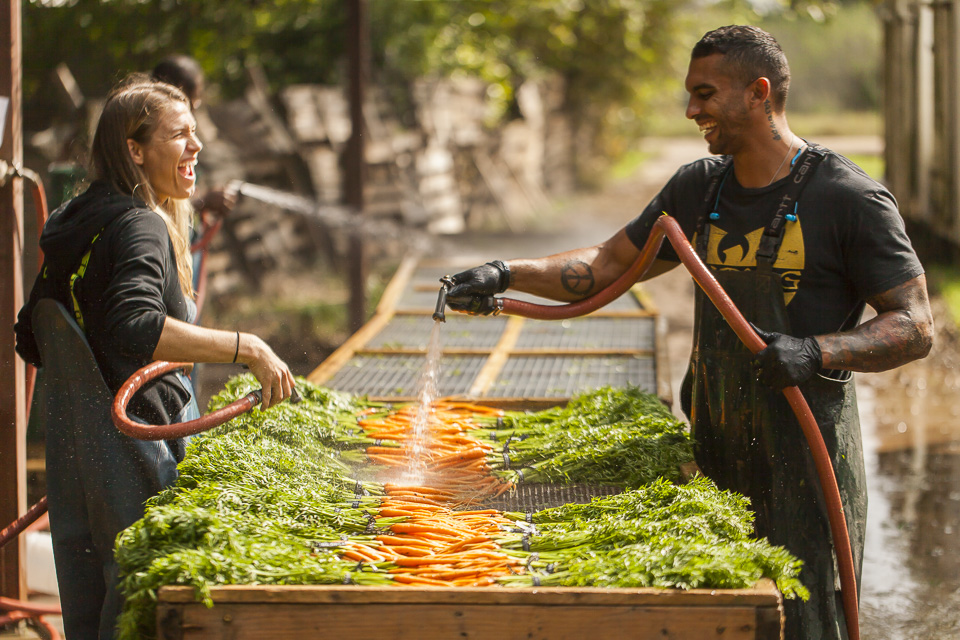 The best in the biz. Photo by Scott David Gordon.
The best in the biz. Photo by Scott David Gordon.
Farm, in general - Funky Chicken Coop Tour in East Austin! This is a self-guided tour that happens Easter weekend here in our fair town that is run by the Urban Poultry Association of Texas. The purpose of this tour is to encourage city residents to raise chickens at home by demonstrating the many ways that chicken (and other poultry) housing can be incorporated into urban residence without violating city ordinances or creating a nuisance. Yeehaw!
 Seru Andromius by Roi James
Seru Andromius by Roi James
Our fabulous photographer, Scott David Gordon, has a great new podcast called Austin Art Talk, where he interviews a different Austin artist every week. The next new episode comes out tomorrow (March 3rd) and is with Roi James. It’s a beautiful and raw conversation about Roi’s struggles accepting his power and path as an artist and what he learned after surviving cancer almost 5 years ago. You can listen from the website, on iTunes, or on any other podcast app. Be sure to subscribe and share!
Lena (Wholesale Crew) - I’ve been really into chef David Chang’s new Netflix show, Ugly Delicious. I’ve never felt more validated in my life than when DAVID CHANG OF MOMOFUKU declares his love for Domino’s after he spends the day eating beautiful artisan pizzas in one of the most celebrated pizzerias in the country. The pizzeria owner is furious- it's hilarious. (Note: Aziz Ansari appears in a couple episodes.)

I’m also in love with Everything Sucks!, another new show on Netflix. As a 90s kid, I’ve always wished I could relive that decade to fully appreciate how much it shaped who I am, and this show does that for me. From now on, I will only introduce myself to new acquaintances by playing a clip of the dad joyfully singing and dancing along to Deep Blue Something’s “Breakfast at Tiffany’s.”
Missoula (Farm Dog) - My baby goat.
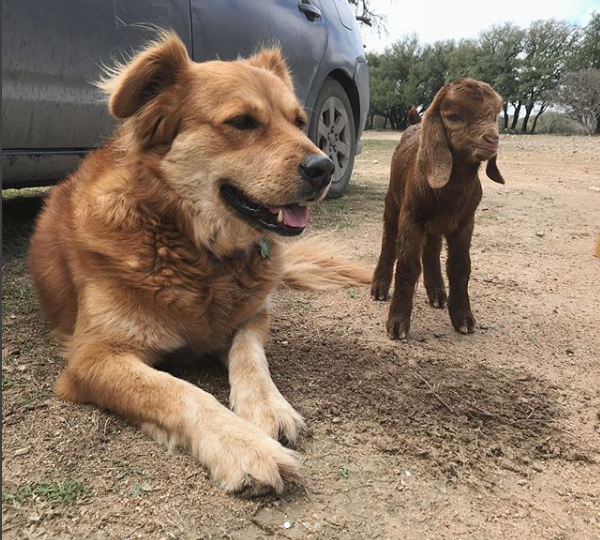
Ada (CSA and Marketing Manager) - I've got the spring fever and have been really busy building up my home garden this season. All the guys at the farm thought I was crazy for planting such a big garden (considering I work for a 200 acre farm), but I've officially caught the bug this year, and have been working by day at my computer, and by evening in my garden. Planning to plant lots of heirloom tomatoes and flowers. If there are any orphan transplants at the end of our Transplant Sale, these might find a home in my yard, too.
Also! I'm getting really excited about our Spring Picnic coming up on Saturday, March 31st. Usually we book some local honky tonk bands, but this year we've decided to go a different direction and are going to have some fabulous blues tunes gracing our stage. Planning an epic "egg" hunt for the kids, and of course we'll have the Gallop through our fields for anyone wanting a unique tour of our farm and vegetable production. Can't wait to have you all out to the farm!
Tracy (Barn Manager) - My daughter Eden Rayne is turning 5 next week and Tiny Tails to You, a local petting zoo to whom we donate some produce to, will be setting up shop in my backyard. I'm really excited to celebrate my awesome daughter! Also, it's about rodeo season, and the Austin Rodeo is one of my favorite events of the year.
 Tracy and his kiddos! Photo by Scott David Gordon.
Tracy and his kiddos! Photo by Scott David Gordon.
My non-pick would be Brenton's footwear decisions this Thursday...

Mike Mo (Wholesale Manager) - I'd like to give a shout out to Marcelino's Pan y Vino. This is my favorite morning taco joint as of late.
Pete (Wholesale Manager) - These insanely delectable chargrilled oysters I made recently. YUM.

Brenton (Head Farmer) - I want to give a call out to The China Family Restaurant on Guadalupe. Good Stuff! Also Mushashino - amazing sushi. Also! I recently went to see Pop Up Magazine's show in Austin, and thought it was amazing! Really unique stories, all told in very cool way. Kinda hard to explain, so you've just gotta go see it next time they're in town. Oh! I can't wait to start mowing my grass.
Fawn (Farmer's Market Manager) - I am excited about my fava beans (top right.) I planted them in October and will hopefully get beans in March, if it doesn't get too warm too fast. It's my first time growing favas. I also planted several varieties of garlic last October, including elephant garlic, that I am patiently watching grow. I've got some dragon tongue beans that have just sprouted (not pictured.) These are delicious and so easy to grow!
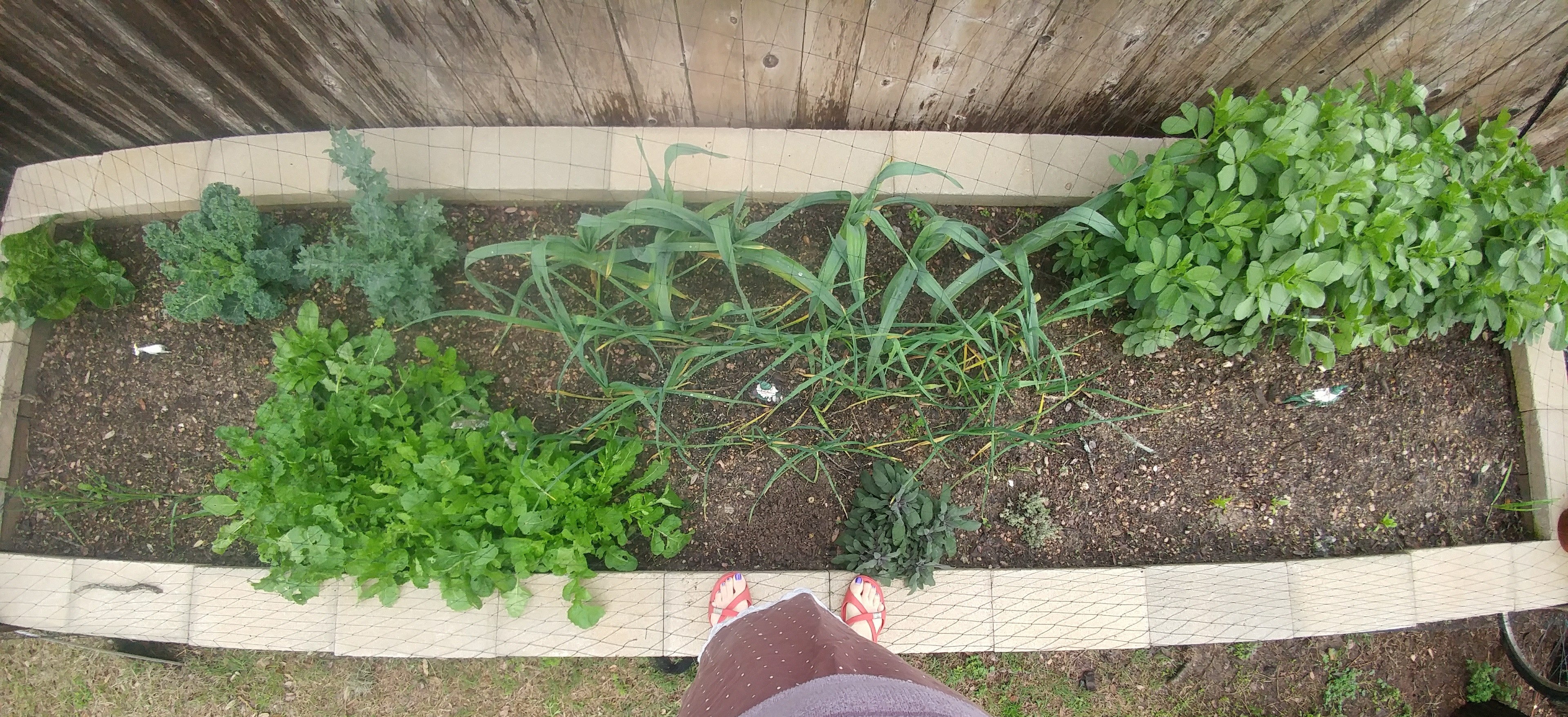 Fawn's garden.
Fawn's garden.
Andrew (CSA Line Manager) - Nikki and I are hyped for "Meow Wolf Outside" during SXSW. Normally I stay away unless one of us is gigging, buuuut... this might be a must. We had so much fun when we went in New Mexico. With Austin during SXSW vibes and some hidden unreleased Shakey Graves cassettes, this is set to be a potent potion to have some fun.
 Andrew at Meow Wolf in NM.
Andrew at Meow Wolf in NM.
Casey (Customer Service Extraordinaire) - I'm enjoying my new carnivorous hanging pitcher plant. I've never cared for a carnivorous plant before, so it is definitely a learning experience. Fruit flies fall into the pitchers where they are digested. You just need to keep a bit of rainwater in each pitcher. It also likes high humidity, daily misting, and full sun. Best in bathrooms or kitchens where there is a lot of moisture in the air (like near the dishwasher). There is a really great short documentary about carnivorous plants to check out called Plants Behaving Badly. I highly recommend it! You will never look at plants the same way again!
If you are interested in buying one of these or other carnivorous plants like the Venus flytrap, head to The Natural Gardener!
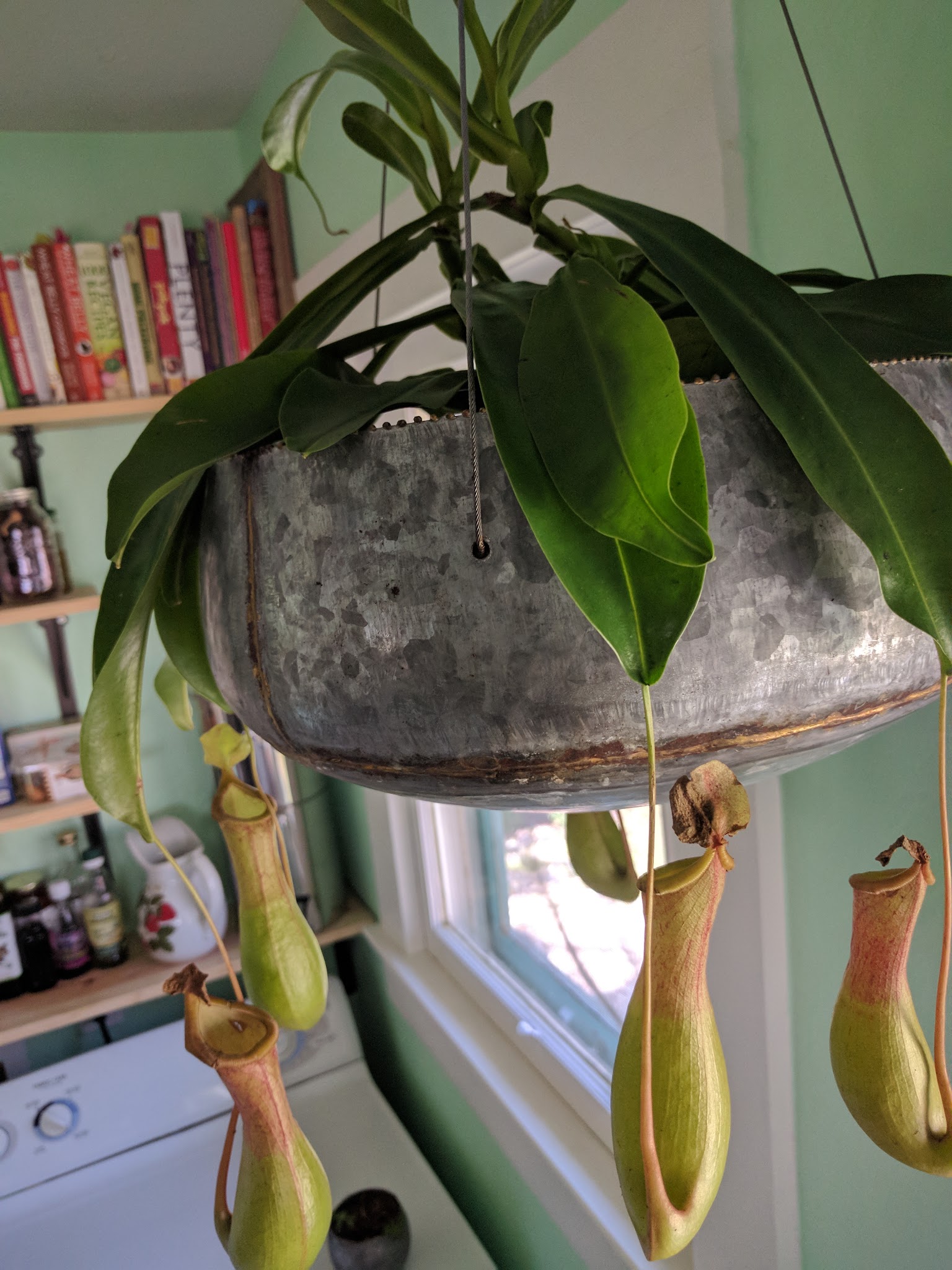 Casey's carnivorous plant.
Casey's carnivorous plant.WEEK 9 IN PHOTOS
03/02/18 — Heydon Hatcher
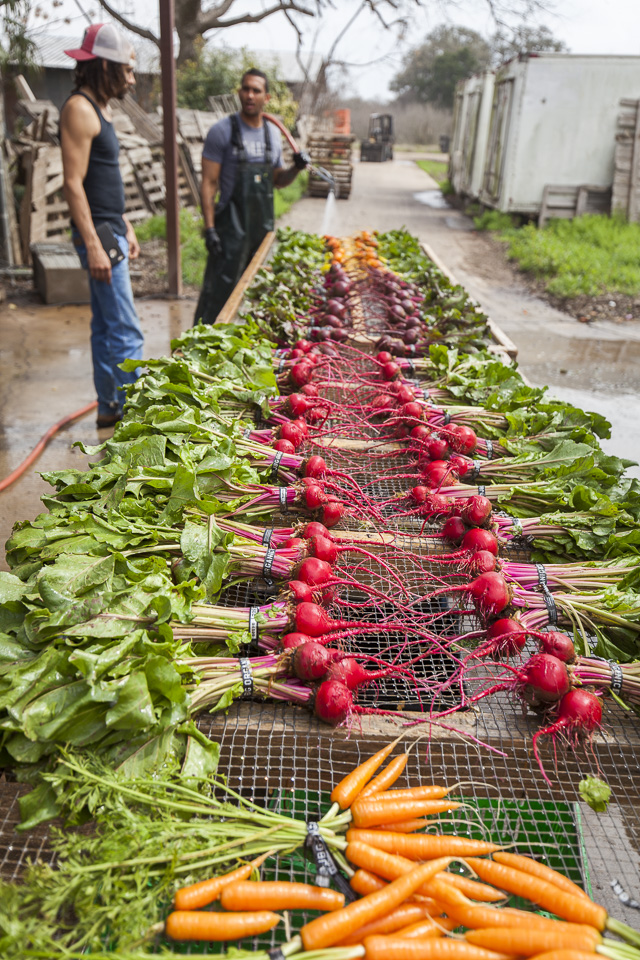 Spraying down beets and carrots. Photo by Scott David Gordon.
Spraying down beets and carrots. Photo by Scott David Gordon.
The first weekend of the transplant sale was incredible! Thanks for coming out and supporting us. The second Saturday of the sale is slated to be even better. Come join us this weekend at the Garfield location to grab your favorite crops for your backyard garden, and also join in on the Gardening Workshop with Becky and Brenton to finetune your horticultural knowledge!
In other farm news, the sun finally peeked out this week after a long hiatus behind the clouds and enabled us to continue spring planting. Yeehaw!
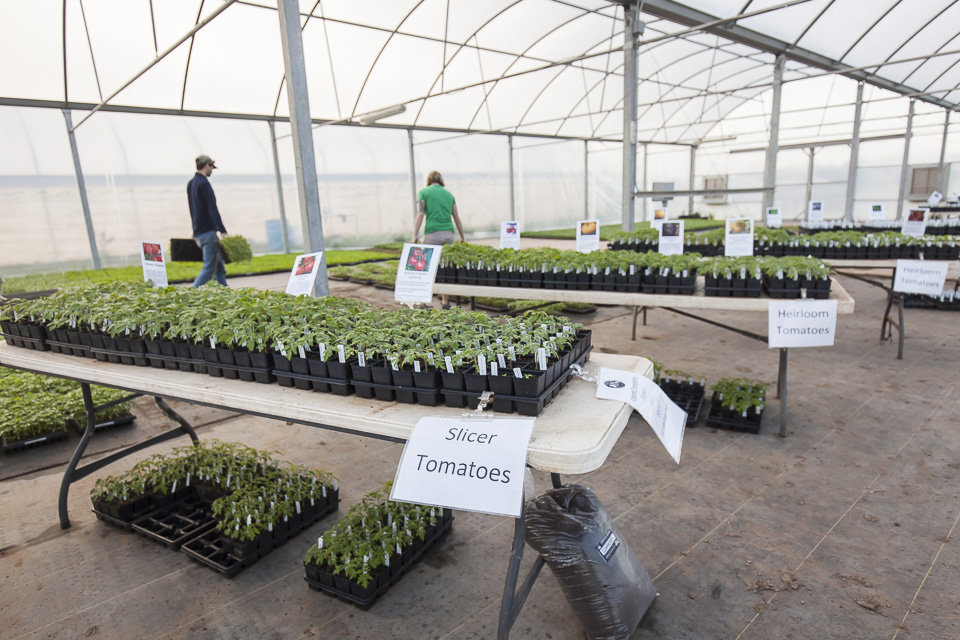 Preparing for the second weekend of the transplant sale. Photo by Scott David Gordon.
Preparing for the second weekend of the transplant sale. Photo by Scott David Gordon.
 Lettuce transplants. Photo by Scott David Gordon.
Lettuce transplants. Photo by Scott David Gordon.
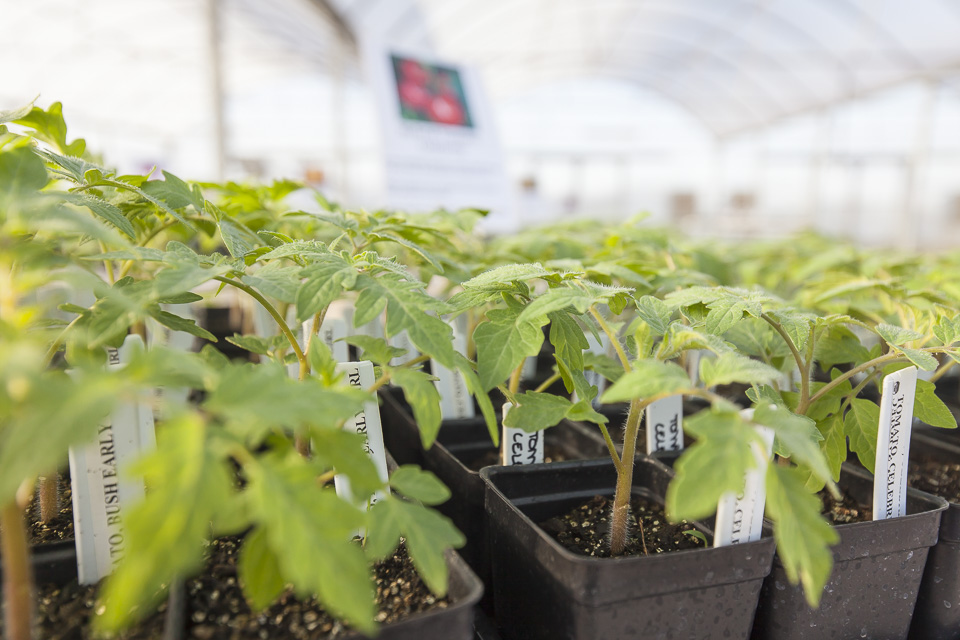 Tomato transplants. Photo by Scott David Gordon.
Tomato transplants. Photo by Scott David Gordon.
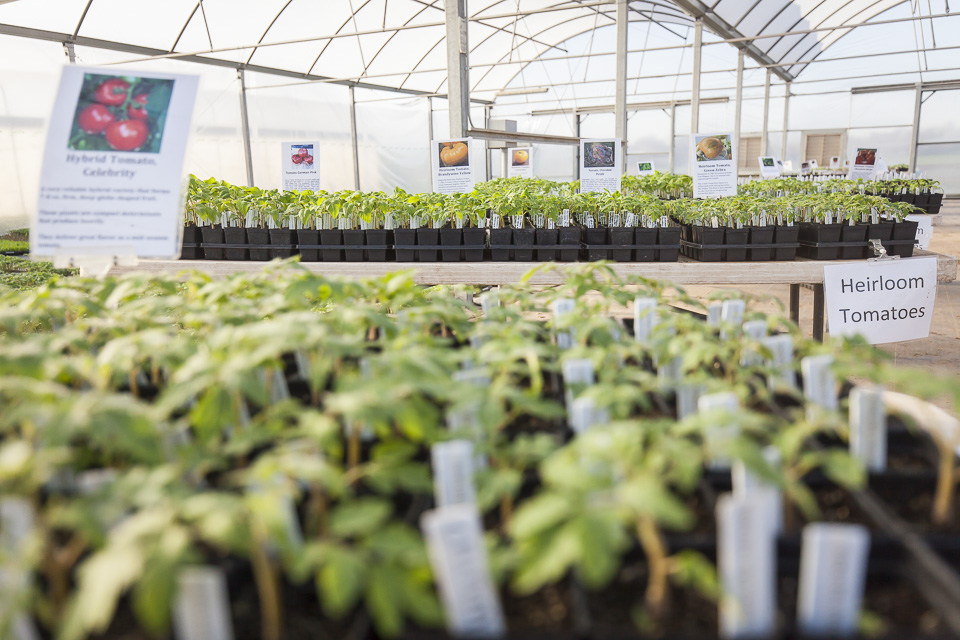 Transplant beauties. Photo by Scott David Gordon.
Transplant beauties. Photo by Scott David Gordon.
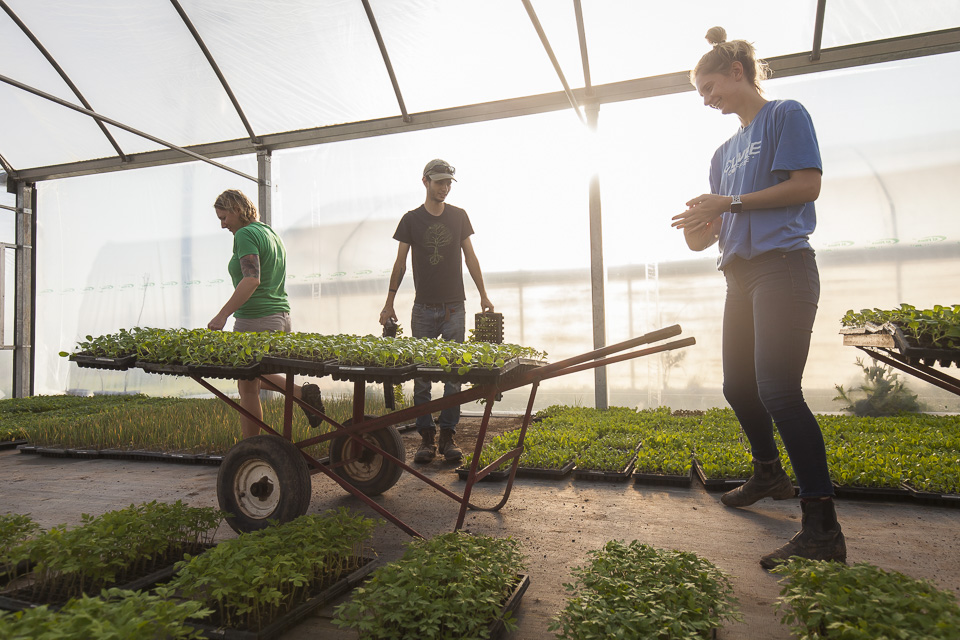 Preparing for the second weekend of the transplant sale. Photo by Scott David Gordon.
Preparing for the second weekend of the transplant sale. Photo by Scott David Gordon.
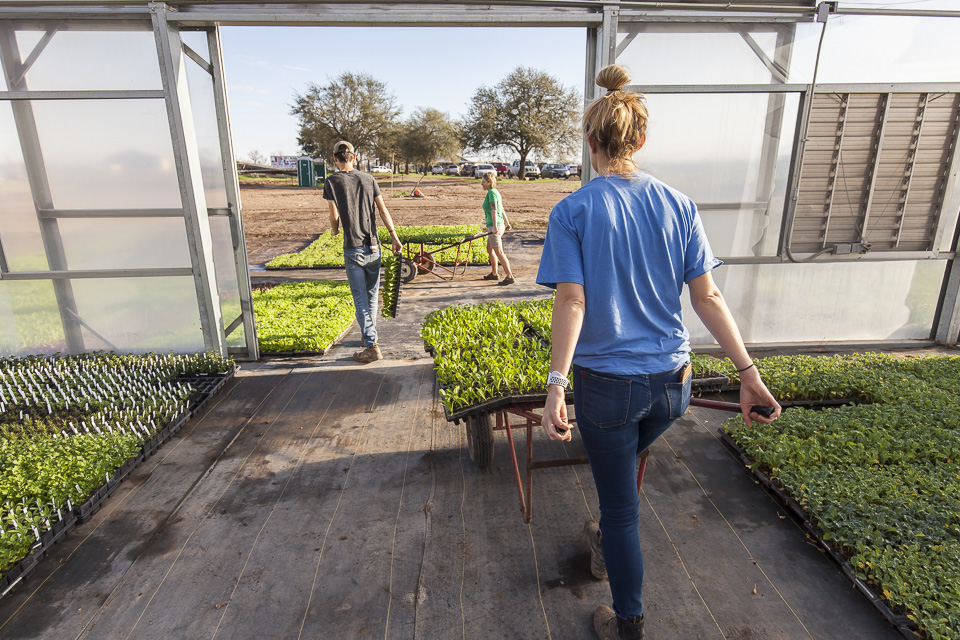 Getting the transplants out into the sun. Photo by Scott David Gordon.
Getting the transplants out into the sun. Photo by Scott David Gordon.
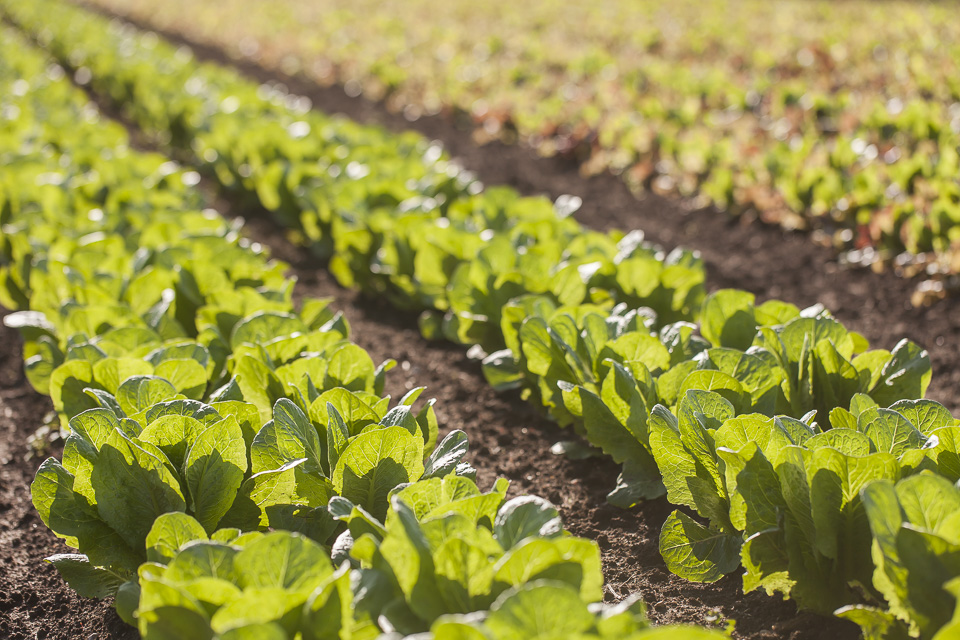 Greens bathing in the sun. Photo by Scott David Gordon.
Greens bathing in the sun. Photo by Scott David Gordon.
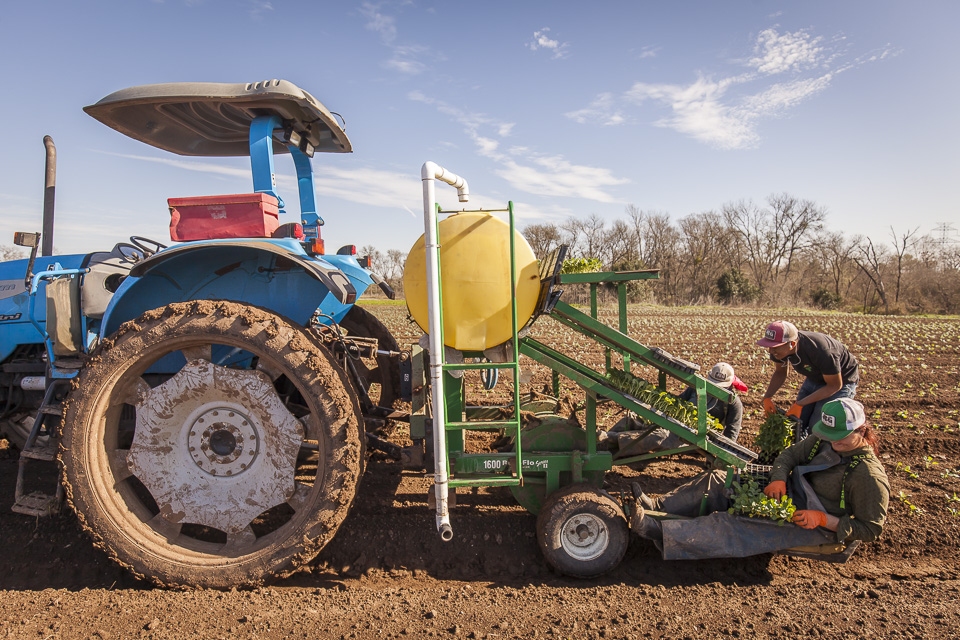 Finally planting again. Photo by Scott David Gordon.
Finally planting again. Photo by Scott David Gordon.
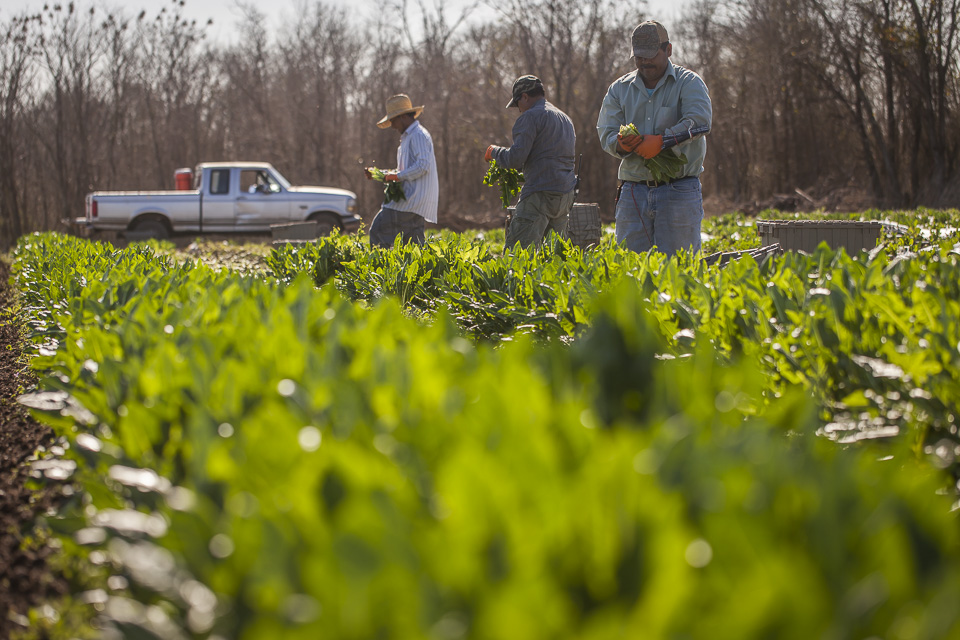 Harvesting greens. Photo by Scott David Gordon.
Harvesting greens. Photo by Scott David Gordon.
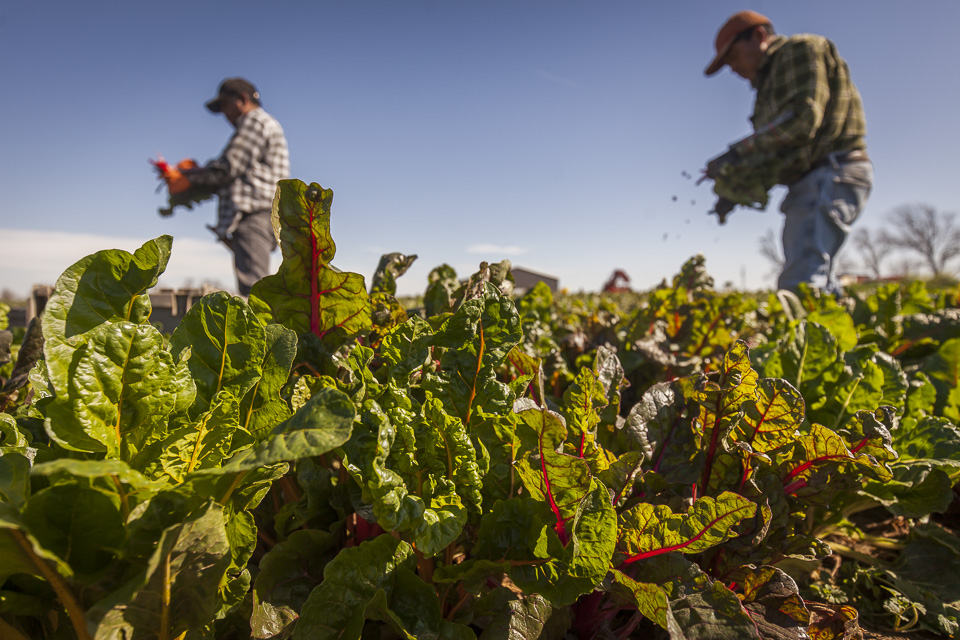 Harvesting chard. Photo by Scott David Gordon.
Harvesting chard. Photo by Scott David Gordon.
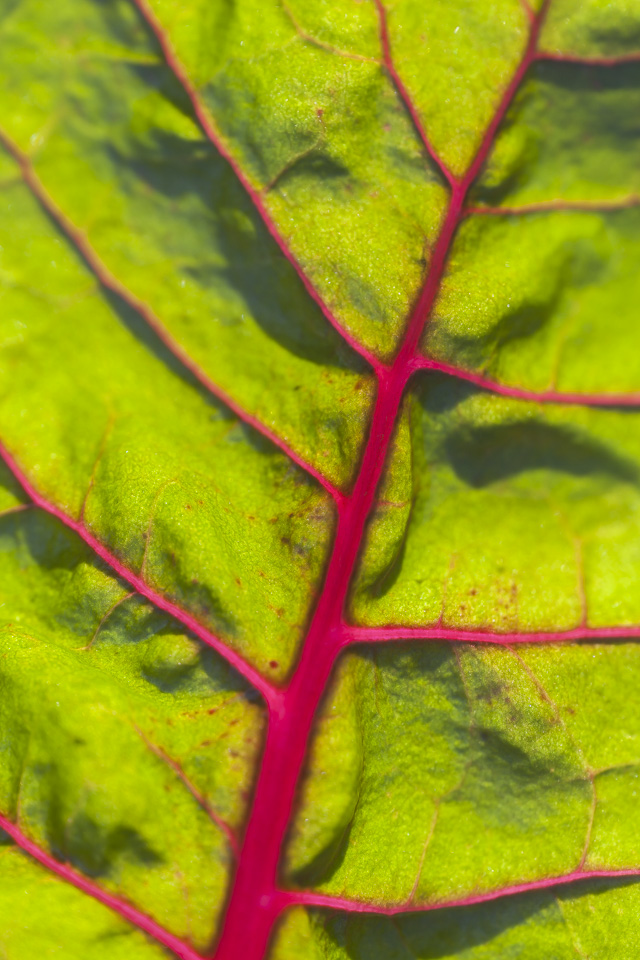 Chard details. Photo by Scott David Gordon.
Chard details. Photo by Scott David Gordon.
EMPLOYEE SPOTLIGHT: BECKY HUME, FARM MANAGER!
03/02/18 — Heydon Hatcher
Time for another installment of one of our most favorite blog series: the Employee Spotlight! We hope that these interviews will help acquaint you with the folks on the farm who are largely responsible for keeping the delicious JBG vegetables rolling out, week after week.
This week, our Farm Manager (and teacher of the Gardening Workshop this weekend. Don't forget to grab a ticket!), Becky Hume, took a minute out of her immensely busy schedule to sit down and elaborate on her role at the farm, her robust agricultural past, and her globe-trotting rearing. For the past year, we have been so very lucky to have such a brilliant and passionate woman leading, innovating, and finetuning operations here at JBG. Get to know this veggie-loving, two-stepping farmer in the interview below!
![]() Becky. Photo by Scott David Gordon.
Becky. Photo by Scott David Gordon.
Where were you born?
I was born in North Carolina, but my family moved overseas to China when I was 8. Then I moved to Thailand when I was 13. Most of my growing up years were spent abroad. I’ve forgotten a lot of my Chinese, but I speak Thai pretty fluently.
What is your current role at JBG?
I’m the farm manager here which means that I’m ultimately responsible for making sure that things run smoothly and that we grow bounties of beautiful vegetables! It was unique that I came into the company as the Manager, but with my ag background, Brenton felt comfortable giving me more reign to make calls about crop planning and strategy. Brenton has been spending more time focusing on development projects and the future of the farm and had passed off most all of the day to day logistics to me. Of course, he is always there if I have questions, but I think now after a year we have a great working relationship and he trusts my calls more and more without getting nervous about what’s going on at the Farm.
What is your farming background?
I got interested in agriculture in a very non-conventional way. No one in my family was agricultural. In high school, when we were living in Thailand. My father did humanitarian aid work and ran free medical clinics in rural parts of Thailand in the Hill tribes. I spent a lot of time with him on his clinics and it was clear to me that most of the health problems were related to the nutrition. So I was like, “Yeah! I wanna learn about agriculture as a 16-year-old girl with no farming experience!” My first ever farming apprenticeship was on a farm in the Philippines that was run by another missionary organization. Some of my parents’ missionary friends had previously worked there, so I ended up on this rural farm in the Philippines... there were only 5 people who spoke English in the entire compound. They focused on getting rural villages off of chemical inputs, teaching them how to manage the fertility of their own soil, and empowering them as communities to be self-sufficient. I absolutely fell in love with it. It was the hardest summer I had ever worked. I was chopping down bamboo and butchering rabbits. Totally stuff that was so non-typical for a 16-year-old girl.
![]() Photo by Scott David Gordon.
Photo by Scott David Gordon.
I decided to study ag in college. I ended up at Iowa State for my first year of college. The wake-up call was huge since my only experience with farming had to do with systems and sustainability. When I got to Iowa as it’s the heartland of agriculture, there were humongous farms of corn and soybeans as far as the eye can see. The first few weeks there were a little overwhelming, but I met an amazing female professor, Mary Weidenhoeft, a thought leader in the agro-ecological field, and she snatched me up as an advisee and totally set me on the track that I am on today. She linked me up with a lot of progressive thinkers in agriculture in Iowa. She really took me under her wing, and I got involved with organic and sustainable ag research at ISU. Despite loving Iowa-- I ended up transferring to Cornell University. I studied in their international agriculture and rural development program. It was really amazing, I really appreciate my time at Cornell. Another really special thing about my time at Cornell was that there was a farm there called Dilmun Hill. It’s a student-run farm through the university. I managed that farm for 2 years. We had about 2 acres of vegetable production and a permaculture site where we were starting to work on some research trials. It was really exciting because I got this really practical, hands-on experience with agriculture as I was also learning about it academically. I would see a pest on a plant and get to go talk to world-class experts about it. I feel incredibly thankful for that experience. Just the experiential without the academic, or vice versa - you are always missing something. Our greenhouse manager, Kirby, is an alumnus from that same farm - he managed it after me!
After Cornell, I was really interested in sustainability and post-academic agriculture. I ended up moving to an intentional community in Scotland, called the Findhorn Foundation. That was a really interesting counterbalance to a really academic perspective on agriculture. The community there has a more spiritual take on ag, they have a lot of emphasis on not only mindfulness but also connecting with the natural world. I was there for about 2 years! They also generate their own electricity and process wastewater, and I apprenticed in green building techniques. It was actually one of the first eco-villages... they kind of coined that phrase.
After that, I jumped around to a bunch of different farms. I dabbled in cut flower production for a while and eventually ended up doing an AmeriCorps program called FoodCorps, which I cannot recommend highly enough. I wish they would come here to Texas. I got placed in a nonprofit in rural Oregon and worked with the communities there to start school gardens and teach nutrition education with local schools. It was another really awesome experience of a totally different kind. I got to work with kids from kindergarten to high school, engaging them with good food while teaching nutrition and cooking. After a year there, I moved to Pennsylvania and worked in a wholesale organic greenhouse before I moved here to Austin. Once I relocated here, I worked at Joe’s Organics which is a micro-green and commercial composting farm and then briefly worked with Aguadulce, an aquaponic start-up here in town. Which brings us to now - it’s been about a year here at JBG!
![]() Photo by Scott David Gordon.
Photo by Scott David Gordon.
What have you learned from your role as farm manager here at JBG?
I’m surprised at how much of the job has been about working with people and not just with plants and the land. Something I love about this farm is that we have such a diverse array of people working here. That’s a really beautiful thing; however, it also creates challenges. There are a lot of different perspectives on how we should work together, how things should be done, and how things should be communicated. I feel like I’ve learned a lot about how to navigate that, and how to be an effective leader/what that really means. Being a leader isn’t always just being the boss, but being a leader is sometimes leading from the bottom, and making things happen. Doing those things that need to be done in order to get the system as a whole moving forward. I’ve really learned a ton about people - making them feel appreciated, getting them truly engaged in their work instead of just being bossed around. That’s kind of the difference between a good and a bad manager, right? A bad manager will just boss you around, when a good manager will make you actually care about what you are doing. Not that I do that perfectly, but it’s definitely my goal. To create a workplace where we can all communicate and feel good about what we are doing.
The other thing that I’ve learned a lot about it prioritization - in a system like this I’m never going to finish my to-do list. I’m never going to get all the things that need to be done, done. It’s been a radical shift in my thinking. What are the most important things and how do we knock them out. Decision-making on the fly is a big part of the bill. A lot of the times I don’t have time to deliberate on situations, and just need to make a decision fast as possible. It’s been a challenge, but also really fun. I definitely feel like I’ve learned a lot. I feel like a better communicator and leader than I was a year ago. I hope in another year, I’ll be even better.
What’s your favorite thing about working on a farm?
I think ultimately it’s about the honesty of it. Every job, you are putting yourself in some sort of system. I really appreciate that farming is a really honest and transparent system. We’re working with the land, harnessing sunshine and nutrients - or alchemizing really, which is immensely magical. Then, turning it into food which is nourishing people. When you look at that system, of course, nothing’s perfect, but overall as a whole, I feel really good about being a part of that system.
![]() Becky at the helm. Photo by Scott David Gordon.
Becky at the helm. Photo by Scott David Gordon.
What do you think that the biggest mistake that beginning farmers and gardeners make?
Honestly, I think the biggest mistake of beginning gardeners is that they want to grow all the sexy vegetables first. Sometimes those are the most difficult to grow. Or they choose these really crazy heirloom varieties that are very difficult to grow... we don’t even grow them here at the farm because they are so difficult. I think baby steps are really important for starters. I always advocate starting with the easiest stuff possible. A turnip, for example, you plant that seed and it grows. Even if it messes up or you can’t get a good bulb out of it, the greens are still edible! There’s no way to completely fail in that endeavor. I like to encourage folks to diversify and start with easier stuff. So they can feel successful and learn about growing and gardening before they move onto the bigger, harder stuff.
What books would you recommend for beginning farmers and gardeners?
Why do you like to teach?
It really comes down to me really loving systems. That’s really the beauty of agriculture for me, closing these loops... everything is one big system. I feel like people in our society are really disconnected from the natural world. I’m not saying that I’m the most connected person ever, but I do like to offer that space for people to engage and understand. I also really enjoy connecting with people. I really loved working and teaching kids at FoodCorps, and also at Findhorn, a big part of my role was when we had guests visit, I would work with them in the garden and teach them about gardening and meditation/mindfulness.
What’s your favorite crop? To grow and to eat?
I just can’t answer that... I feel like the more that I work with vegetables, I get more acquainted with the plant families and their specific personalities. Tomatoes are total divas, and alliums, nothing kills them... they’re so sturdy, slow, and dependable. I really feel like there’s joy and challenges with growing every crop. They’re like my children, I love them all equally. My favorite vegetable to eat is okra. I know it’s a pain to harvest, but there’s something about the sliminess that I LOVE. I’m also a huge fan of the Hakurei turnip. Every part of it is edible, and it’s so sweet + crunchy - I usually just eat it like an apple.
![]()
What made you want to work on a larger farm, and what are the challenges?
Working on this scale, it’s been a lot of hard work, but also really interesting. Having a system this large definitely forces me to think about how to do things more efficiently. Sometimes on small farms, you take twice a long to weed that one bed... in the grand scheme of things you only have a handful of beds, so you don’t have to be that aware of time spent. However, on a farm this big, you really have to be aware of how long everything is taking you. What your input costs are, what your yields are... being on this scale has just made me so much more aware of how a farm functions. It’s forced me to do things more efficiently, both with people and where machinery really makes a difference.
On a smaller farm, you are never going to plant enough sweet potatoes to make it worth it to buy something like a sweet potato planter, but on this scale and the amount we are harvesting, something like a sweet potato planter saves us time and is absolutely worth it. It’s been fun to have certain aspects of the operations be mechanized. We are in this really interesting scale... to small-scale urban farmers, JBG is a giant. To big commercial farms, JBG is small potatoes. We are right in the middle and straddling the line between very small scale and how they tend to function (fewer tractors, more by hand) and commercial farms (massive acreage, growing fewer things, and more mechanization). It’s always interesting to be constantly evaluating where we can act like a bigger farm and mechanize, or a smaller with more diversified crops and do more things by hand.
Why do you think farms like JBG are important?
I’m really proud of what JBG is in the Austin community. It feels great that we have so many CSA members that are depending on us for their weekly vegetables. They are getting local food and connecting to their region and seasons. They are also getting organic food which is more nutrient-dense and generally, much cleaner food. I do think that the role that JBG plays in the community is important, not only just providing food, but also creating a space for people to engage with their food system. I really love that we have events out at the farm and folks bring their family and kids out. Especially with my background in school gardening and nutrition education, I understand how important it is to get kids exposed to farms. Seeing them come out, see, and understand where their food is coming from is huge. A lot of kids don’t know where their food comes from. They get to pull it out of the ground, create meaningful memories, and start a relationship with food. These are habits that will last them the rest of their lives. I’m just happy that there’s that space for the community to engage and understand the food system.
![]() Photo by Scott David Gordon.
Photo by Scott David Gordon.
What are you proudest of at JBG?
The biggest thing that I’m bringing to the farm isn’t a brilliant idea or some innovation, it’s really small things. Having everything organized every day so that people come to work and they are 10 percent more efficient because they aren’t fishing around for all those things. It’s not some big, sweeping architectural change. It’s just trying to make sure that all the managers have good communication, and that just prevents that one accident where we wasted something, or something went wrong. I can’t say that there’s one big thing that I’ve revolutionized... I think it’s just more of a slow, steady input of trying to make things more organized, efficient, and more connected.
What do you wish more people knew about JBG?
We are truly unique as a farm. It is insanely unique that we are so big and so diverse simultaneously. We are actually one of the largest CSAs in the country, and on top of that, the bigger CSAs usually aggregate produce from multiple different farms. We are one of the biggest CSAs that grows all of its produce on one property.
It’s really uncommon to have a farm that does both, super diverse stuff for direct to consumer, farmers market + CSA sales plus a commercial model of selling wholesale to grocery stores, which is what we do. Sometimes it feels insane as the farm manager - both of these models usually warrant very different crop planning. For CSA and direct to consumer, it’s usually smaller scale and super diverse; whereas, with commercial, it’s usually a few crops on a really large scale. Sometimes I feel like I have two jobs since we are doing both. That’s something that’s super unique about JBG that I think a lot of people don’t understand.
Another super notable thing: that we do so much for the school district. It’s not common to have a farm that can supply to entire school districts - it makes me super happy that we can do that.
![]() Photo by Scott David Gordon.
Photo by Scott David Gordon.
What does your life look like off the farm?
I have an amazing life here in Austin. Before moving here, I was living rurally. I always felt like I had to choose between living rurally, being a farmer, and doing this thing that I love, versus living in an urban environment and losing farming. I feel SO lucky that I get to live in one of the coolest, trendiest, world-class cities, and I get to farm at the same time. It really feels like the jackpot. I love that I can really have a life and enjoy culture outside of just farming. I live with two other amazing women who are like my sisters and two of my best friends from college live and work here, too. I have an incredible and supportive boyfriend in the tech world. I come in with a lot of earthy interests and he’s coming in with very different perspective so we balance each other well. Plus, my family recently moved up to Fort Worth, so I feel super rich in Austin with new friends, old friends, and family.
What would people be surprised to learn about you?
I’m a fanatical two-step dancer. Most weekends I’m out at the honky tonk, dancing. I’m usually at the White Horse or Sam’s Town Point these days. I really love to dance.
What are you cooking up in your kitchen these days?
I like to cook a lot of Asian inspired food. I learned how to cook Thai food growing up in Thailand. Curries and Thai-inspired dishes. My boyfriend is actually from India, so I’ve been trying to incorporate more of those Indian spices and making more Indian curries. I’m a huge meat lover, so I love to cook roasts and steaks, too.
If you were stuck on a desert island, what three things would you bring?
Rationally?
Whimsically?
Casey: I would say a carrot. Strong, dependable, and sweet. They both keeps the farm going!
Krishna: Daikon. I think she has to be bold and put a foot down with all the guys working at the farm.
A huge thanks to Becky for her constant hard work and for chatting with us! Be sure to come and see us this weekend at the Transplant Sale and learn gardening pro-tips at the Gardening Workshop from the master herself, Becky! Get your tickets here!
This week, our Farm Manager (and teacher of the Gardening Workshop this weekend. Don't forget to grab a ticket!), Becky Hume, took a minute out of her immensely busy schedule to sit down and elaborate on her role at the farm, her robust agricultural past, and her globe-trotting rearing. For the past year, we have been so very lucky to have such a brilliant and passionate woman leading, innovating, and finetuning operations here at JBG. Get to know this veggie-loving, two-stepping farmer in the interview below!
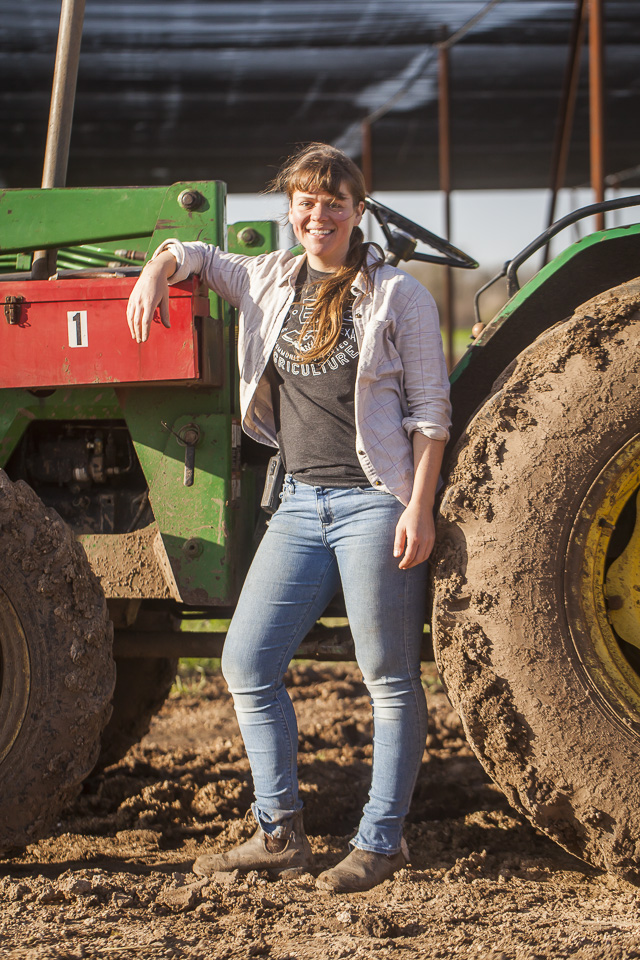 Becky. Photo by Scott David Gordon.
Becky. Photo by Scott David Gordon.
Where were you born?
I was born in North Carolina, but my family moved overseas to China when I was 8. Then I moved to Thailand when I was 13. Most of my growing up years were spent abroad. I’ve forgotten a lot of my Chinese, but I speak Thai pretty fluently.
What is your current role at JBG?
I’m the farm manager here which means that I’m ultimately responsible for making sure that things run smoothly and that we grow bounties of beautiful vegetables! It was unique that I came into the company as the Manager, but with my ag background, Brenton felt comfortable giving me more reign to make calls about crop planning and strategy. Brenton has been spending more time focusing on development projects and the future of the farm and had passed off most all of the day to day logistics to me. Of course, he is always there if I have questions, but I think now after a year we have a great working relationship and he trusts my calls more and more without getting nervous about what’s going on at the Farm.
What is your farming background?
I got interested in agriculture in a very non-conventional way. No one in my family was agricultural. In high school, when we were living in Thailand. My father did humanitarian aid work and ran free medical clinics in rural parts of Thailand in the Hill tribes. I spent a lot of time with him on his clinics and it was clear to me that most of the health problems were related to the nutrition. So I was like, “Yeah! I wanna learn about agriculture as a 16-year-old girl with no farming experience!” My first ever farming apprenticeship was on a farm in the Philippines that was run by another missionary organization. Some of my parents’ missionary friends had previously worked there, so I ended up on this rural farm in the Philippines... there were only 5 people who spoke English in the entire compound. They focused on getting rural villages off of chemical inputs, teaching them how to manage the fertility of their own soil, and empowering them as communities to be self-sufficient. I absolutely fell in love with it. It was the hardest summer I had ever worked. I was chopping down bamboo and butchering rabbits. Totally stuff that was so non-typical for a 16-year-old girl.
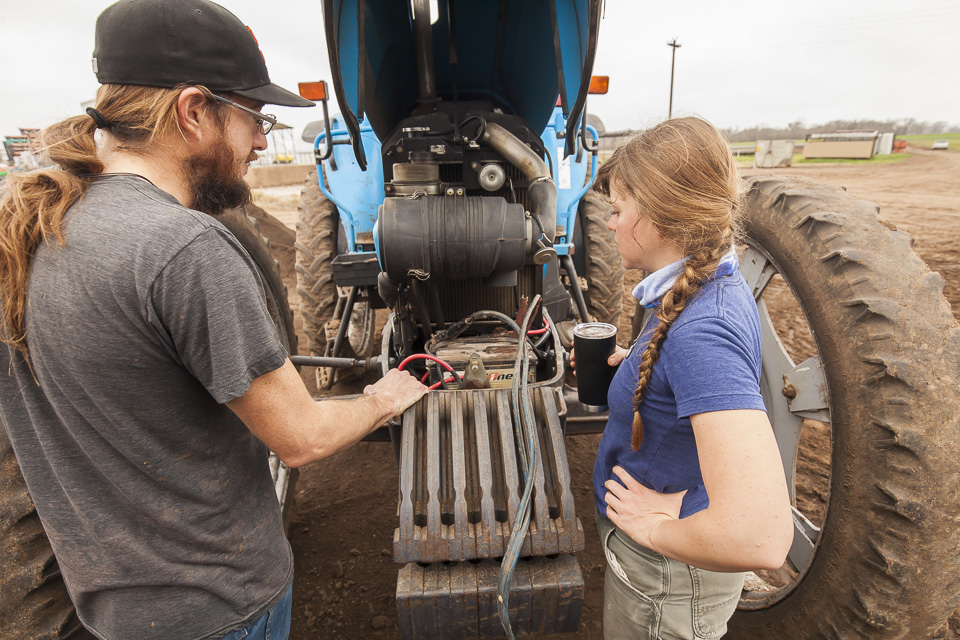 Photo by Scott David Gordon.
Photo by Scott David Gordon.
I decided to study ag in college. I ended up at Iowa State for my first year of college. The wake-up call was huge since my only experience with farming had to do with systems and sustainability. When I got to Iowa as it’s the heartland of agriculture, there were humongous farms of corn and soybeans as far as the eye can see. The first few weeks there were a little overwhelming, but I met an amazing female professor, Mary Weidenhoeft, a thought leader in the agro-ecological field, and she snatched me up as an advisee and totally set me on the track that I am on today. She linked me up with a lot of progressive thinkers in agriculture in Iowa. She really took me under her wing, and I got involved with organic and sustainable ag research at ISU. Despite loving Iowa-- I ended up transferring to Cornell University. I studied in their international agriculture and rural development program. It was really amazing, I really appreciate my time at Cornell. Another really special thing about my time at Cornell was that there was a farm there called Dilmun Hill. It’s a student-run farm through the university. I managed that farm for 2 years. We had about 2 acres of vegetable production and a permaculture site where we were starting to work on some research trials. It was really exciting because I got this really practical, hands-on experience with agriculture as I was also learning about it academically. I would see a pest on a plant and get to go talk to world-class experts about it. I feel incredibly thankful for that experience. Just the experiential without the academic, or vice versa - you are always missing something. Our greenhouse manager, Kirby, is an alumnus from that same farm - he managed it after me!
After Cornell, I was really interested in sustainability and post-academic agriculture. I ended up moving to an intentional community in Scotland, called the Findhorn Foundation. That was a really interesting counterbalance to a really academic perspective on agriculture. The community there has a more spiritual take on ag, they have a lot of emphasis on not only mindfulness but also connecting with the natural world. I was there for about 2 years! They also generate their own electricity and process wastewater, and I apprenticed in green building techniques. It was actually one of the first eco-villages... they kind of coined that phrase.
After that, I jumped around to a bunch of different farms. I dabbled in cut flower production for a while and eventually ended up doing an AmeriCorps program called FoodCorps, which I cannot recommend highly enough. I wish they would come here to Texas. I got placed in a nonprofit in rural Oregon and worked with the communities there to start school gardens and teach nutrition education with local schools. It was another really awesome experience of a totally different kind. I got to work with kids from kindergarten to high school, engaging them with good food while teaching nutrition and cooking. After a year there, I moved to Pennsylvania and worked in a wholesale organic greenhouse before I moved here to Austin. Once I relocated here, I worked at Joe’s Organics which is a micro-green and commercial composting farm and then briefly worked with Aguadulce, an aquaponic start-up here in town. Which brings us to now - it’s been about a year here at JBG!
 Photo by Scott David Gordon.
Photo by Scott David Gordon.
What have you learned from your role as farm manager here at JBG?
I’m surprised at how much of the job has been about working with people and not just with plants and the land. Something I love about this farm is that we have such a diverse array of people working here. That’s a really beautiful thing; however, it also creates challenges. There are a lot of different perspectives on how we should work together, how things should be done, and how things should be communicated. I feel like I’ve learned a lot about how to navigate that, and how to be an effective leader/what that really means. Being a leader isn’t always just being the boss, but being a leader is sometimes leading from the bottom, and making things happen. Doing those things that need to be done in order to get the system as a whole moving forward. I’ve really learned a ton about people - making them feel appreciated, getting them truly engaged in their work instead of just being bossed around. That’s kind of the difference between a good and a bad manager, right? A bad manager will just boss you around, when a good manager will make you actually care about what you are doing. Not that I do that perfectly, but it’s definitely my goal. To create a workplace where we can all communicate and feel good about what we are doing.
The other thing that I’ve learned a lot about it prioritization - in a system like this I’m never going to finish my to-do list. I’m never going to get all the things that need to be done, done. It’s been a radical shift in my thinking. What are the most important things and how do we knock them out. Decision-making on the fly is a big part of the bill. A lot of the times I don’t have time to deliberate on situations, and just need to make a decision fast as possible. It’s been a challenge, but also really fun. I definitely feel like I’ve learned a lot. I feel like a better communicator and leader than I was a year ago. I hope in another year, I’ll be even better.
What’s your favorite thing about working on a farm?
I think ultimately it’s about the honesty of it. Every job, you are putting yourself in some sort of system. I really appreciate that farming is a really honest and transparent system. We’re working with the land, harnessing sunshine and nutrients - or alchemizing really, which is immensely magical. Then, turning it into food which is nourishing people. When you look at that system, of course, nothing’s perfect, but overall as a whole, I feel really good about being a part of that system.
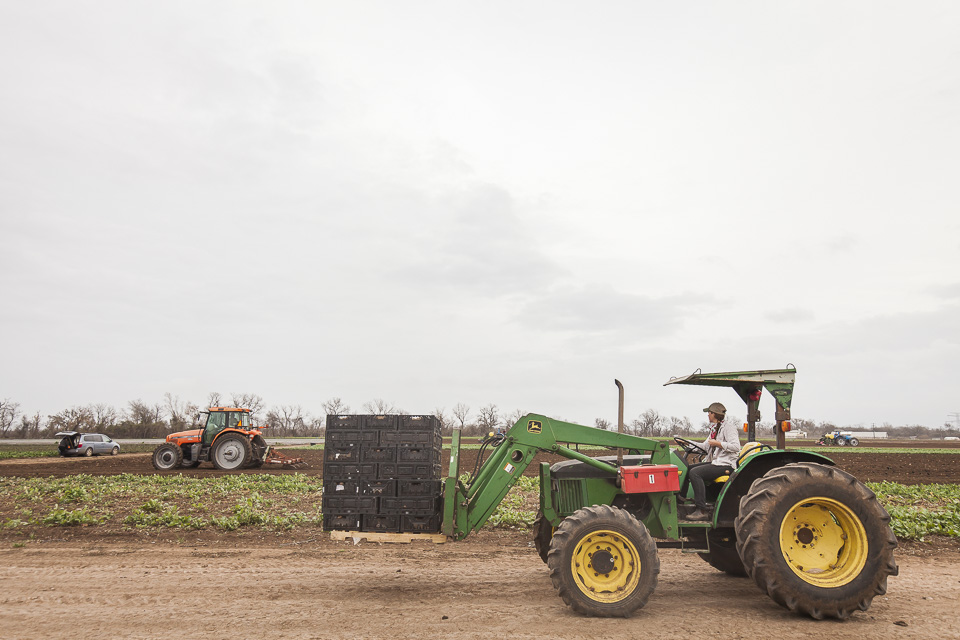 Becky at the helm. Photo by Scott David Gordon.
Becky at the helm. Photo by Scott David Gordon.
What do you think that the biggest mistake that beginning farmers and gardeners make?
Honestly, I think the biggest mistake of beginning gardeners is that they want to grow all the sexy vegetables first. Sometimes those are the most difficult to grow. Or they choose these really crazy heirloom varieties that are very difficult to grow... we don’t even grow them here at the farm because they are so difficult. I think baby steps are really important for starters. I always advocate starting with the easiest stuff possible. A turnip, for example, you plant that seed and it grows. Even if it messes up or you can’t get a good bulb out of it, the greens are still edible! There’s no way to completely fail in that endeavor. I like to encourage folks to diversify and start with easier stuff. So they can feel successful and learn about growing and gardening before they move onto the bigger, harder stuff.
What books would you recommend for beginning farmers and gardeners?
- Sustainable Vegetable Production from Start-Up to Market by Vernon P Grubinger
- Knott’s Handbook for Vegetable Growers by Donald N Maynard & George J Hochmuth
Why do you like to teach?
It really comes down to me really loving systems. That’s really the beauty of agriculture for me, closing these loops... everything is one big system. I feel like people in our society are really disconnected from the natural world. I’m not saying that I’m the most connected person ever, but I do like to offer that space for people to engage and understand. I also really enjoy connecting with people. I really loved working and teaching kids at FoodCorps, and also at Findhorn, a big part of my role was when we had guests visit, I would work with them in the garden and teach them about gardening and meditation/mindfulness.
What’s your favorite crop? To grow and to eat?
I just can’t answer that... I feel like the more that I work with vegetables, I get more acquainted with the plant families and their specific personalities. Tomatoes are total divas, and alliums, nothing kills them... they’re so sturdy, slow, and dependable. I really feel like there’s joy and challenges with growing every crop. They’re like my children, I love them all equally. My favorite vegetable to eat is okra. I know it’s a pain to harvest, but there’s something about the sliminess that I LOVE. I’m also a huge fan of the Hakurei turnip. Every part of it is edible, and it’s so sweet + crunchy - I usually just eat it like an apple.
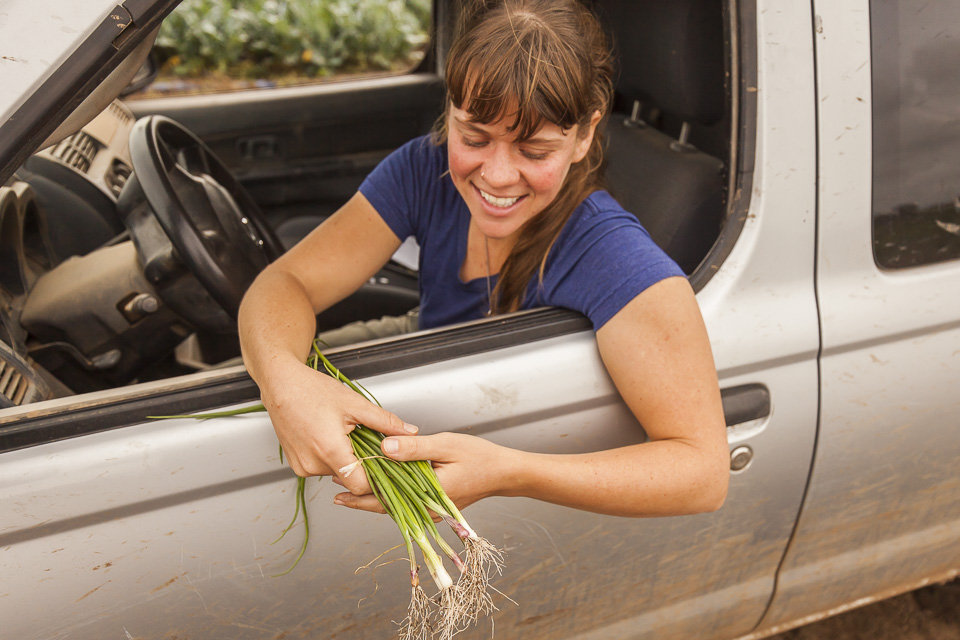
What made you want to work on a larger farm, and what are the challenges?
Working on this scale, it’s been a lot of hard work, but also really interesting. Having a system this large definitely forces me to think about how to do things more efficiently. Sometimes on small farms, you take twice a long to weed that one bed... in the grand scheme of things you only have a handful of beds, so you don’t have to be that aware of time spent. However, on a farm this big, you really have to be aware of how long everything is taking you. What your input costs are, what your yields are... being on this scale has just made me so much more aware of how a farm functions. It’s forced me to do things more efficiently, both with people and where machinery really makes a difference.
On a smaller farm, you are never going to plant enough sweet potatoes to make it worth it to buy something like a sweet potato planter, but on this scale and the amount we are harvesting, something like a sweet potato planter saves us time and is absolutely worth it. It’s been fun to have certain aspects of the operations be mechanized. We are in this really interesting scale... to small-scale urban farmers, JBG is a giant. To big commercial farms, JBG is small potatoes. We are right in the middle and straddling the line between very small scale and how they tend to function (fewer tractors, more by hand) and commercial farms (massive acreage, growing fewer things, and more mechanization). It’s always interesting to be constantly evaluating where we can act like a bigger farm and mechanize, or a smaller with more diversified crops and do more things by hand.
Why do you think farms like JBG are important?
I’m really proud of what JBG is in the Austin community. It feels great that we have so many CSA members that are depending on us for their weekly vegetables. They are getting local food and connecting to their region and seasons. They are also getting organic food which is more nutrient-dense and generally, much cleaner food. I do think that the role that JBG plays in the community is important, not only just providing food, but also creating a space for people to engage with their food system. I really love that we have events out at the farm and folks bring their family and kids out. Especially with my background in school gardening and nutrition education, I understand how important it is to get kids exposed to farms. Seeing them come out, see, and understand where their food is coming from is huge. A lot of kids don’t know where their food comes from. They get to pull it out of the ground, create meaningful memories, and start a relationship with food. These are habits that will last them the rest of their lives. I’m just happy that there’s that space for the community to engage and understand the food system.
 Photo by Scott David Gordon.
Photo by Scott David Gordon.
What are you proudest of at JBG?
The biggest thing that I’m bringing to the farm isn’t a brilliant idea or some innovation, it’s really small things. Having everything organized every day so that people come to work and they are 10 percent more efficient because they aren’t fishing around for all those things. It’s not some big, sweeping architectural change. It’s just trying to make sure that all the managers have good communication, and that just prevents that one accident where we wasted something, or something went wrong. I can’t say that there’s one big thing that I’ve revolutionized... I think it’s just more of a slow, steady input of trying to make things more organized, efficient, and more connected.
What do you wish more people knew about JBG?
We are truly unique as a farm. It is insanely unique that we are so big and so diverse simultaneously. We are actually one of the largest CSAs in the country, and on top of that, the bigger CSAs usually aggregate produce from multiple different farms. We are one of the biggest CSAs that grows all of its produce on one property.
It’s really uncommon to have a farm that does both, super diverse stuff for direct to consumer, farmers market + CSA sales plus a commercial model of selling wholesale to grocery stores, which is what we do. Sometimes it feels insane as the farm manager - both of these models usually warrant very different crop planning. For CSA and direct to consumer, it’s usually smaller scale and super diverse; whereas, with commercial, it’s usually a few crops on a really large scale. Sometimes I feel like I have two jobs since we are doing both. That’s something that’s super unique about JBG that I think a lot of people don’t understand.
Another super notable thing: that we do so much for the school district. It’s not common to have a farm that can supply to entire school districts - it makes me super happy that we can do that.
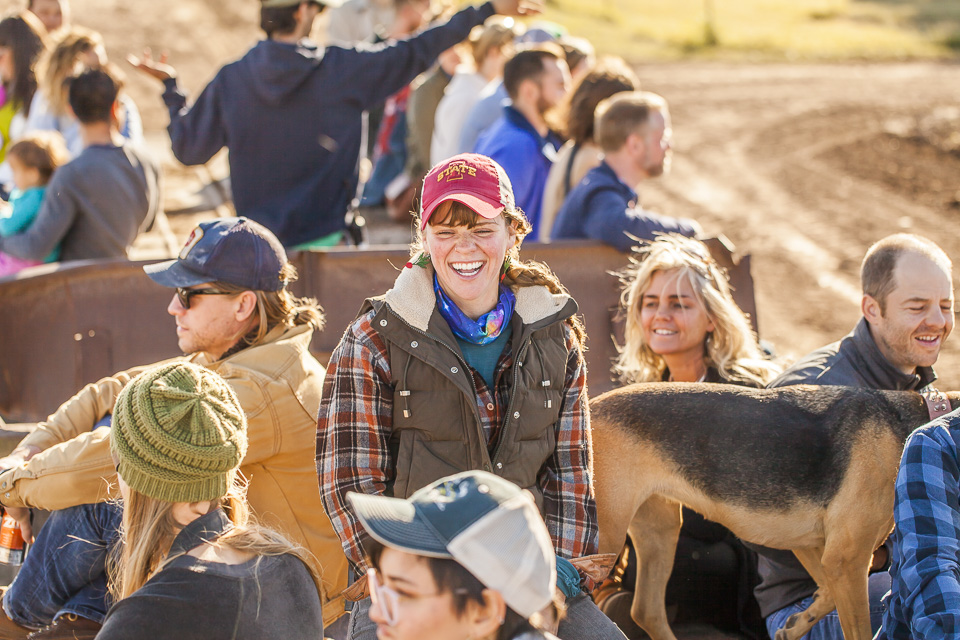 Photo by Scott David Gordon.
Photo by Scott David Gordon.
What does your life look like off the farm?
I have an amazing life here in Austin. Before moving here, I was living rurally. I always felt like I had to choose between living rurally, being a farmer, and doing this thing that I love, versus living in an urban environment and losing farming. I feel SO lucky that I get to live in one of the coolest, trendiest, world-class cities, and I get to farm at the same time. It really feels like the jackpot. I love that I can really have a life and enjoy culture outside of just farming. I live with two other amazing women who are like my sisters and two of my best friends from college live and work here, too. I have an incredible and supportive boyfriend in the tech world. I come in with a lot of earthy interests and he’s coming in with very different perspective so we balance each other well. Plus, my family recently moved up to Fort Worth, so I feel super rich in Austin with new friends, old friends, and family.
What would people be surprised to learn about you?
I’m a fanatical two-step dancer. Most weekends I’m out at the honky tonk, dancing. I’m usually at the White Horse or Sam’s Town Point these days. I really love to dance.
What are you cooking up in your kitchen these days?
I like to cook a lot of Asian inspired food. I learned how to cook Thai food growing up in Thailand. Curries and Thai-inspired dishes. My boyfriend is actually from India, so I’ve been trying to incorporate more of those Indian spices and making more Indian curries. I’m a huge meat lover, so I love to cook roasts and steaks, too.
If you were stuck on a desert island, what three things would you bring?
Rationally?
- A pocket knife
- A tarp
- 55-gallon barrel for water storage
Whimsically?
- Amazing speaker set up
- My cat
- My kitchen
Casey: I would say a carrot. Strong, dependable, and sweet. They both keeps the farm going!
Krishna: Daikon. I think she has to be bold and put a foot down with all the guys working at the farm.
A huge thanks to Becky for her constant hard work and for chatting with us! Be sure to come and see us this weekend at the Transplant Sale and learn gardening pro-tips at the Gardening Workshop from the master herself, Becky! Get your tickets here!
CSA BOX CONTENTS WEEK OF MARCH 5TH
03/06/18 — Scott
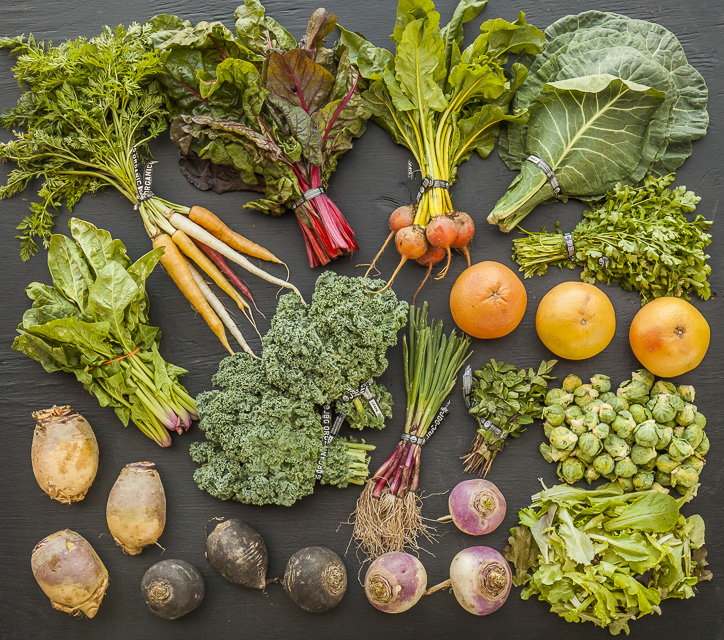 CSA Box Contents Week of March 5th
CSA Box Contents Week of March 5th
Large Box
Beet, Chioggia
Carrot, Orange
Citrus, Mixed
Greens, Collards
Greens, Dandelion
Greens, Spinach
Herb, Parsley, Flat
Leek
Lettuce, Romaine
Onion, Spring Yellow
Radish, French Breakfast
Beet, Chioggia
Carrot, Orange
Citrus, Mixed
Greens, Collards
Greens, Dandelion
Greens, Spinach
Herb, Parsley, Flat
Leek
Lettuce, Romaine
Onion, Spring Yellow
Radish, French Breakfast
Medium Box
Beet, Golden
Carrot, Orange
Citrus, Mixed
Greens, Dandelion
Greens, Kale, Curly
Herb, Spearmint
Lettuce, Romaine
Onion, Spring Yellow
Radish, Watermelon
Beet, Golden
Carrot, Orange
Citrus, Mixed
Greens, Dandelion
Greens, Kale, Curly
Herb, Spearmint
Lettuce, Romaine
Onion, Spring Yellow
Radish, Watermelon
Small Box
Beet, Chioggia
Carrot, Orange
Greens, Chard, Rainbow
Greens, Kale, Curly
Greens, Salad Mix
Greens, Spinach
Onion, Spring Yellow
Beet, Chioggia
Carrot, Orange
Greens, Chard, Rainbow
Greens, Kale, Curly
Greens, Salad Mix
Greens, Spinach
Onion, Spring Yellow
Individual Box
Beet, Red
Carrot, Orange
Greens, Collards
Greens, Salad Mix
Radish, Purple Daikon
Beet, Red
Carrot, Orange
Greens, Collards
Greens, Salad Mix
Radish, Purple Daikon
CSA BOX CONTENTS WEEK OF MARCH 5TH
03/06/18 — Scott
 CSA Box Contents Week of March 5th
CSA Box Contents Week of March 5th
Large Box
Beet, Golden
Brussels Sprouts
Carrot, Rainbow
Citrus, Grapefruit
Greens, Chard, Rainbow
Greens, Collards
Greens, Kale, Curly
Greens, Salad Mix
Herb, Cilantro
Herb, Spearmint
Radish, Black Spanish
Turnip, Purple Top
RED CHARD - TWO WAYS
03/08/18 — Heydon Hatcher
Recipe and Photos by Nadia Tamby
Chard is one of my favorite leafy greens – it cooks up in minutes and both the stems and leaves are tender and the red-ribbed leaves and stalks are so beautiful! It has a delicate but slightly bitter flavor – cooked it has a similar texture to spinach. I like making chard either as a side dish or a weekend brunch served with a 6-minute soft-boiled egg and a piece of toast (and a few mimosas). I had a large bunch of chard this week so I decided to split into two different dishes.
Ingredients:![]()
Instructions:
You will want to chop the stalks and cook those with the garlic as they take a little more time than the leaves. Keep the stalks and garlic separate and roughly chop the leaves.
Heat the olive oil up in a skillet on medium heat. Add the sliced garlic and chopped red chard stalks and sauté until softened and the garlic is lightly browned. Add the dried cranberries and fry until they sizzle and inflate a bit. Then add the greens and toss until they have slightly wilted but are still a vibrant green. Add a splash (about a tablespoon if you need to measure) of apple cider vinegar and turn off the heat. The greens will wilt a little more – season with salt and pepper and serve immediately.
Ingredients:![]()
Instructions:
Boil the potatoes until tender. If you are serving this with an egg, remember that you can add the egg to the boiling pot with the potatoes – just be sure to set a timer! I like to drop an egg into the water just before it comes to a rolling boil (so it doesn’t get knocked on the side and leak into the water) and set a timer for 6 minutes. Immediately rinse the egg under cold water or drop it into an ice bath. You should have an egg with runny yolk but a stable white (thus easy to peel).
Drain the potatoes once tender. Heat the olive oil up in a skillet on medium heat. Add the potatoes and let them brown. You can even smash a few of them with the back of a spoon or spatula to vary the texture. Add the roughly chopped Kalamata olives and let them sizzle in the oil and dry out a little. Add the red chard greens, salt and pepper, and serve with the soft-boiled egg.
Chard is one of my favorite leafy greens – it cooks up in minutes and both the stems and leaves are tender and the red-ribbed leaves and stalks are so beautiful! It has a delicate but slightly bitter flavor – cooked it has a similar texture to spinach. I like making chard either as a side dish or a weekend brunch served with a 6-minute soft-boiled egg and a piece of toast (and a few mimosas). I had a large bunch of chard this week so I decided to split into two different dishes.
Red Chard with Garlic, Cranberries, and Apple Cider Vinegar
Ingredients:
- 2 tablespoons olive oil
- 3 cloves garlic, sliced
- 1 small bunch red chard, washed, trimmed and stalks cut just below the leaves
- 3 tablespoons dried cranberries or raisins
- A splash of apple cider vinegar
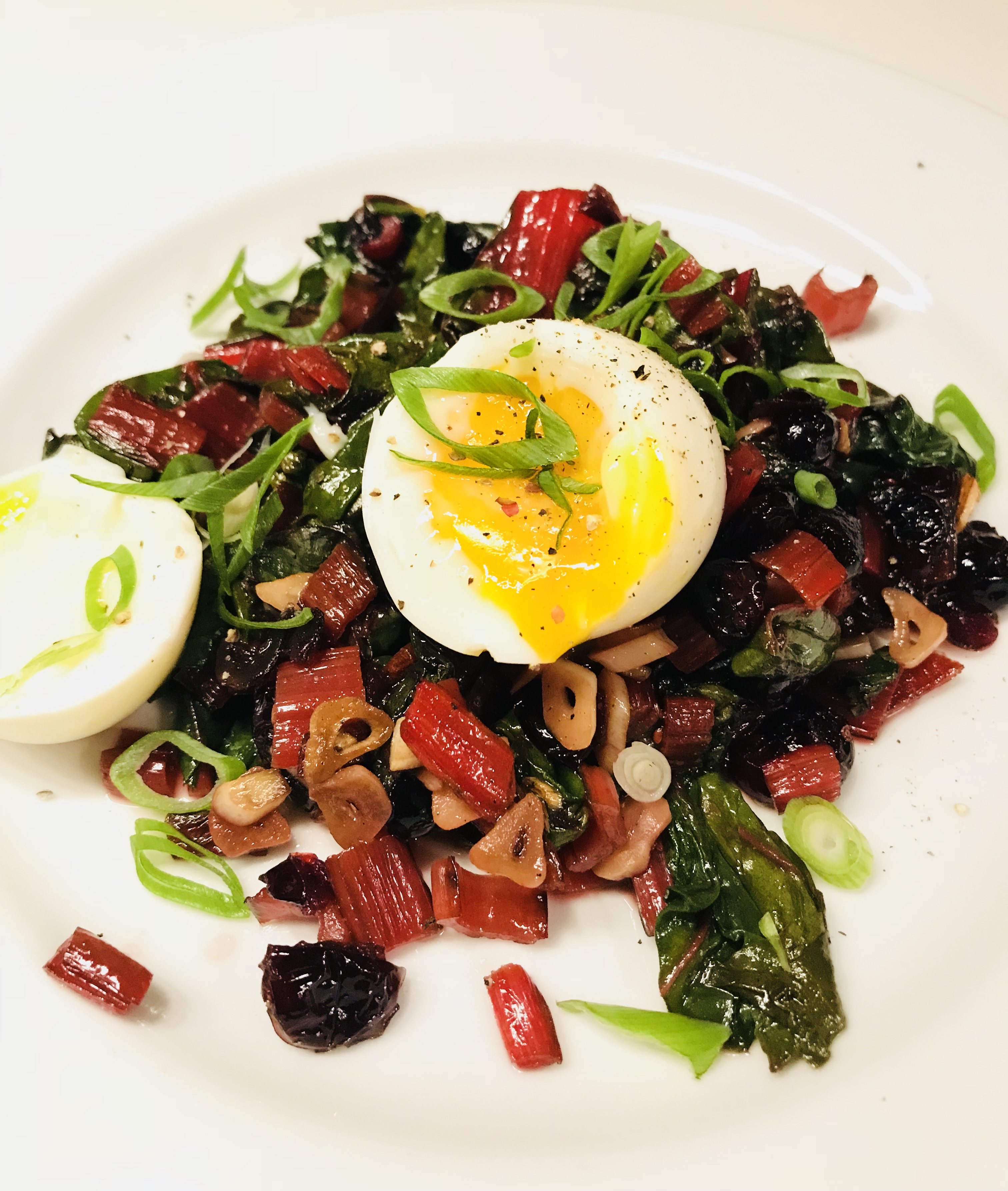
Instructions:
You will want to chop the stalks and cook those with the garlic as they take a little more time than the leaves. Keep the stalks and garlic separate and roughly chop the leaves.
Heat the olive oil up in a skillet on medium heat. Add the sliced garlic and chopped red chard stalks and sauté until softened and the garlic is lightly browned. Add the dried cranberries and fry until they sizzle and inflate a bit. Then add the greens and toss until they have slightly wilted but are still a vibrant green. Add a splash (about a tablespoon if you need to measure) of apple cider vinegar and turn off the heat. The greens will wilt a little more – season with salt and pepper and serve immediately.
Red Chard and Baby Potato Hash with Kalamata Olives
Ingredients:
- 2 tablespoons olive oil
- ½ lb whole baby potatoes (such as Dutch yellow), washed
- 1 bunch red chard leaves, chopped
- ¼ cup chopped Kalamata olives
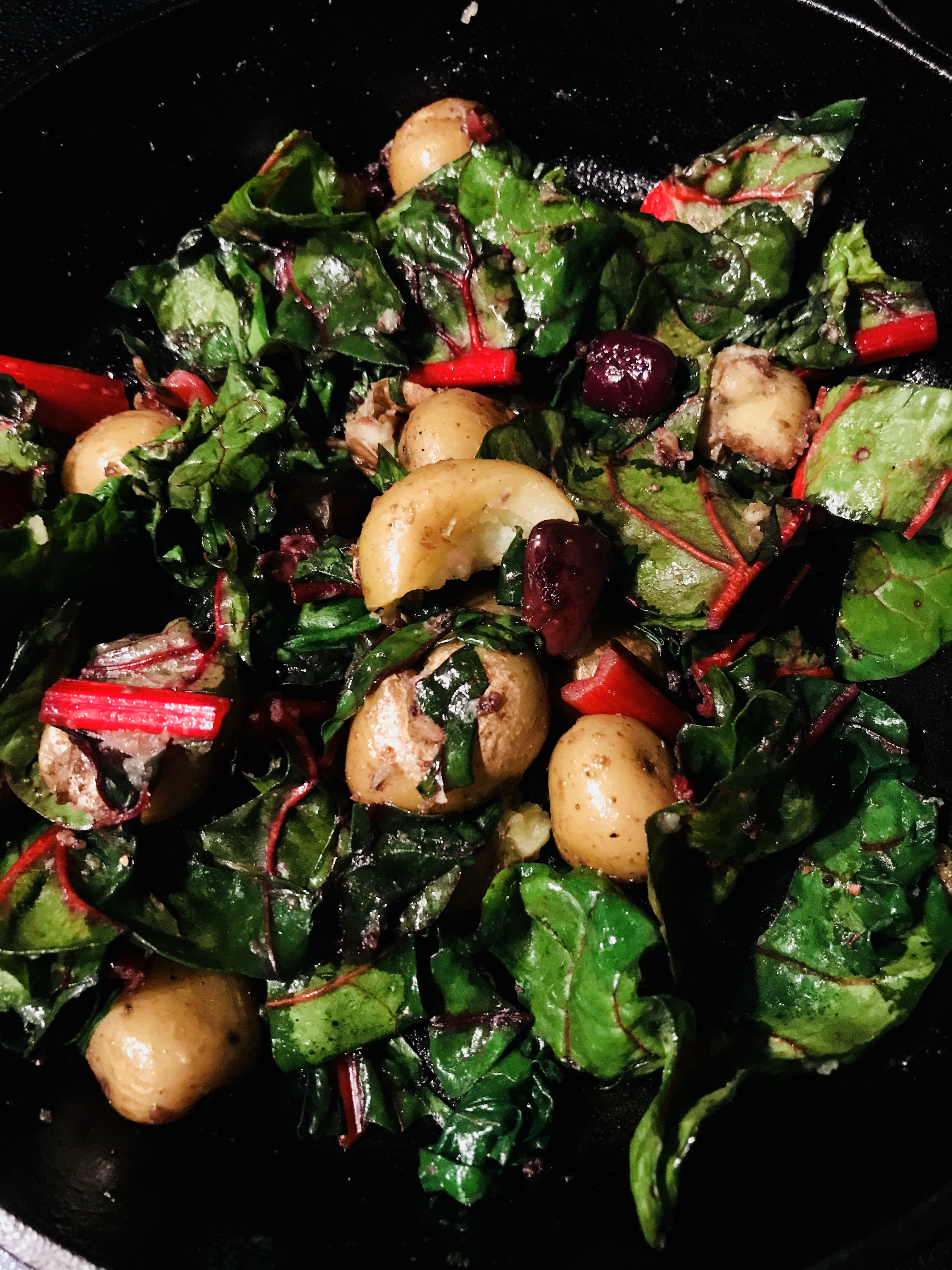
Instructions:
Boil the potatoes until tender. If you are serving this with an egg, remember that you can add the egg to the boiling pot with the potatoes – just be sure to set a timer! I like to drop an egg into the water just before it comes to a rolling boil (so it doesn’t get knocked on the side and leak into the water) and set a timer for 6 minutes. Immediately rinse the egg under cold water or drop it into an ice bath. You should have an egg with runny yolk but a stable white (thus easy to peel).
Drain the potatoes once tender. Heat the olive oil up in a skillet on medium heat. Add the potatoes and let them brown. You can even smash a few of them with the back of a spoon or spatula to vary the texture. Add the roughly chopped Kalamata olives and let them sizzle in the oil and dry out a little. Add the red chard greens, salt and pepper, and serve with the soft-boiled egg.
WEEK 10 IN PHOTOS
03/09/18 — Heydon Hatcher
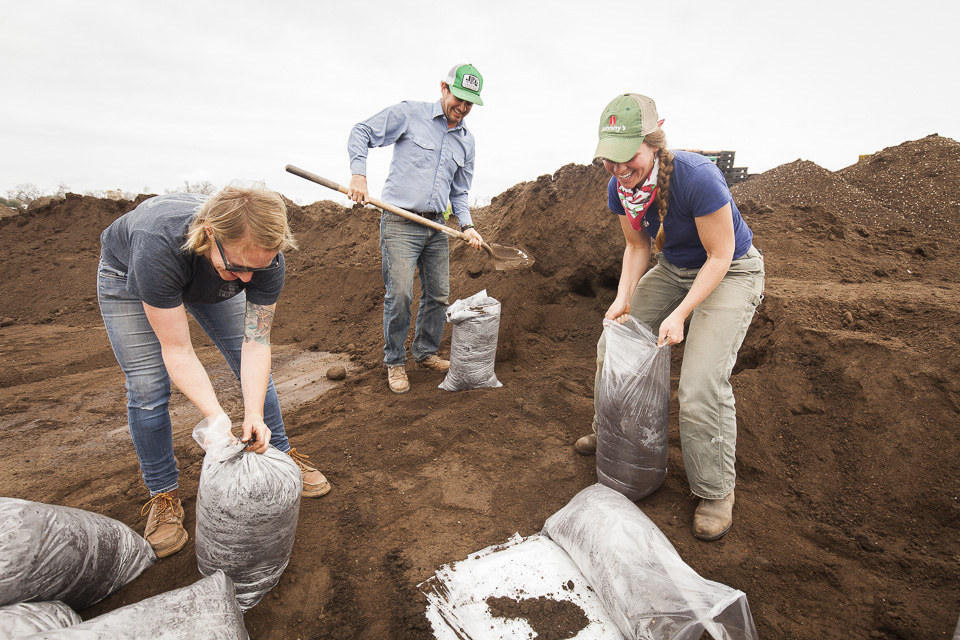 Compost collectin'. Photo by Scott David Gordon.
Compost collectin'. Photo by Scott David Gordon.
Another amazing Transplant Sale weekend in the books. Temperatures are rising and it's really starting to feel like spring! Becky and Brenton hosted a very well attended Gardening Workshop and had a blast touring folks around the farm afterward. Missed last weekend? Don't fret, the last weekend of the Transplant Sale is this Saturday, March 10th - 9 AM to 2 PM. Online sales have ended, but you can peruse the transplant menu online here.
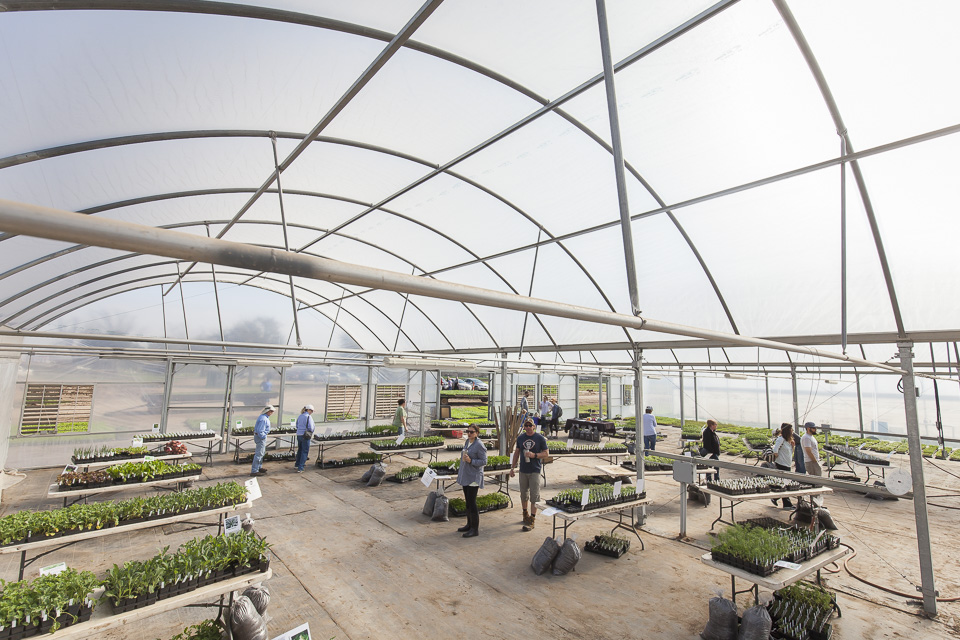 Transplant sale. Photo by Scott David Gordon.
Transplant sale. Photo by Scott David Gordon.
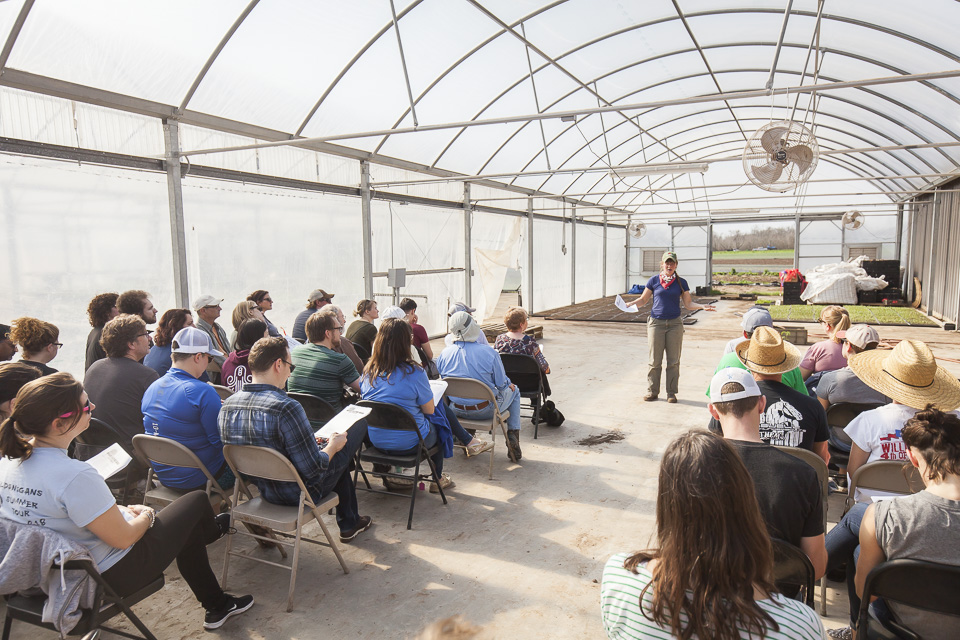 Gardening workshop. Photo by Scott David Gordon.
Gardening workshop. Photo by Scott David Gordon.
 Keeping the transplants hydrated. Photo by Scott David Gordon.
Keeping the transplants hydrated. Photo by Scott David Gordon.
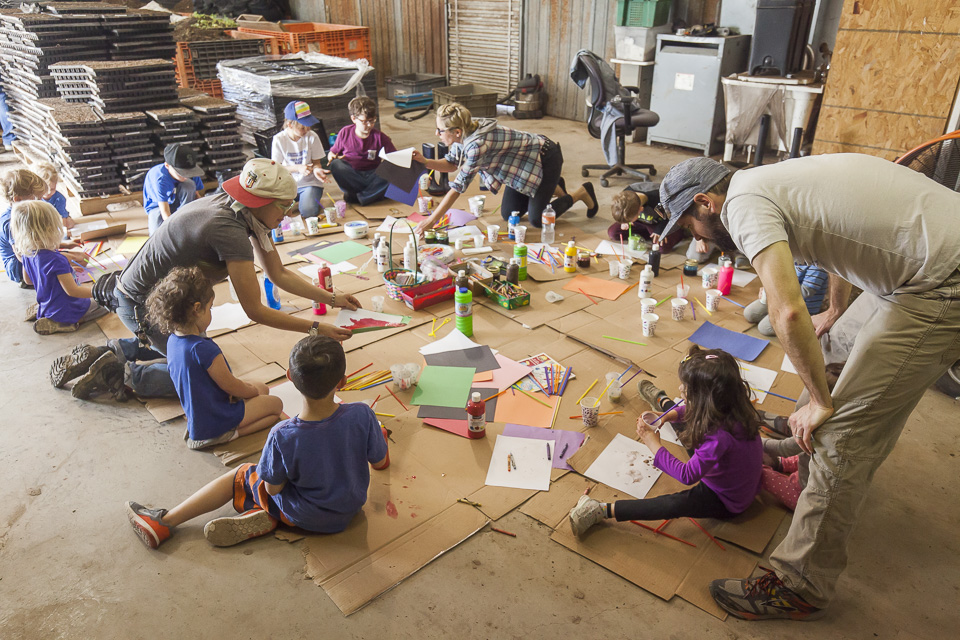 Kids' station. Photo by Scott David Gordon.
Kids' station. Photo by Scott David Gordon.
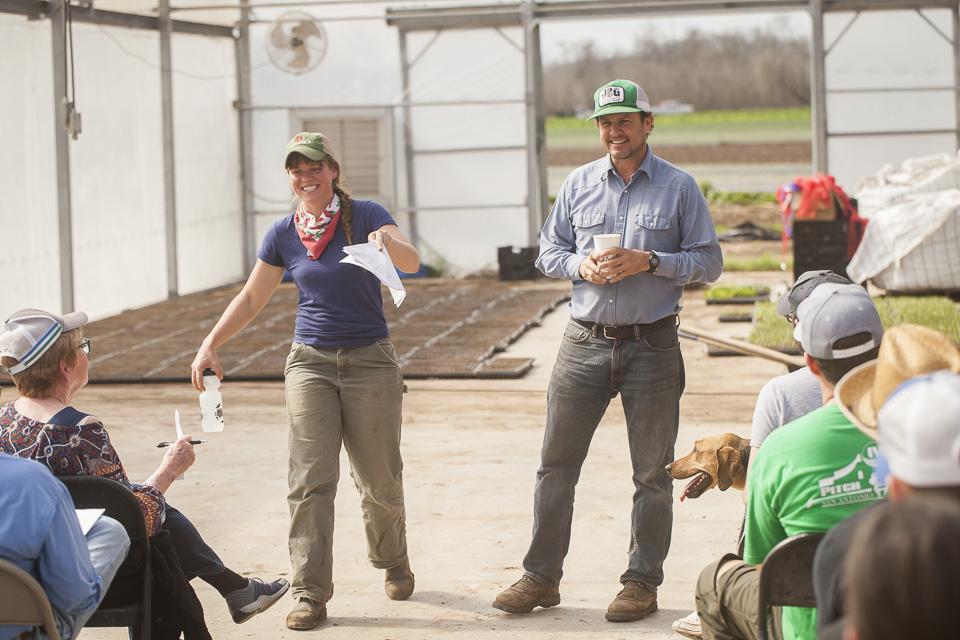 Brenton and Becky taking on the questions. Photo by Scott David Gordon.
Brenton and Becky taking on the questions. Photo by Scott David Gordon.
 A great showing of folks. Photo by Scott David Gordon.
A great showing of folks. Photo by Scott David Gordon.
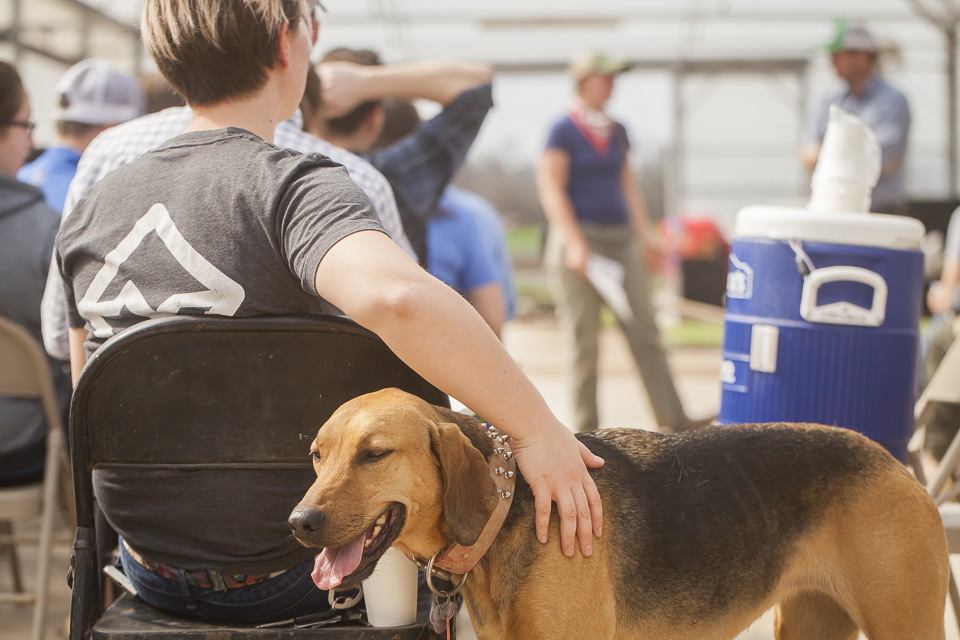 Roxy stealing attention. Photo by Scott David Gordon.
Roxy stealing attention. Photo by Scott David Gordon.
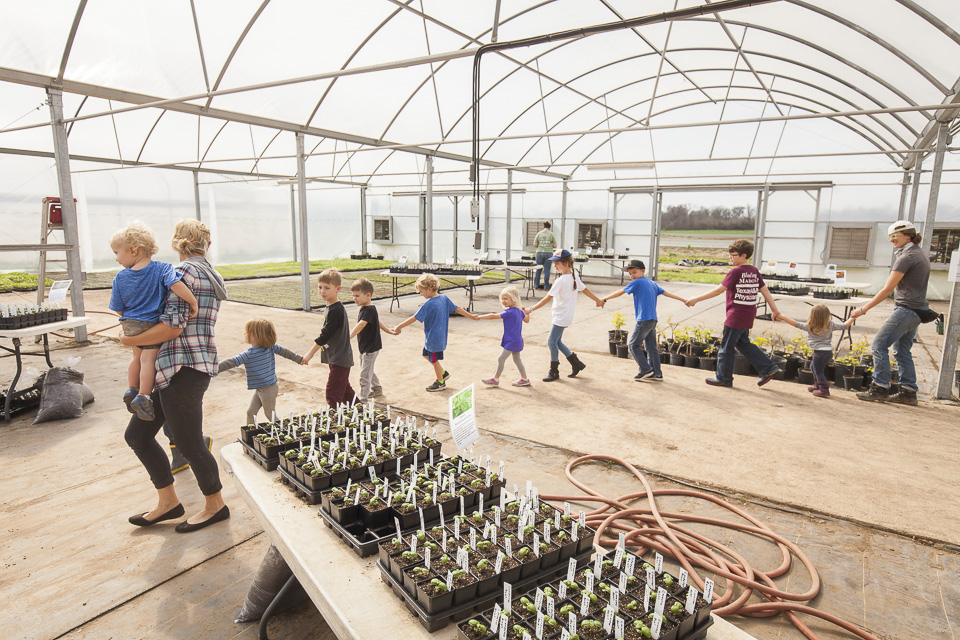 Kids moving from one fun activity to the next. Photo by Scott David Gordon.
Kids moving from one fun activity to the next. Photo by Scott David Gordon.
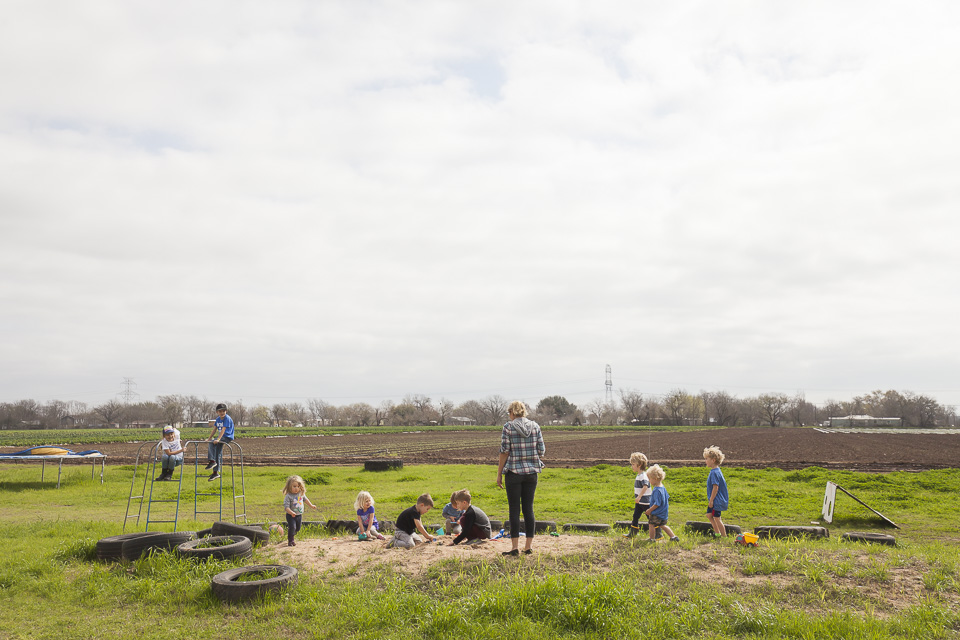 Sandpile exploration. Photo by Scott David Gordon.
Sandpile exploration. Photo by Scott David Gordon.
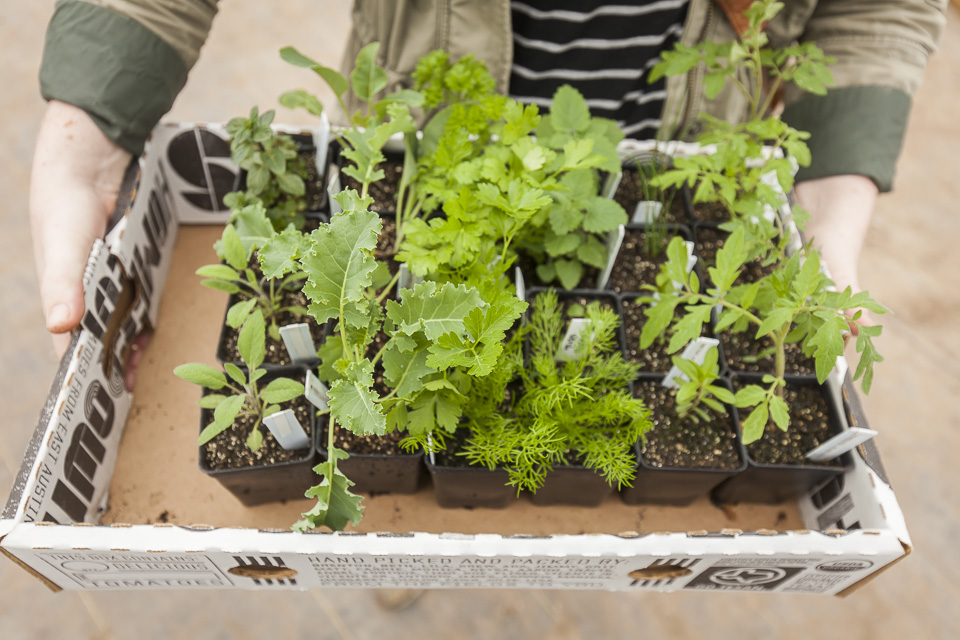 Transplant shopping. Photo by Scott David Gordon.
Transplant shopping. Photo by Scott David Gordon.
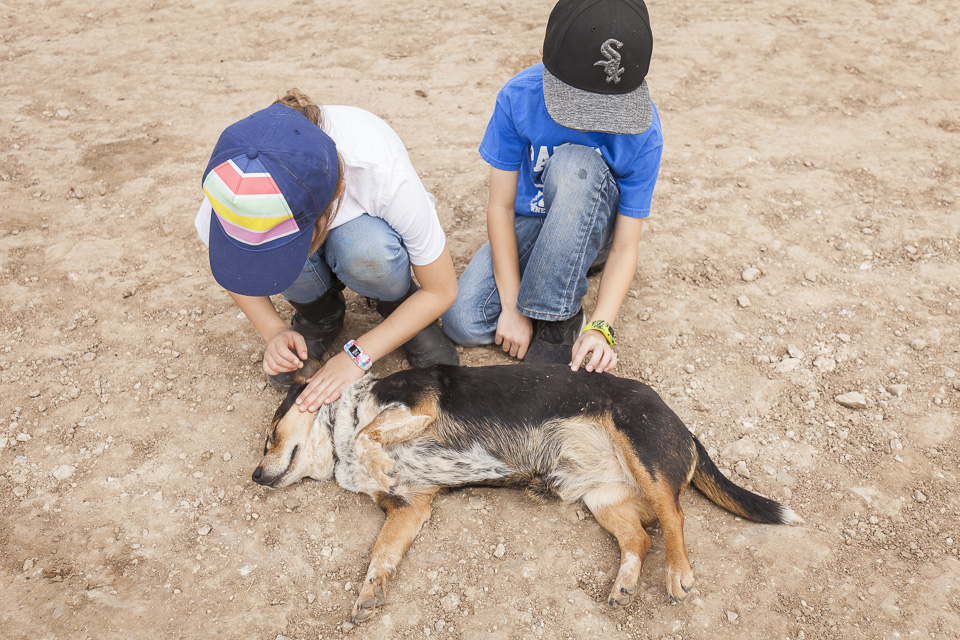 Chuch getting some love, too. Photo by Scott David Gordon.
Chuch getting some love, too. Photo by Scott David Gordon.
 Getting acquainted with baby veggies. Photo by Scott David Gordon.
Getting acquainted with baby veggies. Photo by Scott David Gordon.
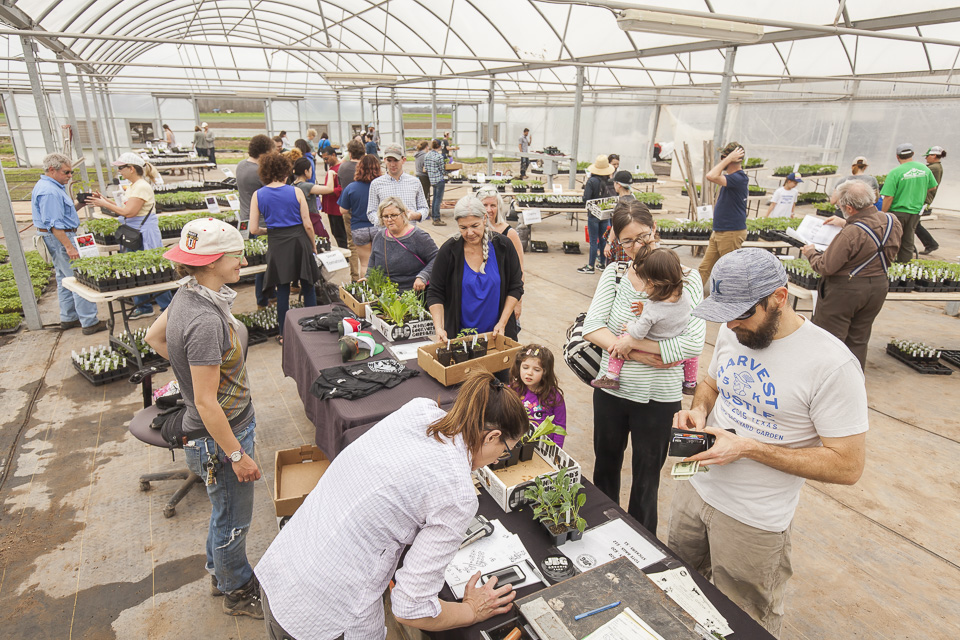 Transplant shopping. Photo by Scott David Gordon.
Transplant shopping. Photo by Scott David Gordon.
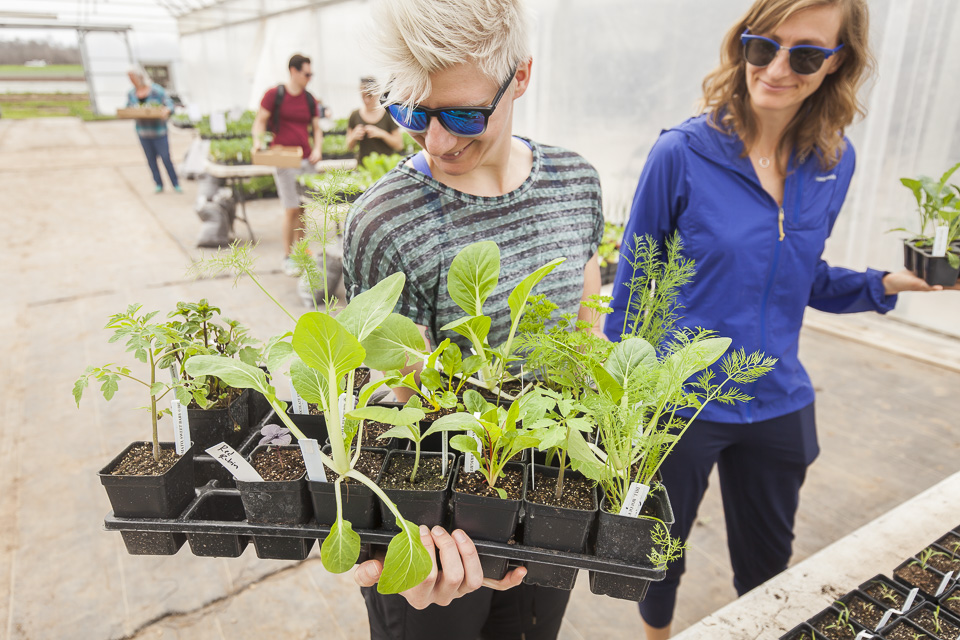 Transplant picks. Photo by Scott David Gordon.
Transplant picks. Photo by Scott David Gordon.
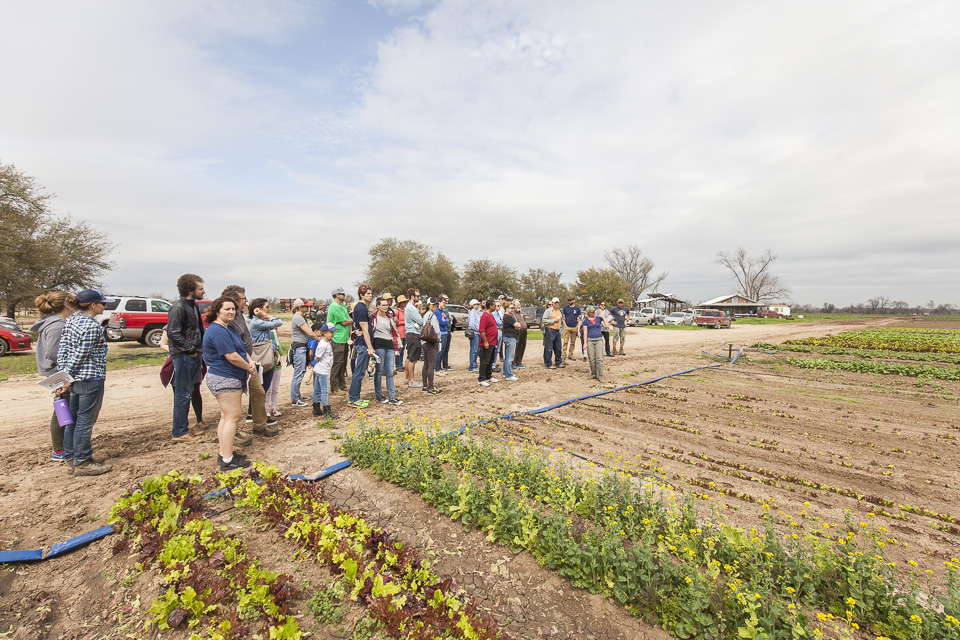 Post-workshop farm tour. Photo by Scott David Gordon.
Post-workshop farm tour. Photo by Scott David Gordon.
 Becky helping with transplant picks. Photo by Scott David Gordon.
Becky helping with transplant picks. Photo by Scott David Gordon.CSA BOX CONTENTS WEEK OF MARCH 12TH
03/13/18 — Scott
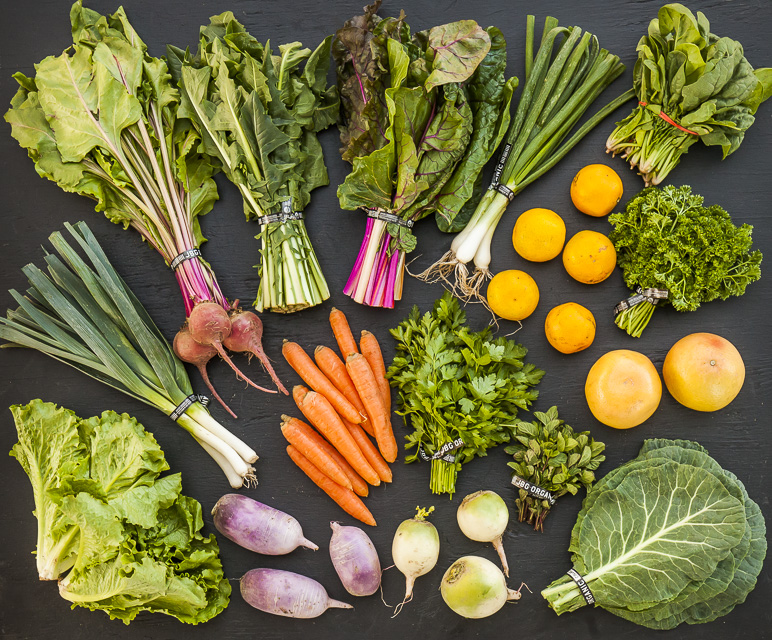 CSA Box Contents Week of March 12th
CSA Box Contents Week of March 12th
Large Box
Beet, Chioggia
Bok Choy
Carrot, Orange
Greens, Chard, Rainbow
Greens, Kale, Curly
Herb, Cilantro
Leek
Lettuce, Braising Mix
Onion, Spring Yellow
Radish, Daikon
Radish, Red
Turnip, Scarlett
Beet, Chioggia
Bok Choy
Carrot, Orange
Greens, Chard, Rainbow
Greens, Kale, Curly
Herb, Cilantro
Leek
Lettuce, Braising Mix
Onion, Spring Yellow
Radish, Daikon
Radish, Red
Turnip, Scarlett
Medium Box
Beet, Red
Carrot, Rainbow
Greens, Chard, Rainbow
Greens, Kale, Curly
Greens, Salad Mix
Leek
Onion, Spring Yellow
Radish, Red
Turnip, Scarlett
Beet, Red
Carrot, Rainbow
Greens, Chard, Rainbow
Greens, Kale, Curly
Greens, Salad Mix
Leek
Onion, Spring Yellow
Radish, Red
Turnip, Scarlett
Small Box
Beet, Golden
Carrot, Red
Greens, Collards
Greens, Dandelion
Greens, Kale, Curly
Herb, Spearmint
Onion, Spring Yellow
Beet, Golden
Carrot, Red
Greens, Collards
Greens, Dandelion
Greens, Kale, Curly
Herb, Spearmint
Onion, Spring Yellow
Individual Box
Beet, Golden
Carrot, Red
Greens, Chard, Rainbow
Greens, Kale, Curly
Onion, Spring Yellow
Beet, Golden
Carrot, Red
Greens, Chard, Rainbow
Greens, Kale, Curly
Onion, Spring Yellow
CSA BOX CONTENTS WEEK OF MARCH 12TH
03/13/18 — Scott
 CSA Box Contents Week of March 12th
CSA Box Contents Week of March 12th
Large Box
Beet, Chioggia
Carrot, Orange
Citrus, Mixed
Greens, Collards
Greens, Dandelion
Greens, Spinach
Herb, Parsley, Flat
Leek
Lettuce, Romaine
Onion, Spring Yellow
Radish, French Breakfast
Radish, Purple Daikon
BREAKFAST TURNIPS
03/15/18 — Heydon Hatcher
Recipe and Photos by Megan Winfrey
With the influx of turnips and rutabagas of late winter, I've been making a lot of mashes. I love turnip mash and make it in big batches, so it ends up on our plates quite frequently. Lucky for me, I don't live with picky eaters...usually.
Funny story. My husband usually makes breakfast. It's his favorite meal of the day. One weekend recently, I told him to sleep in and that I would make breakfast. I was almost done when he came into the kitchen, potatoes, bacon, and eggs ready in their pans. "Mmmm," he said, clearly very excited about sitting down with his favorite food groups. I chimed in "I'm making breakfast bowls with turnip mash on the bottom." "Umm, no thanks I'll just have everything else, no turnips," he replied.
Well, I'm a bit stubborn. My mother's old quip "You'll eat it, and you'll like it!" came to mind. So I assembled our breakfast bowls and we sat down to eat. He took two bites, and a look of annoyance washed over his face. He really, really didn't like it. And now all the good stuff was covered in turnip mash. Watching him rake his bowl into the compost bin was so incredibly sad, I wished I hadn't been so stubborn. I, however, cleaned my bowl and hope you will too.
Breakfast Turnips![]() Turnip mash on toast.
Turnip mash on toast.
For the mash, place the turnips and potatoes in a large pot with enough water to cover. Boil for 25-30 minutes, or until tender. Drain the water and mix in the milk, 2 tbs. of butter, and salt and pepper to taste. Mash, keeping it slightly lumpy.
Bowl: A thin layer of turnip mash topped with anything and everything breakfast-y ie. eggs, bacon, beans, greens, toast, hot sauce.
![]() Yummy breakfast bowl.
Yummy breakfast bowl.
Toast: Make toast. Add a thin layer of turnip mash and top with arugula, sunny side up egg, and roasted romanesco or other roasted veggies. Top with hot sauce. See picture above.
![]() The process.
The process.
With the influx of turnips and rutabagas of late winter, I've been making a lot of mashes. I love turnip mash and make it in big batches, so it ends up on our plates quite frequently. Lucky for me, I don't live with picky eaters...usually.
Funny story. My husband usually makes breakfast. It's his favorite meal of the day. One weekend recently, I told him to sleep in and that I would make breakfast. I was almost done when he came into the kitchen, potatoes, bacon, and eggs ready in their pans. "Mmmm," he said, clearly very excited about sitting down with his favorite food groups. I chimed in "I'm making breakfast bowls with turnip mash on the bottom." "Umm, no thanks I'll just have everything else, no turnips," he replied.
Well, I'm a bit stubborn. My mother's old quip "You'll eat it, and you'll like it!" came to mind. So I assembled our breakfast bowls and we sat down to eat. He took two bites, and a look of annoyance washed over his face. He really, really didn't like it. And now all the good stuff was covered in turnip mash. Watching him rake his bowl into the compost bin was so incredibly sad, I wished I hadn't been so stubborn. I, however, cleaned my bowl and hope you will too.
Breakfast Turnips
- 3 turnips, peeled and cubed
- 1 white potato, peeled and cubed
- 1/4 cup milk
- 3 tbs. butter
 Turnip mash on toast.
Turnip mash on toast.
For the mash, place the turnips and potatoes in a large pot with enough water to cover. Boil for 25-30 minutes, or until tender. Drain the water and mix in the milk, 2 tbs. of butter, and salt and pepper to taste. Mash, keeping it slightly lumpy.
Bowl: A thin layer of turnip mash topped with anything and everything breakfast-y ie. eggs, bacon, beans, greens, toast, hot sauce.
 Yummy breakfast bowl.
Yummy breakfast bowl.
Toast: Make toast. Add a thin layer of turnip mash and top with arugula, sunny side up egg, and roasted romanesco or other roasted veggies. Top with hot sauce. See picture above.
 The process.
The process.JBG ONIONS: ALL(IUM) YOU NEED TO KNOW
03/16/18 — Heydon Hatcher
Not only does SXSW mean the beginning of springtime here in Austin, but here at the farm, spring means ONIONS! That’s right, we thought this week we would dive into a little history, relay some fun facts, delve into how we cultivate this labor-intensive crop, and generally praise this lovely allium.
This veggie has been part of the human diet for over 7000 years! There have been traces of onions found by archaeologists dating back to 5000 BC. Being easily transportable, storing well and for long periods of time, and growing in a vast array of climates and soil, this bulb has been ubiquitous throughout history. Tracing back to Chinese gardens thousands of years ago, referenced in Indian Vedic writings, mentioned in the Bible, the pilgrims even brought onions on the Mayflower only to discover that Native Americans already grew a different varietal. Talk about a veggie that has really helped the human race thrive - this one has really run the gamut. Egyptians worshipped onions - they saw eternity in the concentric rings that make up its anatomy. They would place onions in Pharaohs' tombs to ensure a full and prosperous afterlife. Greek athletes would consume massive amounts of this veggie prior to significant athletic contests as they believed it would make them significantly stronger! Throughout the years, onions have been thought to aid vision, eliminate dysentery, strengthen joints, alleviate sores of all sorts, and even heal snake bites. What CAN’T this vegetable do?! We cannot get enough of onions, and hope that this post will make your heart grow fonder of them, too.
![]() Montana and the onion. Photo by Scott David Gordon.
Montana and the onion. Photo by Scott David Gordon.
Onions hail from the Allium family... its members are often distinguished for having high sulfur compounds which contribute to their unique aroma and taste (sulfenic acid is what makes you cry when you cut into a fresh onion!). Leeks, garlic, scallions, shallots, and chives are some of the other veggie members of this perennial, flowering, and bulb-producing veggie fam. Despite the first paragraph’s talk of the onion’s omniscience throughout history, don’t be fooled, this crop is one of our more complicated vegetables to cultivate, and also one of our most important. Onions are one of our head farmer's favorites. He loves to tell the long and storied past of his travails with figuring out the cultivation of this bulb as it was so elusive to him for years, back when his farm fit in his backyard. He stumbled upon an onion mentor in the midst of his allium endeavors: Bruce “Onionman” Frasier, the head farmer of Dixondale Farms - one of the biggest producers of onions in the United States. Bruce really aided Brenton in his slow-learning onion education, and taught him one very important thing - the perfect onion has 13 rings.
“The size of an onion bulb is dependent upon the number and size of green leaves at the time of bulb maturity. For each leaf, there will be a ring of onion; the larger the leaf, the larger the ring will be. The perfect onion has 13 rings, which means that you should strive for 13 leaves if you want the biggest onions you've ever grown. The 9th leaf is usually the largest leaf on the plant, and that's when the nitrogen fertility should peak. When the 13th leaf appears, the onion is getting ready to start curing. This occurs at about the same time that the rest of the larger leaves have transferred most of their carbohydrates to the rings, so the onion's neck will start getting soft. It won't need as much moisture, which means you should stop irrigating the crop from this point on.” -Bruce Frasier, onion farmer extraordinaire.
Here at JBG, onions are started from seed in the bare ground. At the end of summer/fall, we prepare about 15 beds (want to learn more about the bed-making process? Click here!), plant onion seeds very tightly together, and let them grow for about 6 to 8 weeks. When they get to pencil-length thickness, we pull them out of the ground, yank the tops off (leaving a few inches of green), and move them to another plastic-covered bed. This is to allow them space to spread out, grow, and bulb. This transplanting process usually begins in October or November and takes about 5 or 6 weeks to complete as there are so many beds of onions, plus a massive amount of plant going into those beds! Onions are frost-resistant and massively resilient, so during the winter, they just hang onto the field until the days lengthen and spring sun returns. They really don’t start to grow until around early March, and when this time rolls around, the growth rate really starts to quicken.
![]() Bare ground growing of onions! Photo by Scott David Gordon.
Bare ground growing of onions! Photo by Scott David Gordon.
![]() Transplanting onions. Photo by Scott David Gordon.
Transplanting onions. Photo by Scott David Gordon.
Fun fact: There three different kinds of onions - short-day (bulbing at 10-12 hours of sunlight), day-neutral (bulbing at 12-14 hours of sunlight), and long-day onions (bulbing at 14-16 hours of sunlight). Here in Austin, short-day onions thrive (we are on the verge of day-neutral, though!); thus, we focus on those. What triggers an onion to bulb is the number of hours of daylight it receives. They will only bulb if they get at least the amounts mentioned above. We plant short-day onions in the fall, while we plant the one day-neutral onion varietal we cultivate during the spring. The day length is why we plant at two different times, to make sure the length of light during a day will trigger bulbing. It’s really quite critical to plant onions at the right time of year to get the right amount of growth.
We don’t usually harvest the full bulb onions until around May. However, you might be wondering how to explain those green onions or spring onions you might be seeing at market? These are just tiny baby bulbs of the full-grown bulbs to come in later months. This allium is edible at every point of growth; thus, we harvest all throughout its lifecycle. It’s easy to differentiate green and spring onions because you can spot that spring onions have little baby bulbs, whereas green onions are long, skinny, and slender. We also grow multiplying onions, in late summer and fall to provide green onions during those times. These onions don’t ever form a bulb; however, when they become fully grown, they divide themselves. When you plant one, you’ll get a full chunk of them. These are also super resilient and hardy.
![]() Green onions. Photo by Scott David Gordon.
Green onions. Photo by Scott David Gordon.
![]() Spring onions! Photo by Brenton.
Spring onions! Photo by Brenton.
When we harvest, we cut off the tops with a specialized tool, called onion shears, then cut the roots off of each bulb. We bag them up in 30 lb mesh bags and cure them in the greenhouse in high heat for a week. This removes the excess moisture and lengthens their longevity. Once they are good and papery on the outside, we lay them all out at the barn. We sic a leaf blower on them to remove dry excess skin and then pack them in bulk bins. We get them into cold storage, and they can last 4 to 5 months! Talk about storage crop!
![]() Curing in the greenhouse. Photo by Scott David Gordon.
Curing in the greenhouse. Photo by Scott David Gordon.
This year we are looking forward to a fruitful and long-lasting onion season! We have yellow, red, and white varieties that we are ecstatic to unveil to you in your CSA box and at market. Have fun(ion) out there in the SXSW fray! ‘Til next time.
This veggie has been part of the human diet for over 7000 years! There have been traces of onions found by archaeologists dating back to 5000 BC. Being easily transportable, storing well and for long periods of time, and growing in a vast array of climates and soil, this bulb has been ubiquitous throughout history. Tracing back to Chinese gardens thousands of years ago, referenced in Indian Vedic writings, mentioned in the Bible, the pilgrims even brought onions on the Mayflower only to discover that Native Americans already grew a different varietal. Talk about a veggie that has really helped the human race thrive - this one has really run the gamut. Egyptians worshipped onions - they saw eternity in the concentric rings that make up its anatomy. They would place onions in Pharaohs' tombs to ensure a full and prosperous afterlife. Greek athletes would consume massive amounts of this veggie prior to significant athletic contests as they believed it would make them significantly stronger! Throughout the years, onions have been thought to aid vision, eliminate dysentery, strengthen joints, alleviate sores of all sorts, and even heal snake bites. What CAN’T this vegetable do?! We cannot get enough of onions, and hope that this post will make your heart grow fonder of them, too.
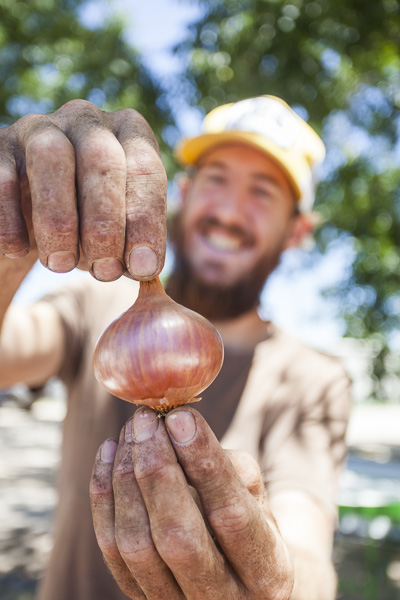 Montana and the onion. Photo by Scott David Gordon.
Montana and the onion. Photo by Scott David Gordon.
Onions hail from the Allium family... its members are often distinguished for having high sulfur compounds which contribute to their unique aroma and taste (sulfenic acid is what makes you cry when you cut into a fresh onion!). Leeks, garlic, scallions, shallots, and chives are some of the other veggie members of this perennial, flowering, and bulb-producing veggie fam. Despite the first paragraph’s talk of the onion’s omniscience throughout history, don’t be fooled, this crop is one of our more complicated vegetables to cultivate, and also one of our most important. Onions are one of our head farmer's favorites. He loves to tell the long and storied past of his travails with figuring out the cultivation of this bulb as it was so elusive to him for years, back when his farm fit in his backyard. He stumbled upon an onion mentor in the midst of his allium endeavors: Bruce “Onionman” Frasier, the head farmer of Dixondale Farms - one of the biggest producers of onions in the United States. Bruce really aided Brenton in his slow-learning onion education, and taught him one very important thing - the perfect onion has 13 rings.
“The size of an onion bulb is dependent upon the number and size of green leaves at the time of bulb maturity. For each leaf, there will be a ring of onion; the larger the leaf, the larger the ring will be. The perfect onion has 13 rings, which means that you should strive for 13 leaves if you want the biggest onions you've ever grown. The 9th leaf is usually the largest leaf on the plant, and that's when the nitrogen fertility should peak. When the 13th leaf appears, the onion is getting ready to start curing. This occurs at about the same time that the rest of the larger leaves have transferred most of their carbohydrates to the rings, so the onion's neck will start getting soft. It won't need as much moisture, which means you should stop irrigating the crop from this point on.” -Bruce Frasier, onion farmer extraordinaire.
Here at JBG, onions are started from seed in the bare ground. At the end of summer/fall, we prepare about 15 beds (want to learn more about the bed-making process? Click here!), plant onion seeds very tightly together, and let them grow for about 6 to 8 weeks. When they get to pencil-length thickness, we pull them out of the ground, yank the tops off (leaving a few inches of green), and move them to another plastic-covered bed. This is to allow them space to spread out, grow, and bulb. This transplanting process usually begins in October or November and takes about 5 or 6 weeks to complete as there are so many beds of onions, plus a massive amount of plant going into those beds! Onions are frost-resistant and massively resilient, so during the winter, they just hang onto the field until the days lengthen and spring sun returns. They really don’t start to grow until around early March, and when this time rolls around, the growth rate really starts to quicken.
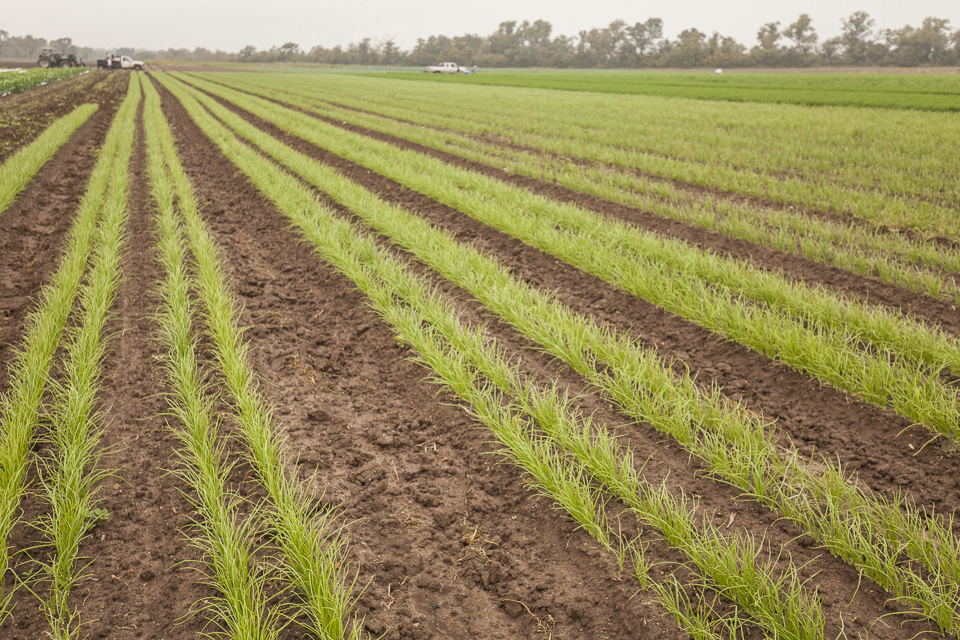 Bare ground growing of onions! Photo by Scott David Gordon.
Bare ground growing of onions! Photo by Scott David Gordon.
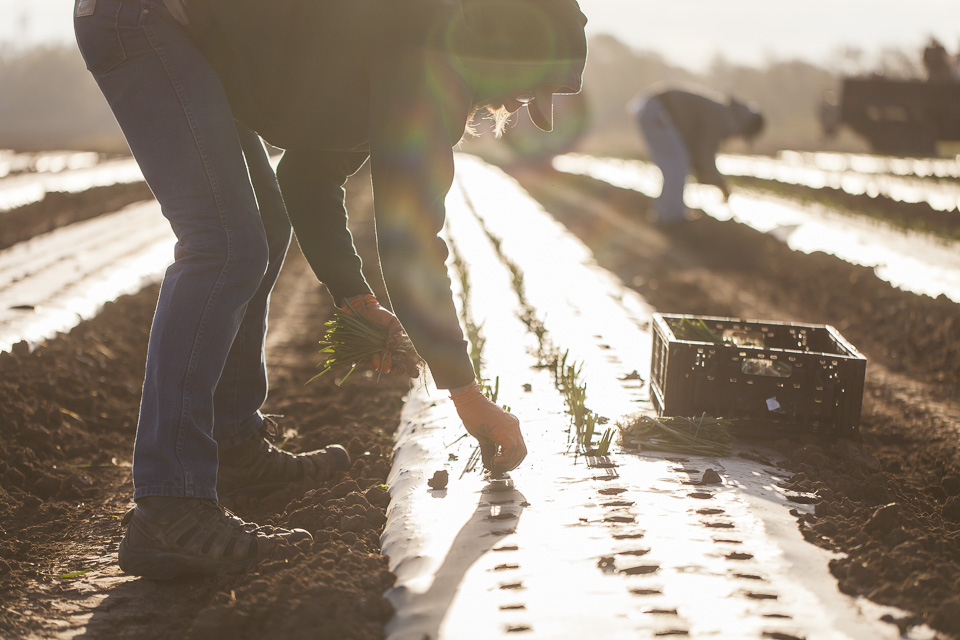 Transplanting onions. Photo by Scott David Gordon.
Transplanting onions. Photo by Scott David Gordon.
Fun fact: There three different kinds of onions - short-day (bulbing at 10-12 hours of sunlight), day-neutral (bulbing at 12-14 hours of sunlight), and long-day onions (bulbing at 14-16 hours of sunlight). Here in Austin, short-day onions thrive (we are on the verge of day-neutral, though!); thus, we focus on those. What triggers an onion to bulb is the number of hours of daylight it receives. They will only bulb if they get at least the amounts mentioned above. We plant short-day onions in the fall, while we plant the one day-neutral onion varietal we cultivate during the spring. The day length is why we plant at two different times, to make sure the length of light during a day will trigger bulbing. It’s really quite critical to plant onions at the right time of year to get the right amount of growth.
We don’t usually harvest the full bulb onions until around May. However, you might be wondering how to explain those green onions or spring onions you might be seeing at market? These are just tiny baby bulbs of the full-grown bulbs to come in later months. This allium is edible at every point of growth; thus, we harvest all throughout its lifecycle. It’s easy to differentiate green and spring onions because you can spot that spring onions have little baby bulbs, whereas green onions are long, skinny, and slender. We also grow multiplying onions, in late summer and fall to provide green onions during those times. These onions don’t ever form a bulb; however, when they become fully grown, they divide themselves. When you plant one, you’ll get a full chunk of them. These are also super resilient and hardy.
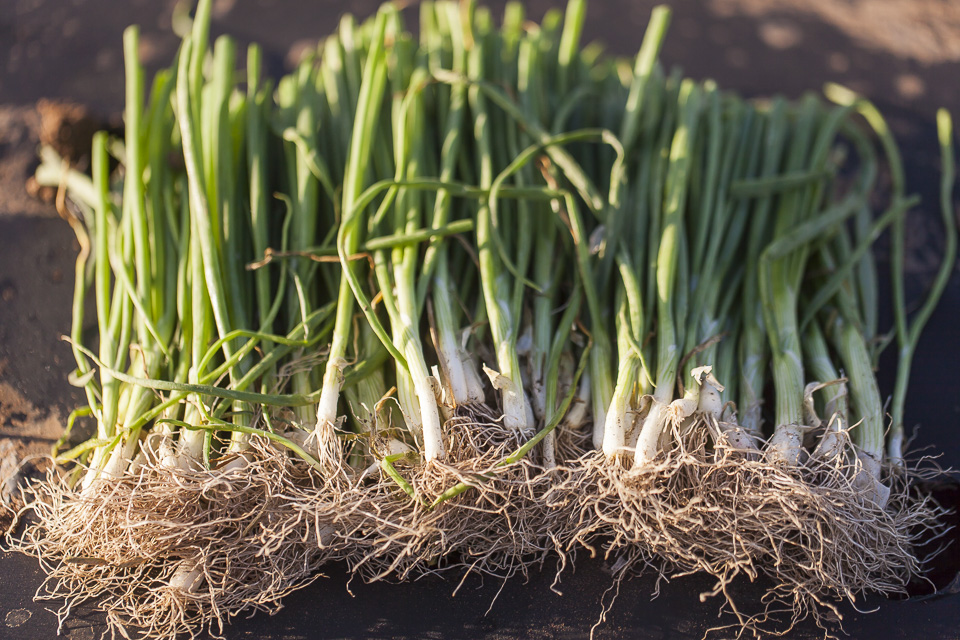 Green onions. Photo by Scott David Gordon.
Green onions. Photo by Scott David Gordon.
 Spring onions! Photo by Brenton.
Spring onions! Photo by Brenton.
When we harvest, we cut off the tops with a specialized tool, called onion shears, then cut the roots off of each bulb. We bag them up in 30 lb mesh bags and cure them in the greenhouse in high heat for a week. This removes the excess moisture and lengthens their longevity. Once they are good and papery on the outside, we lay them all out at the barn. We sic a leaf blower on them to remove dry excess skin and then pack them in bulk bins. We get them into cold storage, and they can last 4 to 5 months! Talk about storage crop!
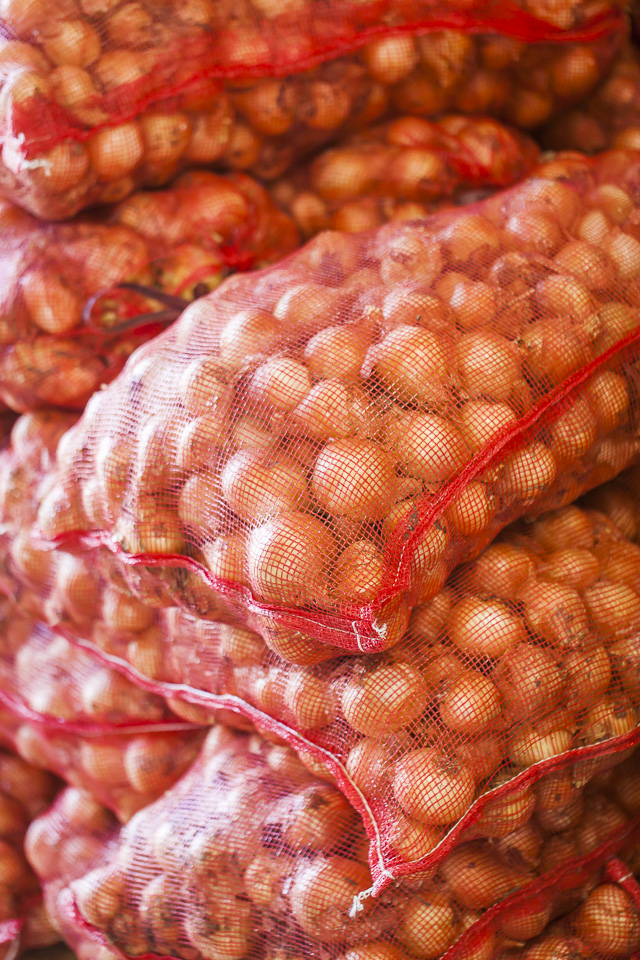 Curing in the greenhouse. Photo by Scott David Gordon.
Curing in the greenhouse. Photo by Scott David Gordon.
This year we are looking forward to a fruitful and long-lasting onion season! We have yellow, red, and white varieties that we are ecstatic to unveil to you in your CSA box and at market. Have fun(ion) out there in the SXSW fray! ‘Til next time.
WEEK 11 IN PHOTOS
03/16/18 — Heydon Hatcher
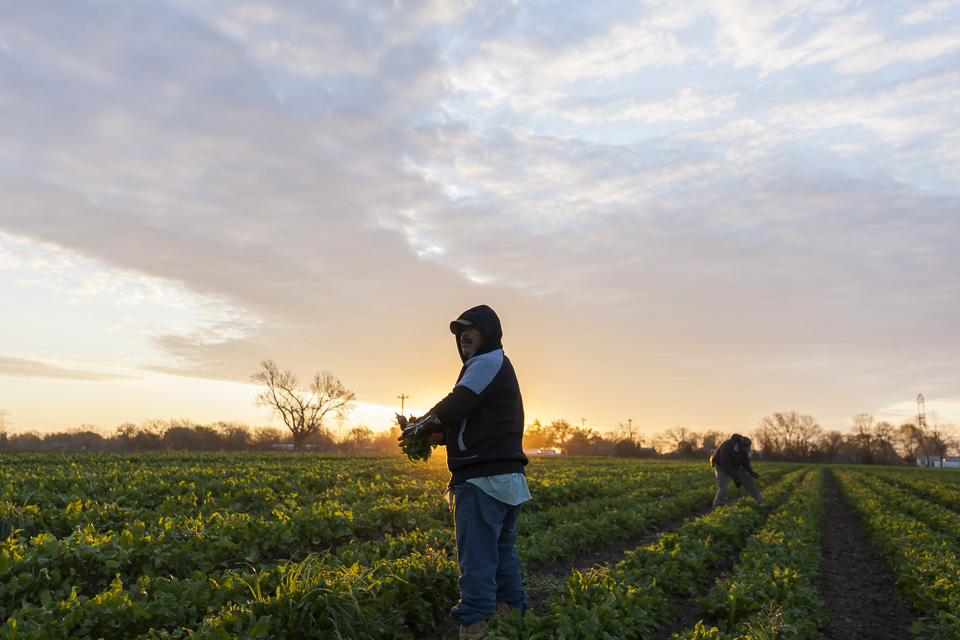 Harvesting at sunrise. Photo by Scott David Gordon.
Harvesting at sunrise. Photo by Scott David Gordon.
We've officially passed the frost date, so we are "off to the races" as our Farm Manager, Becky says. We are getting those warm-weather, tender crops like tomatoes, peppers, and eggplants into the ground, and finishing up on the last succession of cool weather plantings (think: lettuce and broccoli). Thanks for making the three weekends of the 2018 Transplant Sale such a success. We hope your backyard gardens are shaping up nicely.
Ever wanted to volunteer at the farm? We are in dire need of volunteers during this bustling spring season. In exchange for volunteering, folks are thanked with a Medium CSA share. Pretty cool, eh? It's an awesome way to get to know the farm, your farmers, and also get some free veggies. Just RSVP before coming at jbgorganic.com/volunteer or give the farm office a ring at 512-386-5273.
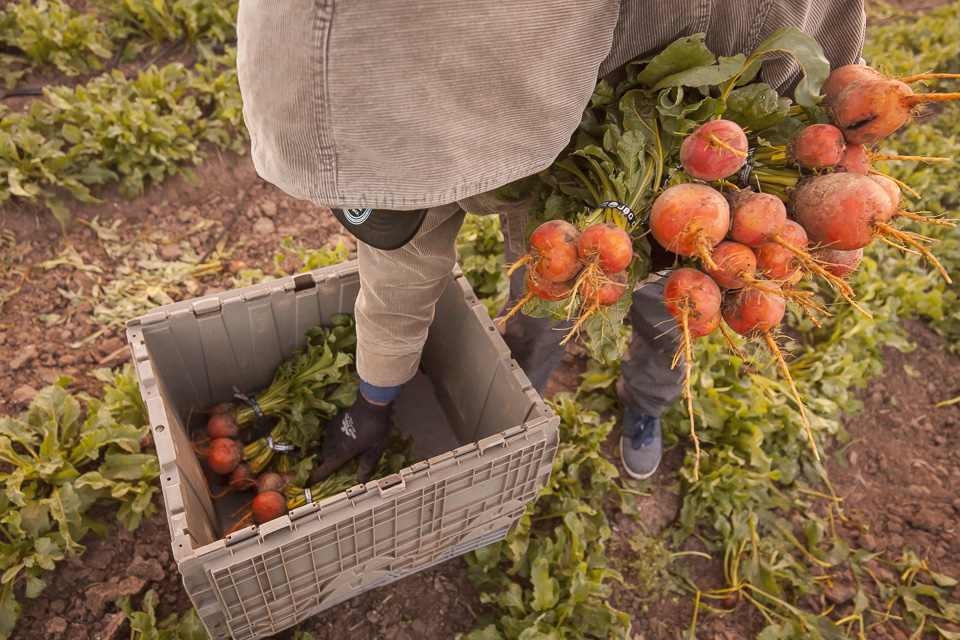 Beets. Photo by Scott David Gordon.
Beets. Photo by Scott David Gordon.
 Beautiful farm skies. Photo by Scott David Gordon.
Beautiful farm skies. Photo by Scott David Gordon.
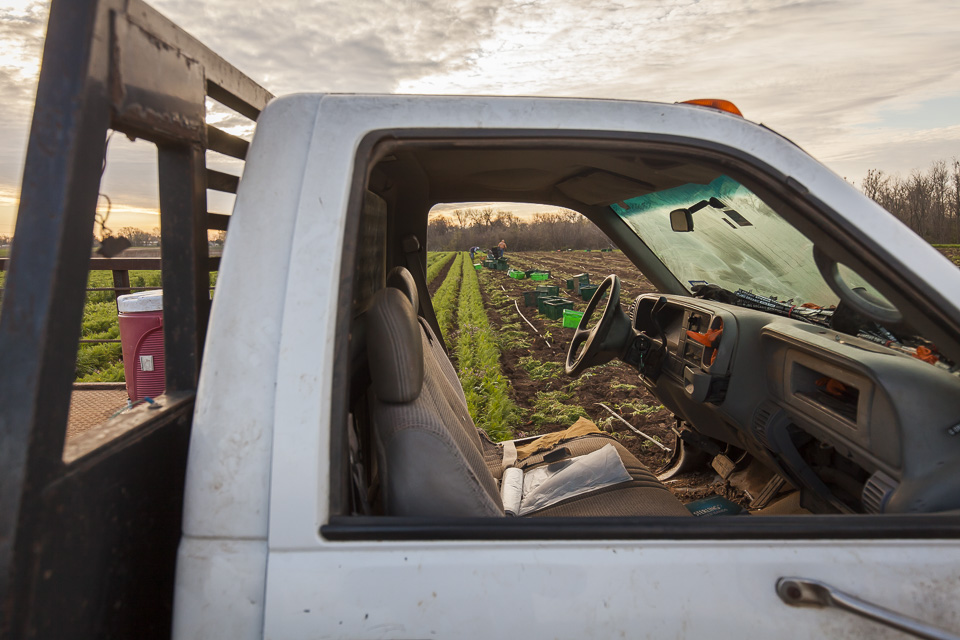 Views from the farm vehicle. Photo by Scott David Gordon.
Views from the farm vehicle. Photo by Scott David Gordon.
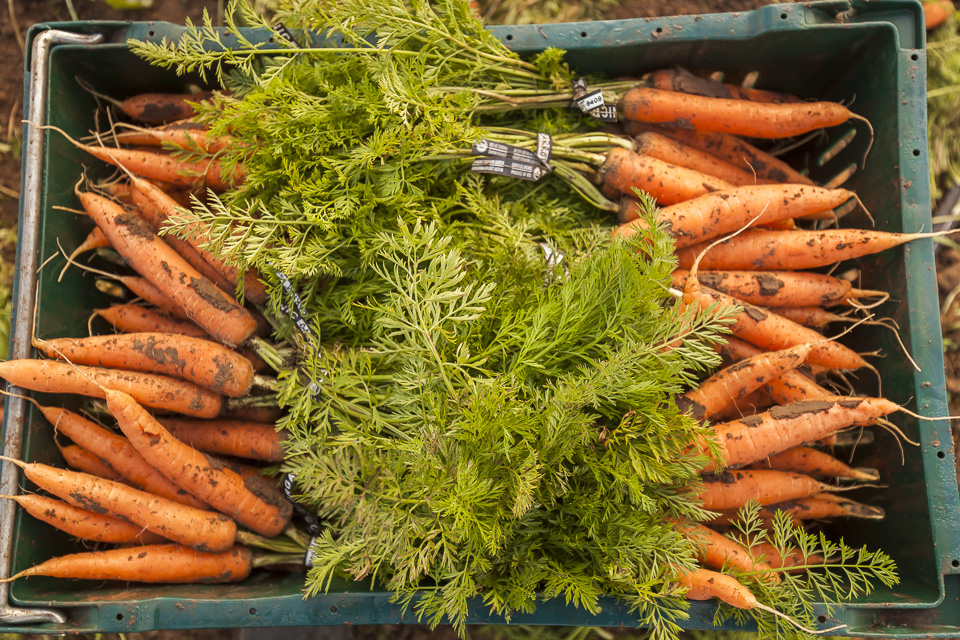 Carrot bounty. Photo by Scott David Gordon.
Carrot bounty. Photo by Scott David Gordon.
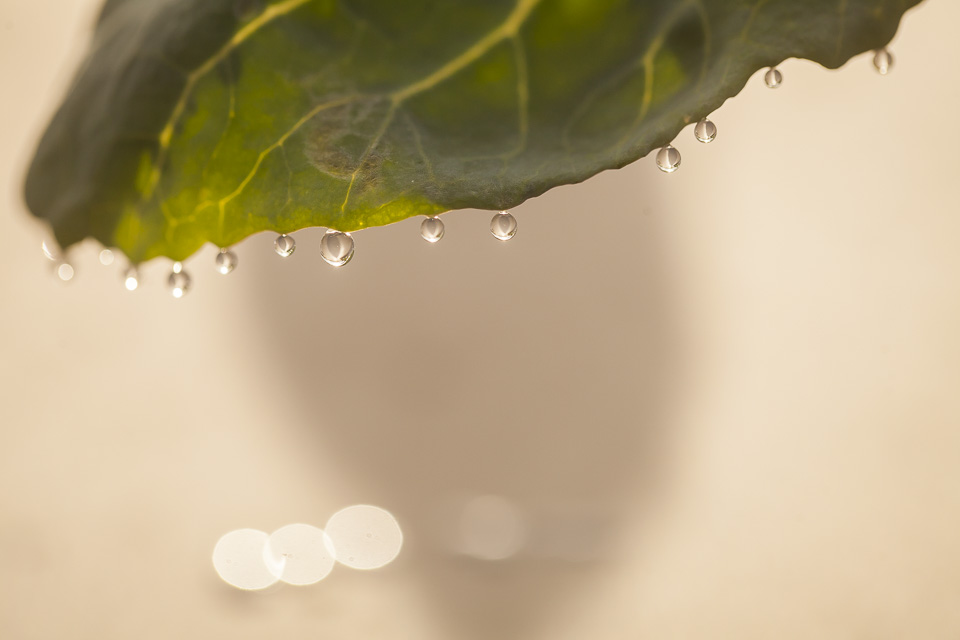 After a watering. Photo by Scott David Gordon.
After a watering. Photo by Scott David Gordon.
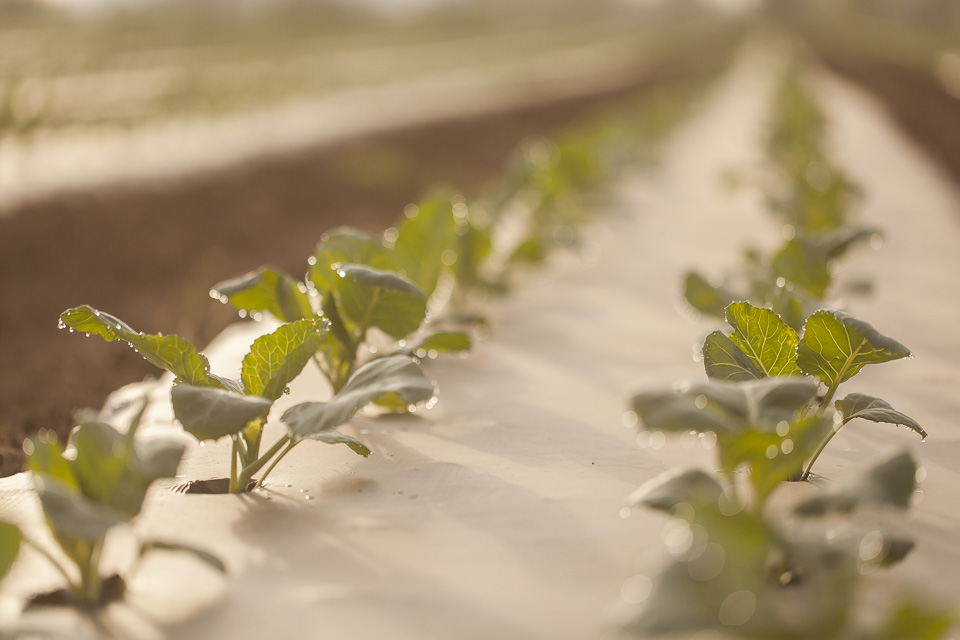 Growing! Photo by Scott David Gordon.
Growing! Photo by Scott David Gordon.
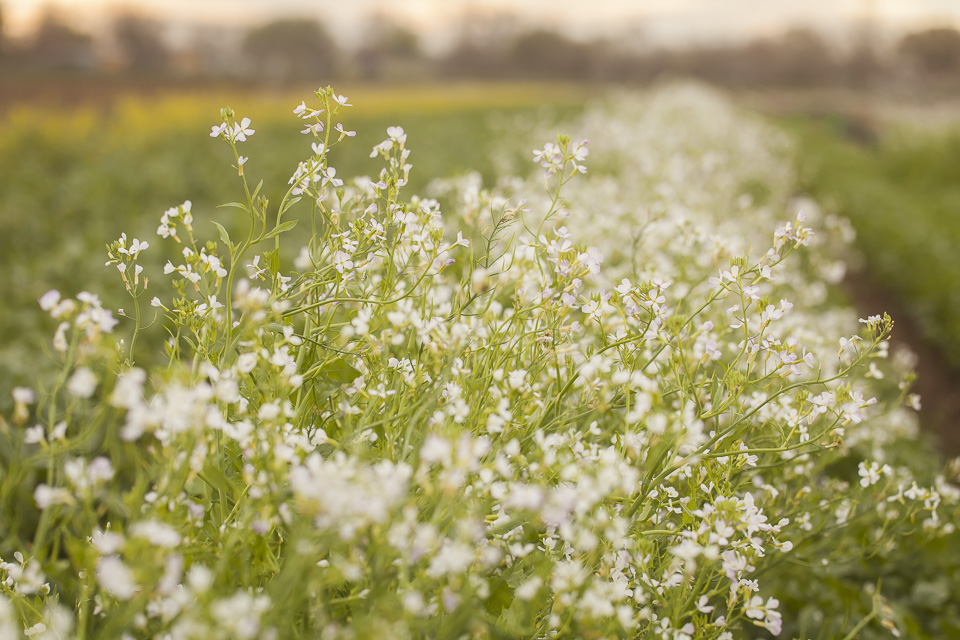 Photo by Scott David Gordon.
Photo by Scott David Gordon.
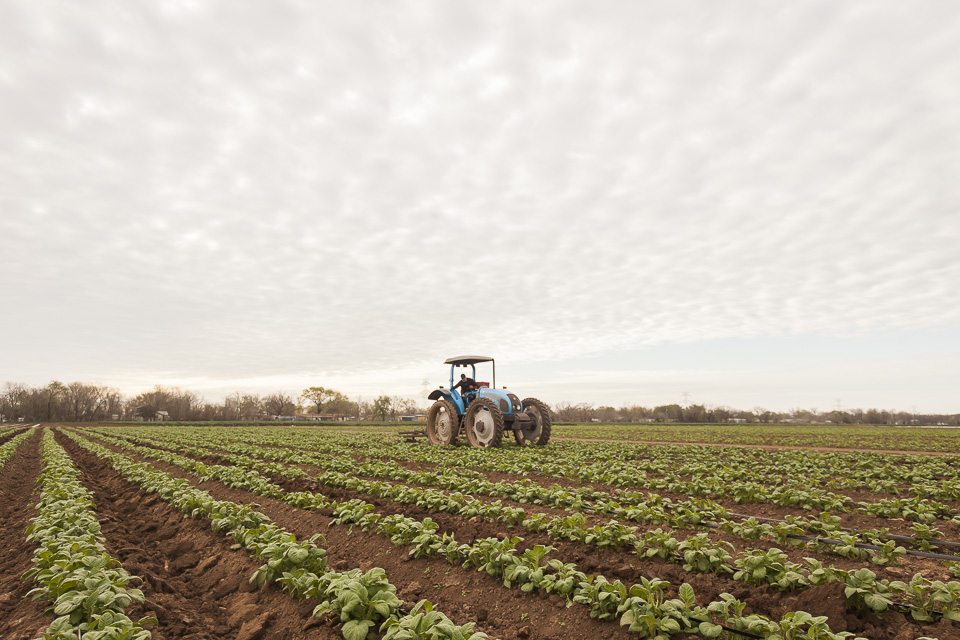 Photo by Scott David Gordon.
Photo by Scott David Gordon.
 Do you have the Spring Picnic and Garden Gallop on your calendar yet? Photo by Scott David Gordon.
Do you have the Spring Picnic and Garden Gallop on your calendar yet? Photo by Scott David Gordon.STUMPED BY STORAGE? HOW TO MAKE THE MOST OF YOUR CSA THIS YEAR!
03/16/18 — Heydon Hatcher
Joining the CSA can be an immensely rewarding experience. It gets folks in touch with the seasons, their region, and directly contributes to the wellbeing of the local community. Despite all the wonderful pros, it can be quite a daunting task to take on unfamiliar fruits and veggies when you unveil your weekly haul. It forces you to try new cooking techniques, attempt new recipes, and get to know the seasonality and personalities of so many veggies. On top of that, storage of these veggies can be a giant challenge on its own. Do I keep the tomatoes in the fridge? Do the collards need to be covered? How long do certain things stay fresh? Smart storage is an integral skill in order to ensure the longevity of our farm-fresh veggies for all those adventurous recipes you have planned for the week.
![]() Ada readying her herbs for the fridge. Photo by Scott David Gordon.
Ada readying her herbs for the fridge. Photo by Scott David Gordon.
Some veggies prefer room temperature, while others prefer dark, cool cabinets. Some are sensitive to light and ethylene (a maturing agent that some veggies emit), while others need to have their stems emerged in water in the fridge. In the list below, we dive into all the nuances of veggie care. Take a peek!![]() Bag options. Photo by Scott David Gordon.
Bag options. Photo by Scott David Gordon.
![]() Ada's frozen goods to prolong seasons and circumvent waste. Photo by Scott David Gordon.
Ada's frozen goods to prolong seasons and circumvent waste. Photo by Scott David Gordon.
![]() Ada's compost pile. Photo by Scott David Gordon.
Ada's compost pile. Photo by Scott David Gordon.
Broccoli + Cauliflower - Get these yummy crops into a baggy or container in the refrigerator’s crisper drawer, and they should be good for a week.
Bulk Roots (rutabagas, radishes, turnips, beets without greens attached) - If greens are attached, remove and then store in the refrigerator in a bag or container of some sort to keep the moisture in. Beets can last up to 3 weeks, radishes can last up to 2 weeks, and lastly, turnips and rutabagas can last up to 2 weeks. The greens of beets and turnips should be enjoyed within 3 days of being trimmed, and stored in a container or bag after being cleaned and dried.
Carrots - Cut off the greens if they come bunched (Make pesto with the greens!) and put in a container or bag in the crisper drawer, and these tasty snack veggies will last about 2 to 3 weeks.
![]() Carrots and beets getting greens chopped off. Photo by Scott David Gordon.
Carrots and beets getting greens chopped off. Photo by Scott David Gordon.
Cucumbers - This summertime sweetheart should be stored at room temperature, if it is stored anywhere below 50 degrees, it sustains “chilling injuries,” like pitting and accelerated decay. Keep them away from tomatoes, melons, and bananas, which emit ethylene (a maturing agent) since cucumbers are highly sensitive to it.
Eggplant - Similar to the cucumber, this nightshade stores well on the countertop. If your kitchen runs hotter than typical room temperature, it would be beneficial to store this veggie in a dark cupboard. It should keep for 2 to 5 days. Be sure to keep away from high ethylene producing vegetables! Eggplants are sensitive like the aforementioned cucumbers to this chemical.
Cabbage - This should be stored in a bag or container, in the crisper drawer. In these conditions, these crispy greens will last about 2 weeks.
Potatoes - Put these in a paper bag in a dark pantry, and they can last a month! Be sure air can circulate around them.
![]() Potatoes in a sack. Photo by Scott David Gordon.
Potatoes in a sack. Photo by Scott David Gordon.
Salad Greens (arugula, spinach, romaine, loose-leaf lettuce) - If these come in a little dirty, don't be alarmed. For easiest meal prep, you can wash these when you get them; however, make sure that they're completely dried before you put them in the fridge! Any water left on these leafy greens will turn them into slime. There are two great ways to ensure dryness. First off, a salad spinner - for the fall and winter seasons, this kitchen tool is well worth it and a huge time-saver. You can always use the bowl for other functions, too! If a salad spinner isn’t your speed, another good way to dry greens is by laying them out on a tea towel and wrapping them in the towel until they are good and dry. For especially muddy greens (sometimes our low-growing spinach comes in pretty muddy), you can dunk these in a bowl of water. Pro ecological tip: reuse water to water a houseplant! These should remain fresh for about 10 days.
![]() Salad spinner. Photo by Scott David Gordon.
Salad spinner. Photo by Scott David Gordon.
![]() Drying out greens via tea towel. Photo by Scott David Gordon.
Drying out greens via tea towel. Photo by Scott David Gordon.
Side note: if your greens show up looking wilted, refresh them and bring them back to life! This is easily done by soaking them in water, storing them in the fridge with a bag over them or lightly covered with plastic. Store them in the fridge like this until they look better. Then take them out, let the bottoms dry out, and store in a bag or container.
Kohlrabi - Cut the leaves off the bulb (you can eat the greens! Clean and use within three days), scrub the bulb, and place in a container or bag in the crisper drawer. These should keep for about a week.
Leeks - Trim the dark ends, and keep the roots intact. Place in a container or bag, get them in the refrigerator, and they should last about a week.
Melons - To ripen melons, keep in a paper bag on your kitchen counter. Once it starts to smell slightly sweet and give around the stem when pressed, put into the fridge. Once they are ripe, eat these fruits ASAP! You can keep them in the fridge for up to 5 days. Once cut, keep exposed flesh covered in plastic. Cut melons should keep for up to 3 days.
Watermelon - Keep these summertime darlings in the fridge. This melon, once off the vine, will ripen no further. Storing these melons in the cold also make them that much more refreshing once you cut them open. Uncut, watermelons stay fresh for 2 to 3 weeks. Once cut, cover the exposed fleshy side in plastic and keep in the fridge. It will remain fresh for up to three days.
Herbs (parsley, cilantro) - Treat these like bunched greens. If they need refreshing, you can trim the stems and place in a cup of water. Once sufficiently refreshed, store these in a lightly sealed bag in the crisper drawer. They should store for about a week.
![]() Herbs getting a good soak. Photo by Scott David Gordon.
Herbs getting a good soak. Photo by Scott David Gordon.
Okra - Store in a bag or container or wrap in a paper towel and place in a perforated bag, then place the fresh okra in the fridge (make sure that the okra is dry after washing before storing them in the fridge, can lead to slimy mold if not dry). This veggie should last about 3 days in these conditions.
Onions - Place in a dark pantry, and these hardy bulbs should last about 1 to 2 months! Make sure that air can circulate around them. If you cut into one of these, you should store in the fridge and use the rest within 3 to 4 days for maximum freshness.
Peppers - Get into a container or bag of some sort and into the fridge, and they should last about 5 days!
Bunched Greens (chard, beet greens, kale, collards, mustard greens) - These greens need to be trimmed at the bottom, washed, dried thoroughly before being bagged and/or placed in a container and into the crisper drawer. They should remain fresh for about a week.
![]() Chopping chard. Photo by Scott David Gordon.
Chopping chard. Photo by Scott David Gordon.
![]() Kale bath. Photo by Scott David Gordon.
Kale bath. Photo by Scott David Gordon.
Side note: If your bunched greens are looking sad when you get them, you can easily refresh them! Follow tips listed in "Salad Greens" for the 411 on that procedure.
Summer Squash - Place in a plastic bag or closed container like a tupperware and keep in the fridge. This summertime crop will last about 5 days in these conditions.
Sweet Potatoes - In a paper bag in a dark pantry, these 'taters will last about 2 weeks.
Tomatoes - These divas prefer storage on the countertop. If you have a well-vented container, tomatoes love to live in those. For quicker ripening, put in a paper bag so ethylene can build up (this is the chemical that causes ripening and acts as a maturing agent). These will store for 3-5 days.
Winter Squash (butternut, acorn) - These gourds love to be unwrapped in a dark, cool pantry. In these conditions, they will store for about a month.
![]() Veggies ready for the week in the crisper drawer. Photo by Scott David Gordon.
Veggies ready for the week in the crisper drawer. Photo by Scott David Gordon.
We hope this helps in your weekly CSA adventures! 'Til next time.
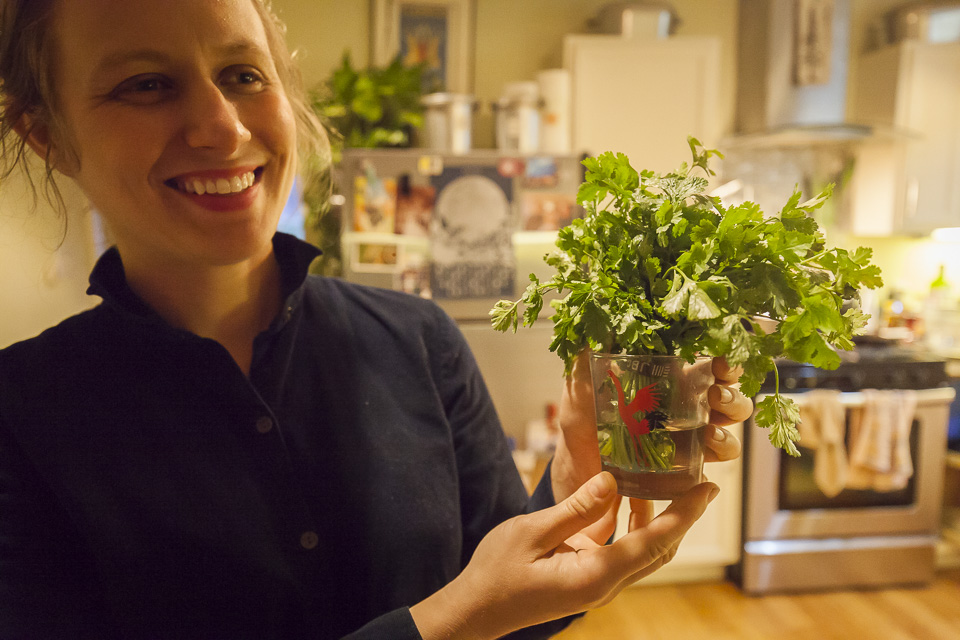 Ada readying her herbs for the fridge. Photo by Scott David Gordon.
Ada readying her herbs for the fridge. Photo by Scott David Gordon.
Some veggies prefer room temperature, while others prefer dark, cool cabinets. Some are sensitive to light and ethylene (a maturing agent that some veggies emit), while others need to have their stems emerged in water in the fridge. In the list below, we dive into all the nuances of veggie care. Take a peek!
Quick Pointers to Ponder
- When storing produce, any time that plants are left uncovered, they are going to lose moisture, and wilt. Putting them in a bag is a great way to retain humidity, and this pertains to a lot of different crops. It's important to separate the greens from the roots as the greens will continue to extract water from roots. Think: carrots/beets - the roots will stay firmer once the greens have been removed.
- One vital aspect of storage is temperature. Vegetables prefer different temperatures to grow in, and the same goes for storage. In the below list we mention: the refrigerator, the crisper drawer, dark cabinets, and the countertop. Refrigerators are obviously great options for storage, with the fridge crisper drawers being even better options with specific settings that control humidity levels, etc.
- In the list below, we mention “place them into a bag or a container” quite often. This deserves a little more elaboration, a container can mean a sealable glass or plastic tupperware, and a bag can mean a plastic bag, recycled produce bags from the grocery store, ziplocks, or even fancy mesh produce bags (shown in the picture below). *** Though the plastic bags might seem wasteful, please note that you can reuse them until they fall apart and the zippers break. New kale goes into the old kale bag… if you use a paper towel to wrap veggies, you can reuse it to wipe up a spill, so on and so forth.
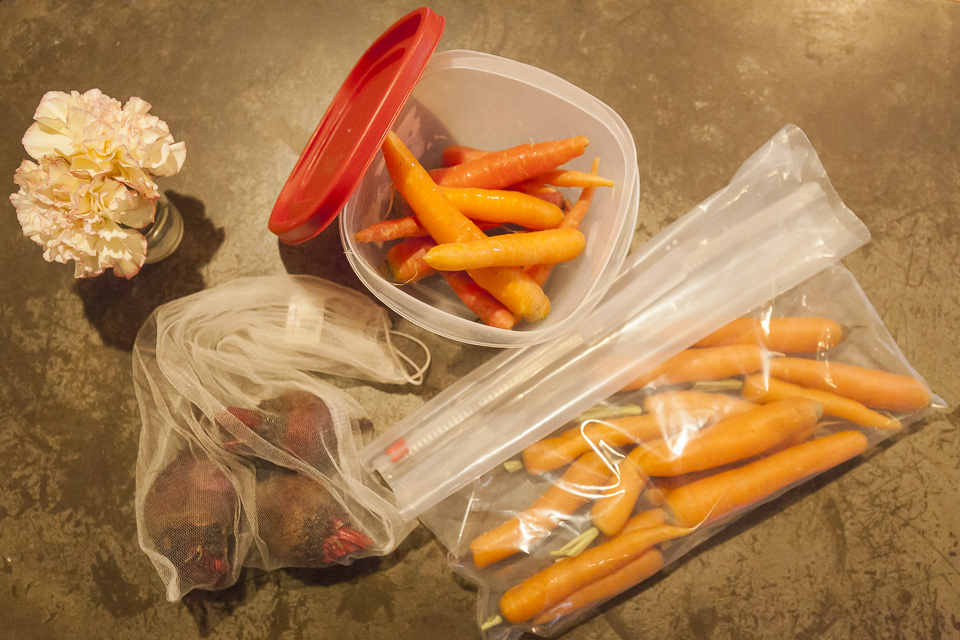 Bag options. Photo by Scott David Gordon.
Bag options. Photo by Scott David Gordon.
- Another pro-tip is to have long-term storage on the mind, and freeze produce! Too many beets and tomatoes? Longer term storage is a good way to extend the season. Blanching veggies and freezing them works well for a lot of different vegetables. For a bit more involved approach, you can also preserve and can! Quick pickling is also a great way to use excess veggies and is definitely easier than it sounds.
 Ada's frozen goods to prolong seasons and circumvent waste. Photo by Scott David Gordon.
Ada's frozen goods to prolong seasons and circumvent waste. Photo by Scott David Gordon.
- By adventuring outside the plate with new recipes, you can expand your palate, and also learn new delicious, staple recipes for years to come. Need a good resource for veggie-specific recipes? Check out our Pinterest board here!
- With just a little weekly prep, you can really change the way you cook during the week. Wash and cut your greens when you get your box, and you are more likely to use them in the week ahead.
- Feel like you are wasting tons of veggies week after week? One way to skip out on wasting veggies is to trade out those veggies you aren’t so keen on with ones you know you will use when you pick up your CSA at the market, or by using our customization feature online! If all else fails and you don’t get around to using all your veggies, COMPOST! Then, you’ll really know that your veggie waste is going to good use.
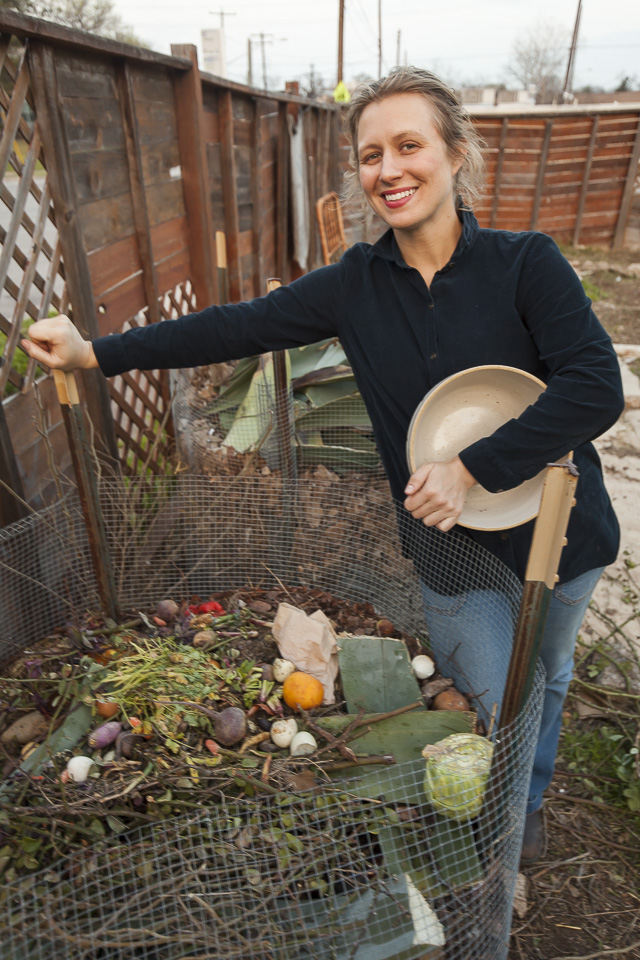 Ada's compost pile. Photo by Scott David Gordon.
Ada's compost pile. Photo by Scott David Gordon.
Storage Tips by Veggie
Basil - Tender and leafy herb. Place bunch in a cup of water and lightly cover entire bunch with a plastic bag. When you get your bunch, trim the bottom of the stems for best results. These do best on a countertop. Usually lasts around 5-7 days.Broccoli + Cauliflower - Get these yummy crops into a baggy or container in the refrigerator’s crisper drawer, and they should be good for a week.
Bulk Roots (rutabagas, radishes, turnips, beets without greens attached) - If greens are attached, remove and then store in the refrigerator in a bag or container of some sort to keep the moisture in. Beets can last up to 3 weeks, radishes can last up to 2 weeks, and lastly, turnips and rutabagas can last up to 2 weeks. The greens of beets and turnips should be enjoyed within 3 days of being trimmed, and stored in a container or bag after being cleaned and dried.
Carrots - Cut off the greens if they come bunched (Make pesto with the greens!) and put in a container or bag in the crisper drawer, and these tasty snack veggies will last about 2 to 3 weeks.
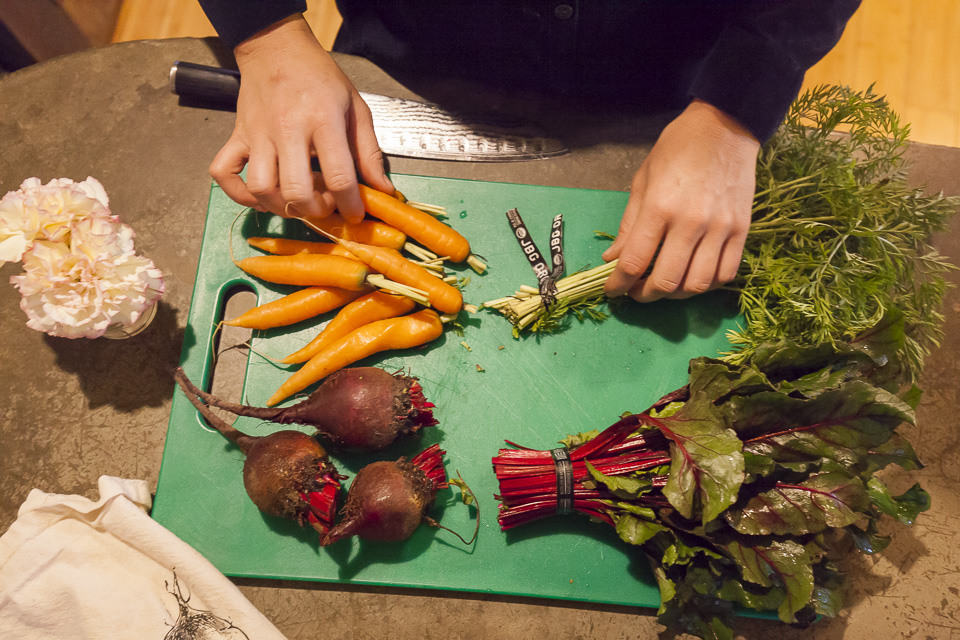 Carrots and beets getting greens chopped off. Photo by Scott David Gordon.
Carrots and beets getting greens chopped off. Photo by Scott David Gordon.
Cucumbers - This summertime sweetheart should be stored at room temperature, if it is stored anywhere below 50 degrees, it sustains “chilling injuries,” like pitting and accelerated decay. Keep them away from tomatoes, melons, and bananas, which emit ethylene (a maturing agent) since cucumbers are highly sensitive to it.
Eggplant - Similar to the cucumber, this nightshade stores well on the countertop. If your kitchen runs hotter than typical room temperature, it would be beneficial to store this veggie in a dark cupboard. It should keep for 2 to 5 days. Be sure to keep away from high ethylene producing vegetables! Eggplants are sensitive like the aforementioned cucumbers to this chemical.
Cabbage - This should be stored in a bag or container, in the crisper drawer. In these conditions, these crispy greens will last about 2 weeks.
Potatoes - Put these in a paper bag in a dark pantry, and they can last a month! Be sure air can circulate around them.
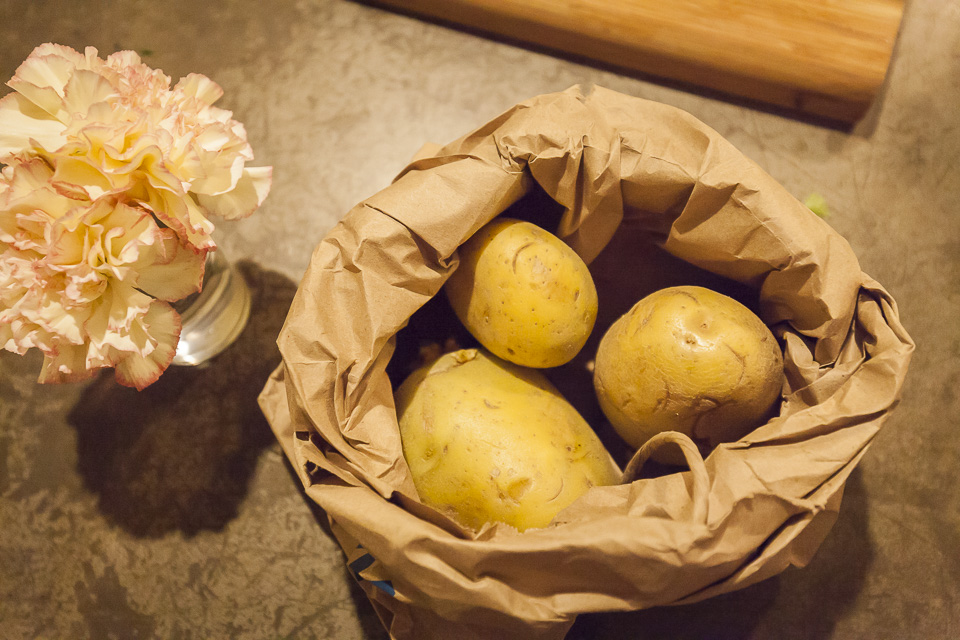 Potatoes in a sack. Photo by Scott David Gordon.
Potatoes in a sack. Photo by Scott David Gordon.
Salad Greens (arugula, spinach, romaine, loose-leaf lettuce) - If these come in a little dirty, don't be alarmed. For easiest meal prep, you can wash these when you get them; however, make sure that they're completely dried before you put them in the fridge! Any water left on these leafy greens will turn them into slime. There are two great ways to ensure dryness. First off, a salad spinner - for the fall and winter seasons, this kitchen tool is well worth it and a huge time-saver. You can always use the bowl for other functions, too! If a salad spinner isn’t your speed, another good way to dry greens is by laying them out on a tea towel and wrapping them in the towel until they are good and dry. For especially muddy greens (sometimes our low-growing spinach comes in pretty muddy), you can dunk these in a bowl of water. Pro ecological tip: reuse water to water a houseplant! These should remain fresh for about 10 days.
 Salad spinner. Photo by Scott David Gordon.
Salad spinner. Photo by Scott David Gordon.
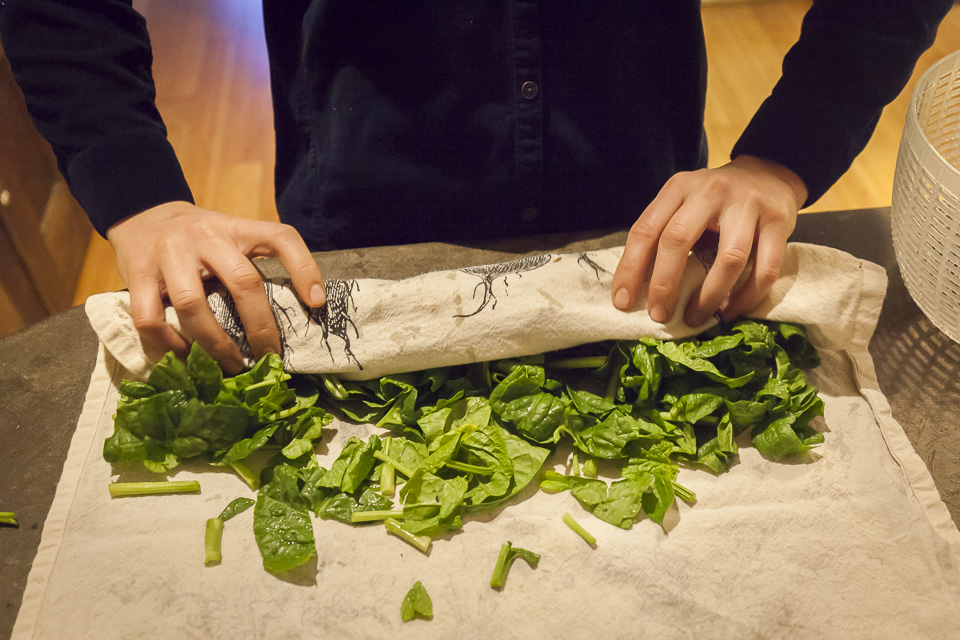 Drying out greens via tea towel. Photo by Scott David Gordon.
Drying out greens via tea towel. Photo by Scott David Gordon.
Side note: if your greens show up looking wilted, refresh them and bring them back to life! This is easily done by soaking them in water, storing them in the fridge with a bag over them or lightly covered with plastic. Store them in the fridge like this until they look better. Then take them out, let the bottoms dry out, and store in a bag or container.
Kohlrabi - Cut the leaves off the bulb (you can eat the greens! Clean and use within three days), scrub the bulb, and place in a container or bag in the crisper drawer. These should keep for about a week.
Leeks - Trim the dark ends, and keep the roots intact. Place in a container or bag, get them in the refrigerator, and they should last about a week.
Melons - To ripen melons, keep in a paper bag on your kitchen counter. Once it starts to smell slightly sweet and give around the stem when pressed, put into the fridge. Once they are ripe, eat these fruits ASAP! You can keep them in the fridge for up to 5 days. Once cut, keep exposed flesh covered in plastic. Cut melons should keep for up to 3 days.
Watermelon - Keep these summertime darlings in the fridge. This melon, once off the vine, will ripen no further. Storing these melons in the cold also make them that much more refreshing once you cut them open. Uncut, watermelons stay fresh for 2 to 3 weeks. Once cut, cover the exposed fleshy side in plastic and keep in the fridge. It will remain fresh for up to three days.
Herbs (parsley, cilantro) - Treat these like bunched greens. If they need refreshing, you can trim the stems and place in a cup of water. Once sufficiently refreshed, store these in a lightly sealed bag in the crisper drawer. They should store for about a week.
 Herbs getting a good soak. Photo by Scott David Gordon.
Herbs getting a good soak. Photo by Scott David Gordon.
Okra - Store in a bag or container or wrap in a paper towel and place in a perforated bag, then place the fresh okra in the fridge (make sure that the okra is dry after washing before storing them in the fridge, can lead to slimy mold if not dry). This veggie should last about 3 days in these conditions.
Onions - Place in a dark pantry, and these hardy bulbs should last about 1 to 2 months! Make sure that air can circulate around them. If you cut into one of these, you should store in the fridge and use the rest within 3 to 4 days for maximum freshness.
Peppers - Get into a container or bag of some sort and into the fridge, and they should last about 5 days!
Bunched Greens (chard, beet greens, kale, collards, mustard greens) - These greens need to be trimmed at the bottom, washed, dried thoroughly before being bagged and/or placed in a container and into the crisper drawer. They should remain fresh for about a week.
 Chopping chard. Photo by Scott David Gordon.
Chopping chard. Photo by Scott David Gordon.
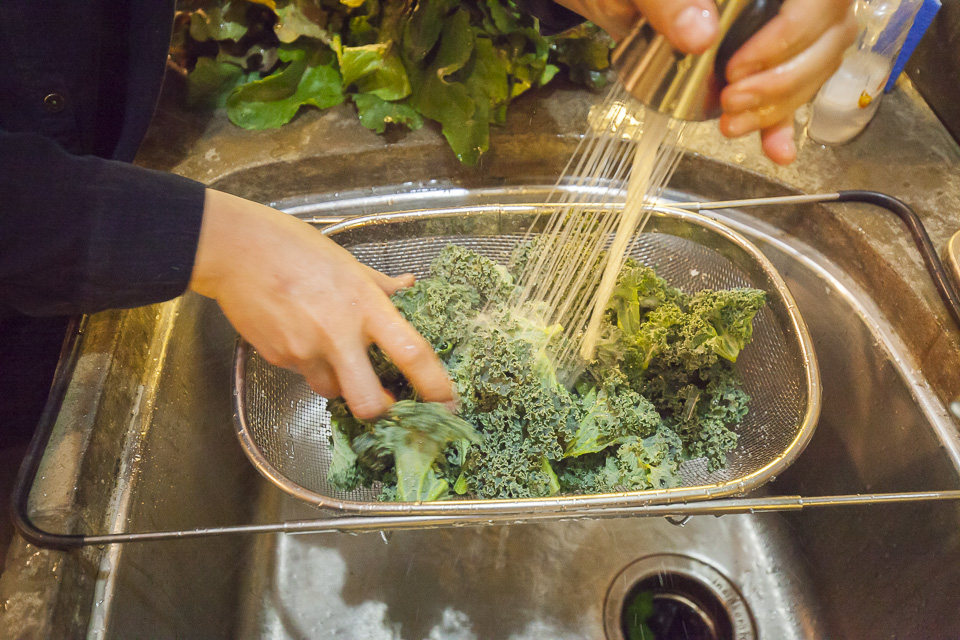 Kale bath. Photo by Scott David Gordon.
Kale bath. Photo by Scott David Gordon.
Side note: If your bunched greens are looking sad when you get them, you can easily refresh them! Follow tips listed in "Salad Greens" for the 411 on that procedure.
Summer Squash - Place in a plastic bag or closed container like a tupperware and keep in the fridge. This summertime crop will last about 5 days in these conditions.
Sweet Potatoes - In a paper bag in a dark pantry, these 'taters will last about 2 weeks.
Tomatoes - These divas prefer storage on the countertop. If you have a well-vented container, tomatoes love to live in those. For quicker ripening, put in a paper bag so ethylene can build up (this is the chemical that causes ripening and acts as a maturing agent). These will store for 3-5 days.
Winter Squash (butternut, acorn) - These gourds love to be unwrapped in a dark, cool pantry. In these conditions, they will store for about a month.
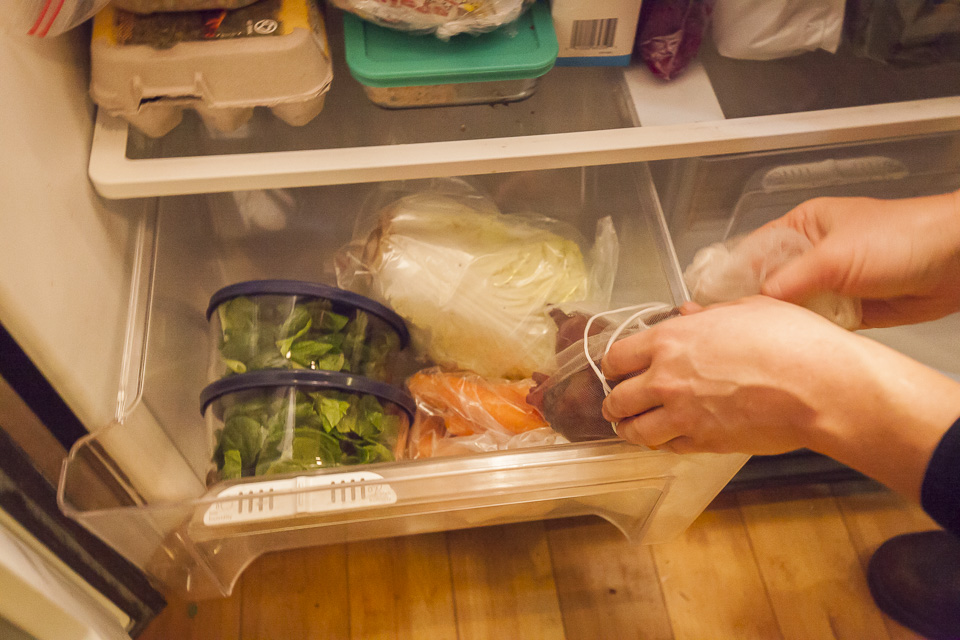 Veggies ready for the week in the crisper drawer. Photo by Scott David Gordon.
Veggies ready for the week in the crisper drawer. Photo by Scott David Gordon.
We hope this helps in your weekly CSA adventures! 'Til next time.
CSA BOX CONTENTS WEEK OF MAR 19TH
03/20/18 — Scott
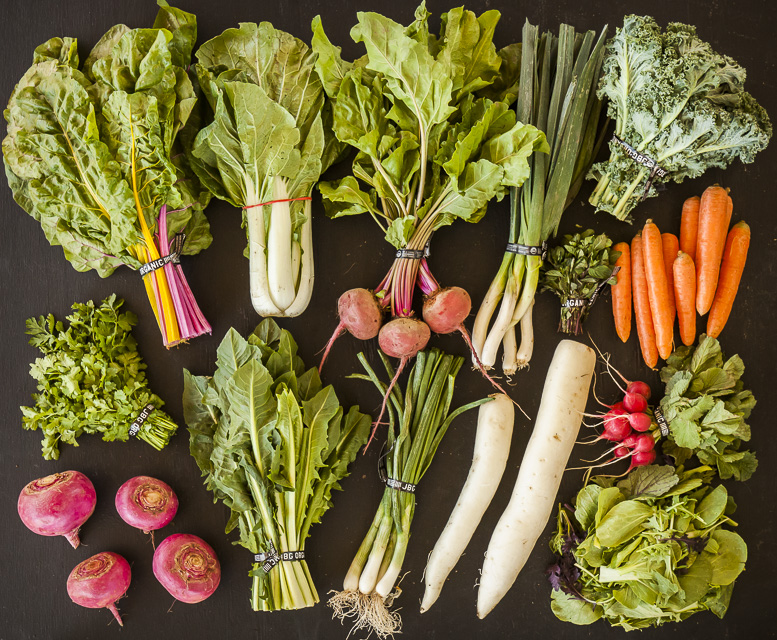 CSA Box Contents Week of Mar 19th
CSA Box Contents Week of Mar 19th
Large Box
Beet, Golden
Bok Choy, Baby
Carrot, Red
Greens, Chard, Rainbow
Greens, Kale, Curly
Greens, Mizuna
Herb, Cilantro
Leek
Lettuce, Romaine
Onion, Spring Yellow
Radish, French Breakfast
Turnip, White Japanese
Beet, Golden
Bok Choy, Baby
Carrot, Red
Greens, Chard, Rainbow
Greens, Kale, Curly
Greens, Mizuna
Herb, Cilantro
Leek
Lettuce, Romaine
Onion, Spring Yellow
Radish, French Breakfast
Turnip, White Japanese
Medium Box
Beet, Golden
Bok Choy
Carrot, Orange
Greens, Chard, Rainbow
Greens, Spinach
Herb, Cilantro
Lettuce, Romaine
Onion, Spring Yellow
Radish, French Breakfast
Turnip, White Japanese
Beet, Golden
Bok Choy
Carrot, Orange
Greens, Chard, Rainbow
Greens, Spinach
Herb, Cilantro
Lettuce, Romaine
Onion, Spring Yellow
Radish, French Breakfast
Turnip, White Japanese
Small Box
Beet, Red
Carrot, Orange
Greens, Chard, Rainbow
Leek
Lettuce, Romaine
Radish, Red
Turnip, Scarlett
Beet, Red
Carrot, Orange
Greens, Chard, Rainbow
Leek
Lettuce, Romaine
Radish, Red
Turnip, Scarlett
Individual Box
Beet, Red
Carrot, Orange
Greens, Dandelion
Greens, Spinach
Radish, Red
Beet, Red
Carrot, Orange
Greens, Dandelion
Greens, Spinach
Radish, Red
CSA BOX CONTENTS WEEK OF MAR 19TH
03/20/18 — Scott
 CSA Box Contents Week of Mar 19th
CSA Box Contents Week of Mar 19th
Large Box
Beet, Chioggia
Bok Choy
Carrot, Orange
Greens, Chard, Rainbow
Greens, Kale, Curly
Herb, Cilantro
Leek
Lettuce, Braising Mix
Onion, Spring Yellow
Radish, Daikon
Radish, Red
Turnip, Scarlett
ROASTED CARROTS WITH MISO-BROWN BUTTER
03/22/18 — Heydon Hatcher
Recipe and Image by Nadia Tamby
This sauce/ glaze is easy to make and stores for months in the fridge, so make extra to add to any roasted vegetables you like! I suggest doubling the miso and butter and storing it in a clean jar in the fridge. It is rich and savory – so a little goes a long way. I love the way the sweet carrots pair with the salty buttery sauce. Roast your carrots the way you like. For this dish I roast them more than I normally would so that the carrots are soft and creamy under a wrinkled crispy skin, but if you prefer your carrots more crunchy, then less time in the oven works as well.
Ingredients:![]()
Instructions:
Set your oven to 425F and line a large baking sheet with foil (this helps with clean up). Slice the tops off the carrots and slice them in half lengthwise. Don’t even bother peeling JBG carrots – the skin is so thin, it’s barely worth the effort (or the waste!). Arrange the carrots in a single layer cut-side up on the baking sheet, drizzle with salt, pepper, and olive oil and bake for about 25-30 minutes.
While your carrots are in the oven, make the sauce:
In a small saucepan (preferably light colored so you can monitor the color of the butter), add the butter and cook on medium heat until the butter appears brown (not too dark) and smells amazing. Immediately remove from the heat. In a small glass jar or bowl, add the miso paste and using a fork, mix the browned butter in. If the milk solids in your brown butter appear burned or too dark, simply strain them out before stirring it into the miso paste.
Serve your carrots on a platter and drizzle the miso-brown butter on top. Sprinkle the green onions on top and serve. This dish will be fine hot or at room temperature. Keep in mind that the butter will solidify when it’s cold, so it will still taste great but might not be as visually appealing.
This sauce/ glaze is easy to make and stores for months in the fridge, so make extra to add to any roasted vegetables you like! I suggest doubling the miso and butter and storing it in a clean jar in the fridge. It is rich and savory – so a little goes a long way. I love the way the sweet carrots pair with the salty buttery sauce. Roast your carrots the way you like. For this dish I roast them more than I normally would so that the carrots are soft and creamy under a wrinkled crispy skin, but if you prefer your carrots more crunchy, then less time in the oven works as well.
Ingredients:
- 2 lbs carrots
- 3 tablespoons miso paste (I use Miso Master Traditional Red Miso)
- 4 tablespoons butter
- Salt and pepper, to taste
- 1-2 thinly sliced scallions
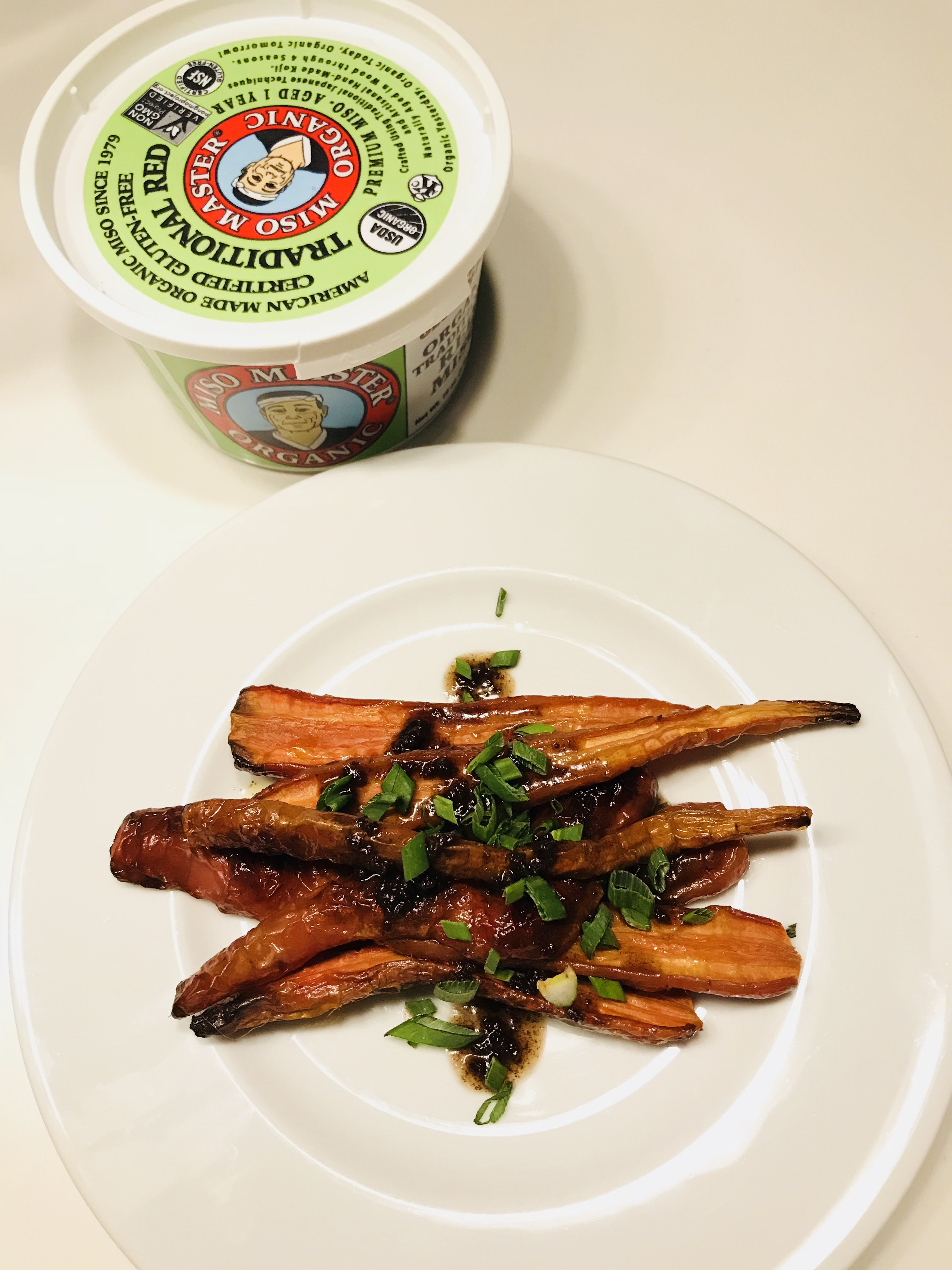
Instructions:
Set your oven to 425F and line a large baking sheet with foil (this helps with clean up). Slice the tops off the carrots and slice them in half lengthwise. Don’t even bother peeling JBG carrots – the skin is so thin, it’s barely worth the effort (or the waste!). Arrange the carrots in a single layer cut-side up on the baking sheet, drizzle with salt, pepper, and olive oil and bake for about 25-30 minutes.
While your carrots are in the oven, make the sauce:
In a small saucepan (preferably light colored so you can monitor the color of the butter), add the butter and cook on medium heat until the butter appears brown (not too dark) and smells amazing. Immediately remove from the heat. In a small glass jar or bowl, add the miso paste and using a fork, mix the browned butter in. If the milk solids in your brown butter appear burned or too dark, simply strain them out before stirring it into the miso paste.
Serve your carrots on a platter and drizzle the miso-brown butter on top. Sprinkle the green onions on top and serve. This dish will be fine hot or at room temperature. Keep in mind that the butter will solidify when it’s cold, so it will still taste great but might not be as visually appealing.
WEEK 12 IN PHOTOS
03/23/18 — Scott
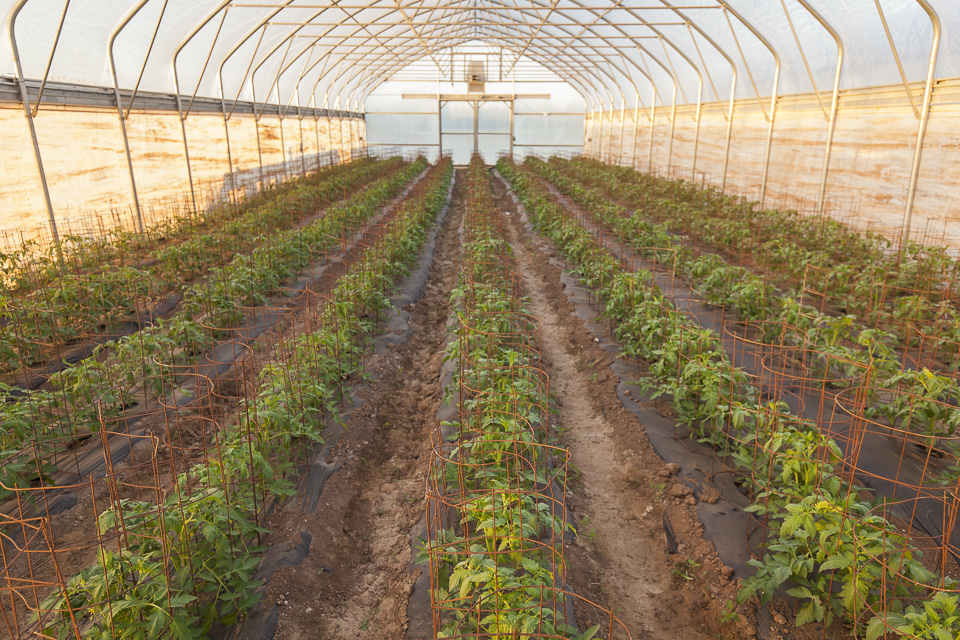
The farm is in full spring mode! We are planting our first round of melons and zucchinis, and our second round of tomatoes and peppers. Those hot-weather-lovin' crops are getting into the ground! We are starting to think about the tomato season, drinking a lot more water, and slathering on that sunscreen. Exciting new crops like leeks and spring onions are rolling in strong, too!
We are gearing up for the Spring Picnic and Garden Gallop 5K next Saturday, 3/31. The last of the transplants are headed to markets this weekend, so head on over to your favorite weekend market to grab some! We also donated a boatload of transplants to SFC's Resource Giveaway Day this week. An awesome biannual event that benefits school and community gardens all around town.
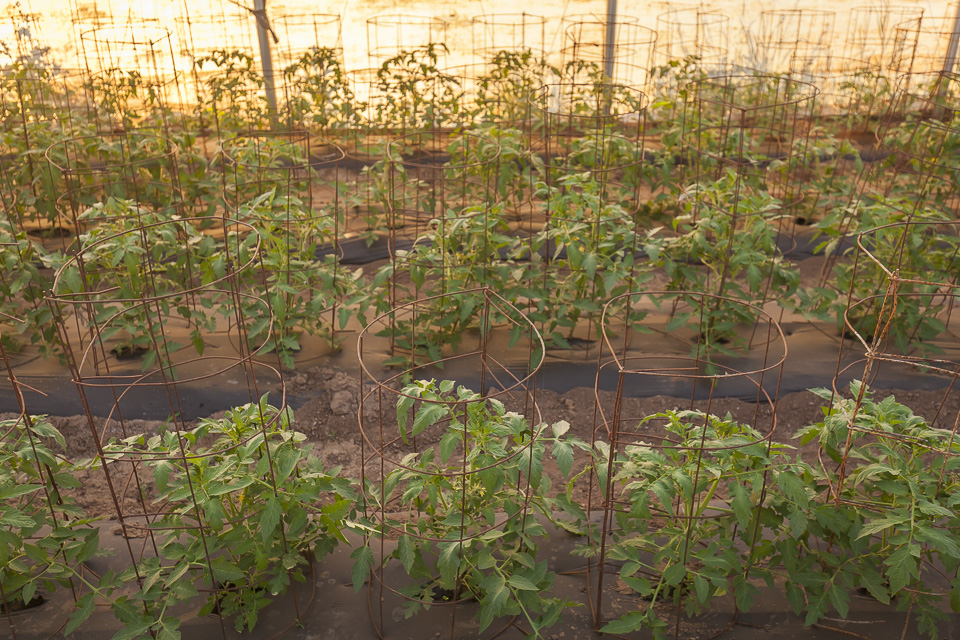
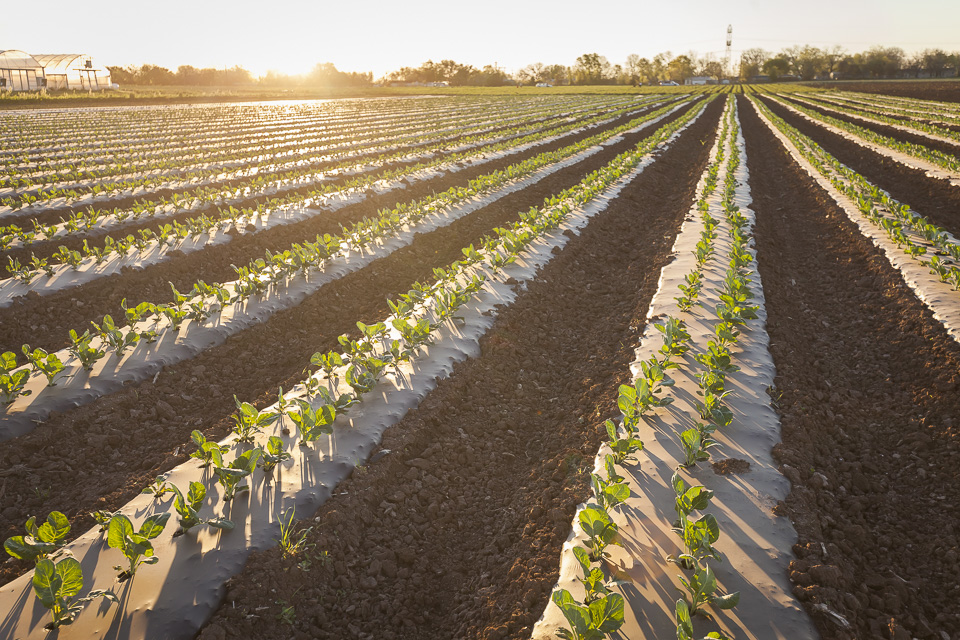
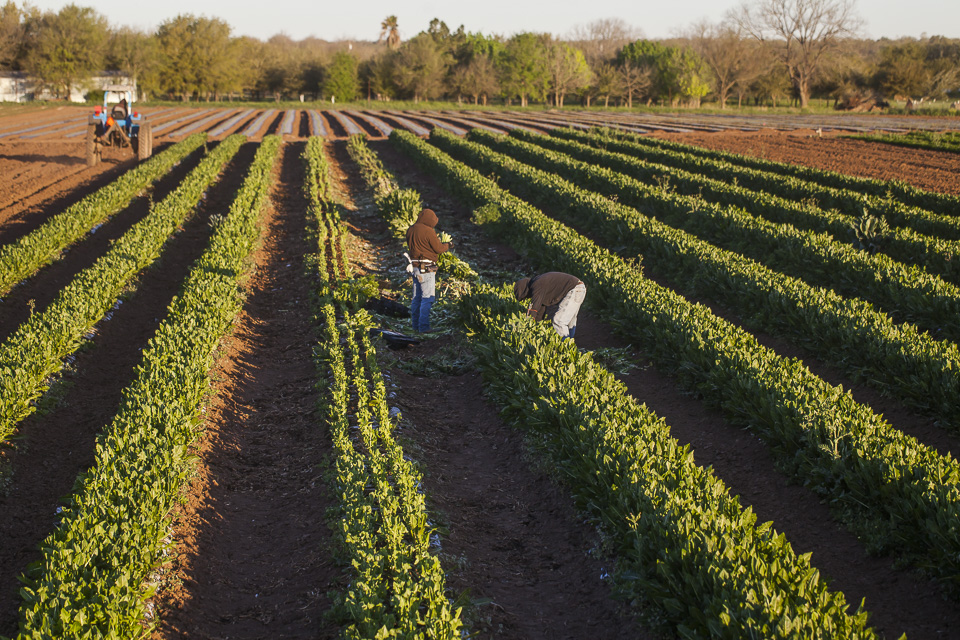
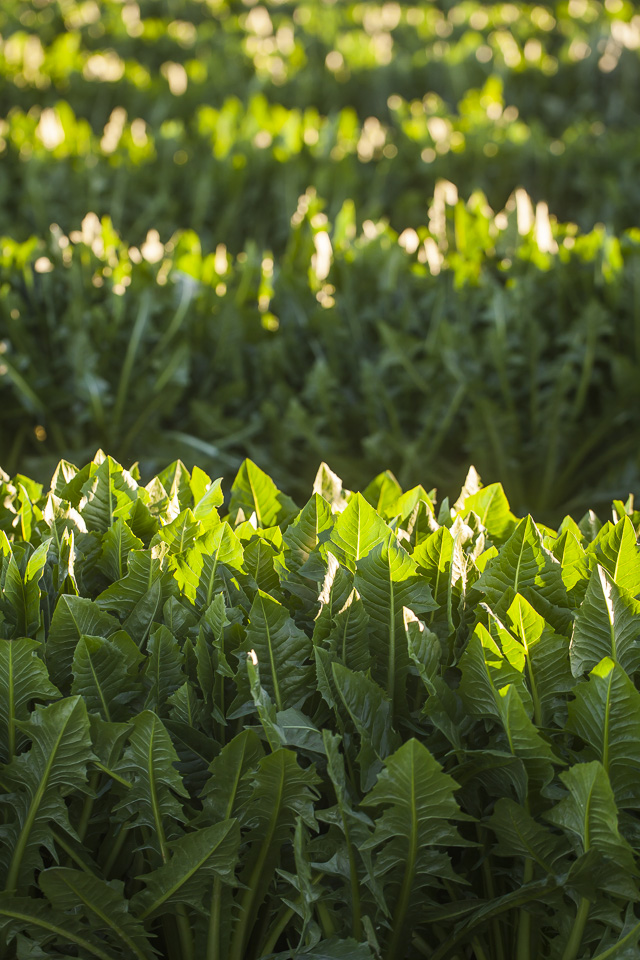
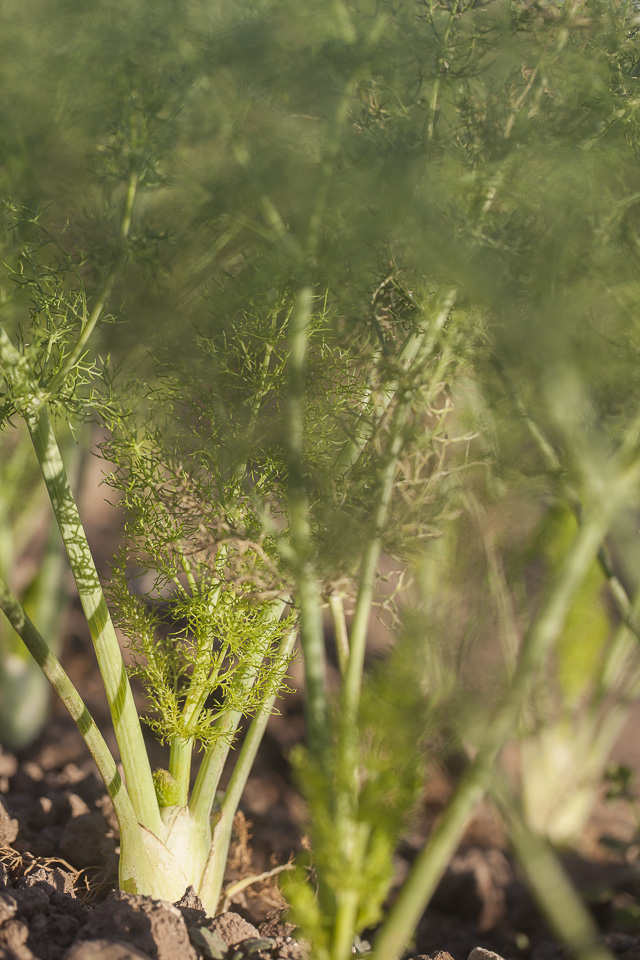
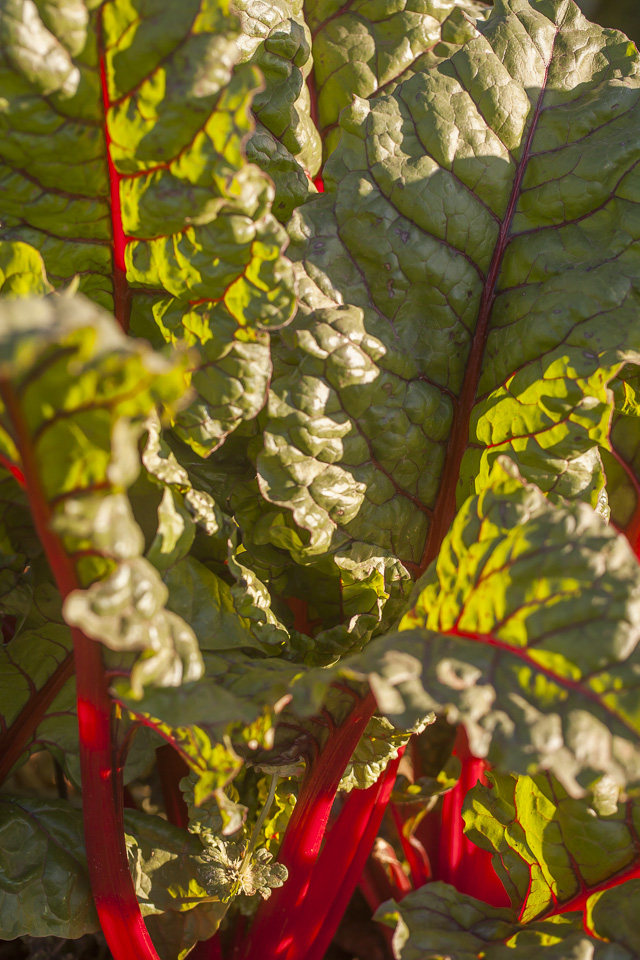
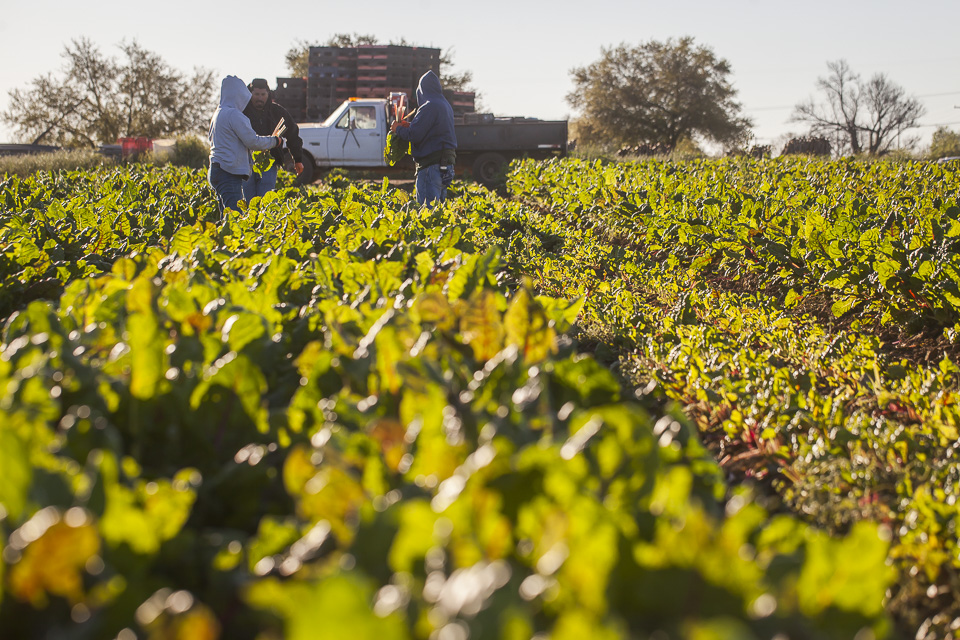
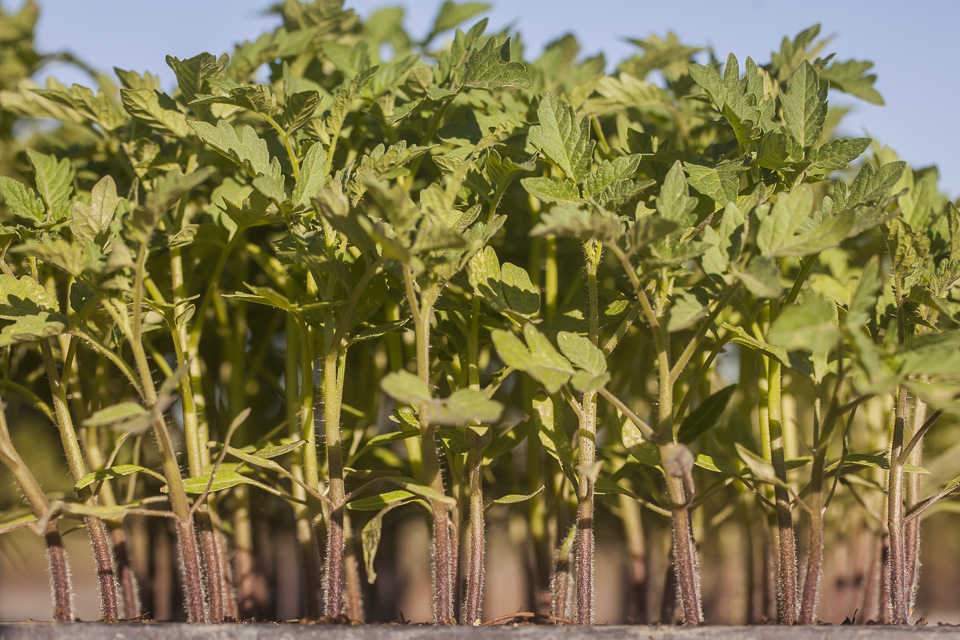

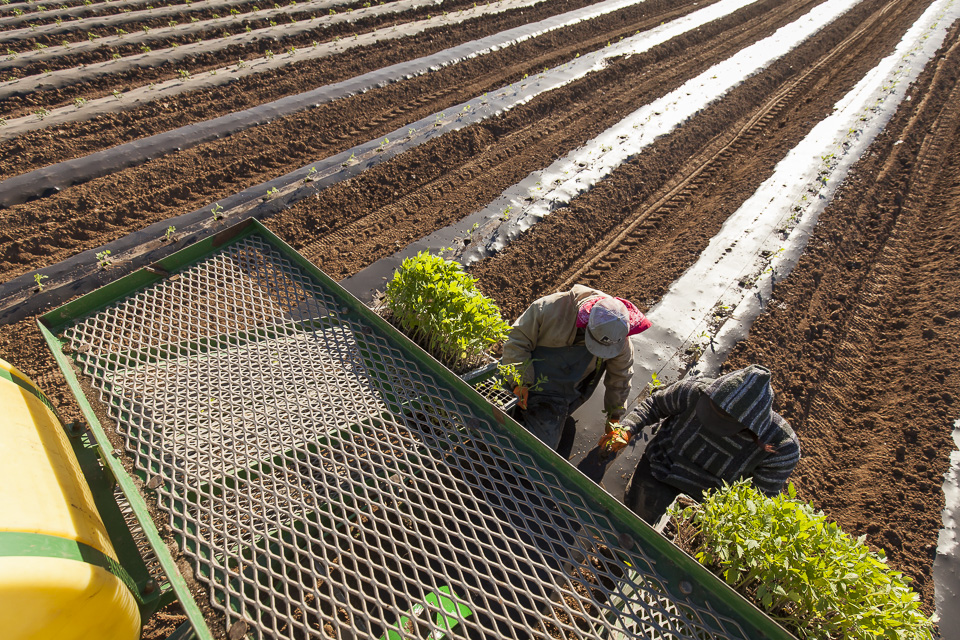
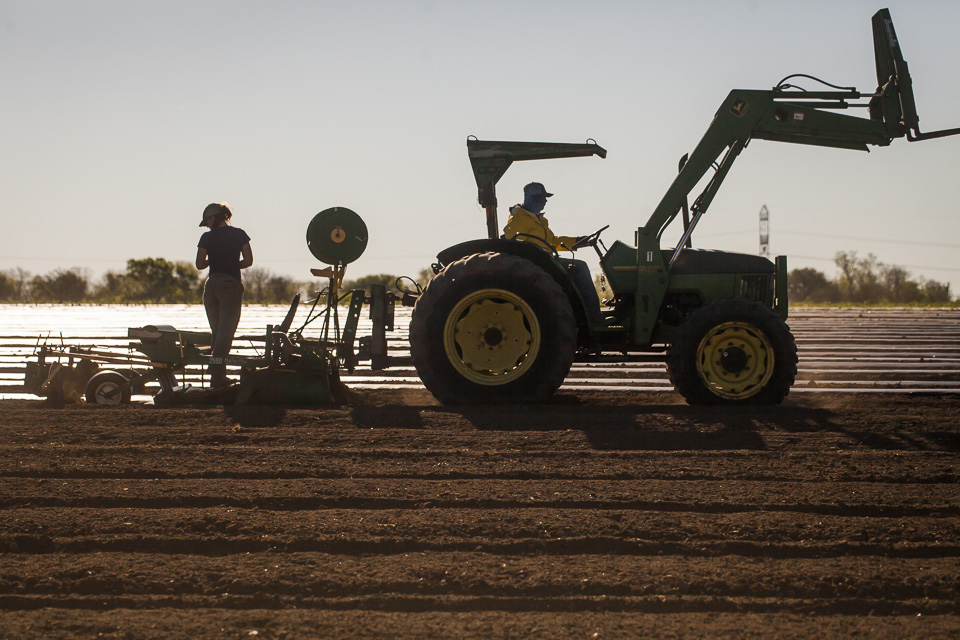
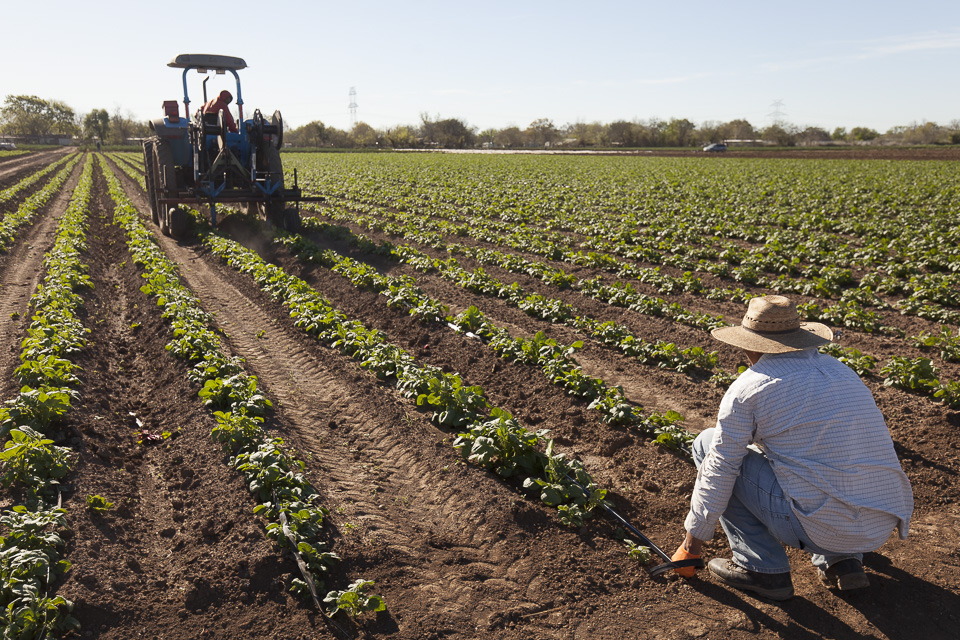
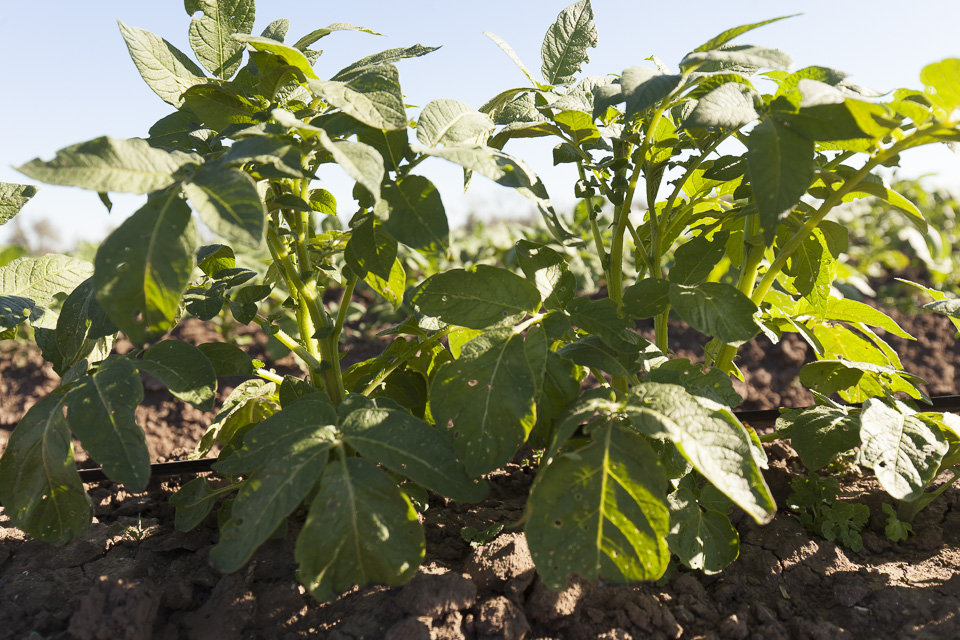

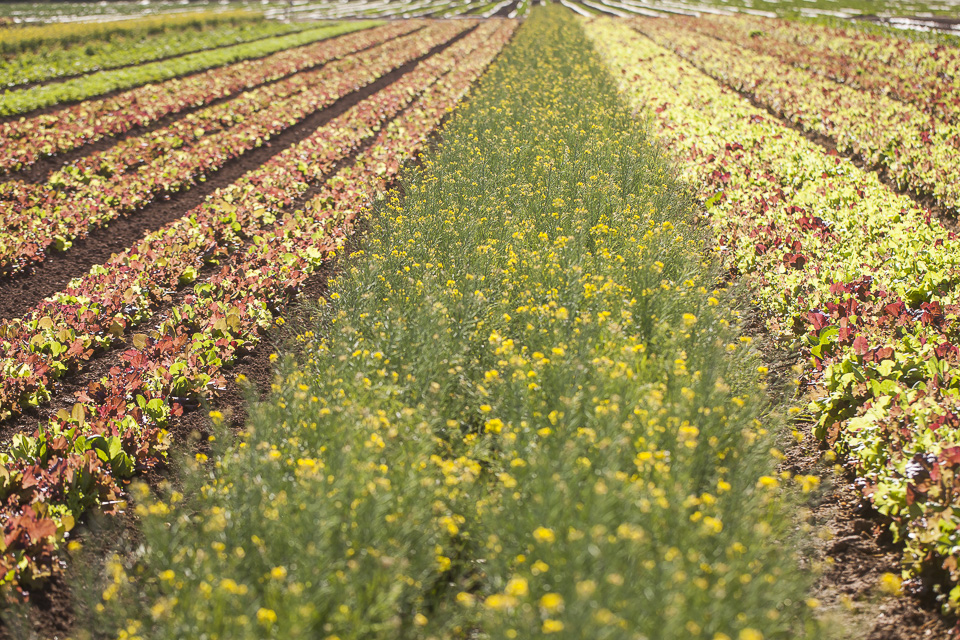

GET THE DIRT ON THE SPRING PICNIC AND GARDEN GALLOP 5K - NEXT SATURDAY, 3/31!
03/23/18 — Heydon Hatcher
Have you heard? Our annual Spring Picnic and Garden Gallop 5K is just around the corner. This is one of our most favorite farm events, and if you come join us next Saturday, 3/31 from 11:30 am to 2:30 pm, you’ll see why! Adult tickets are only $5. As always, kids under 12 get in free. This event will take place at our Garfield, Texas farm nestled on the banks of the Colorado River at 4008 River Road, 78612.
![]() Winners of a Garden Gallop past. Photo by Scott David Gordon.
Winners of a Garden Gallop past. Photo by Scott David Gordon.
Our 5K Garden Gallop and 1-mile Kids Fun Run is perfect for runners and walkers alike and is truly the best way to see our working organic farm. Is there anything like this event anywhere else? We’re not so sure, but it sure is a unique and wonderful community event. Skip past our compost pile, jog through towers of tomatoes, and celebrate the season with your friends and family. Worried about the length of the 3.1-mile route? Take a shortcut! No one judges out at the farm. Have a baby to haul along? Bring your off-road stroller! It’s called a Garden Gallop, but we absolutely welcome the avid walker with open arms, as we have a quite a few amblin' aficionados on staff here at JBG. It usually takes about 45 minutes to an hour to complete the route while moseying along, obviously varying depending on your personal pace.
![]() Gettin' ready to run. Photo by Scott David Gordon.
Gettin' ready to run. Photo by Scott David Gordon.
We can't wait to share our lush fields of carrots and rows of budding Spring crops. It’s a great way to sneak a peek of what veggies are headed to market in the coming weeks. Steve and his crew at Rogue Running will be there metamorphosing our bustling farm into a dynamic race course complete with aid stations and cheerleaders at several junctures along the way. We will be starting the 5K at 11 am sharp, so arrive at least at 10:30 in order to gather your bib and stretch before we officially start the race! The first place male and female will both be awarded CSA subscriptions. So get your running shoes on and get to trainin’, there are veggies to win!
![]() Ready to run! Photo by Scott David Gordon.
Ready to run! Photo by Scott David Gordon.
![]() On the course. Photo by Scott David Gordon.
On the course. Photo by Scott David Gordon.
OR, skip the Gallop all together and bust out your best picnic blanket. There will be live music by Johnny Nicholas & Scrappy Jud Newcomb as well as Oscar Ornelas who will be performing blues on our butterfly stage. A huge thanks to The ABGB for providing free beer for the musicians. We don’t know how we’d quench ours or the musicians’ thirst without you, time and time again. For the kiddos, we'll have an "egg" hunt and loads of arts and crafts activities. Speaking of, we headed to the Austin Materials Marketplace last week to rescue some of the leftover SXSW materials that were headed to a landfill from the expo center. We are repurposing the found materials so that kiddos can paint and express their inner Picasso. Pretty cool, eh!? On top of that, our ever-popular sand pile is ready to be conquered. A huge thanks to Marcelo’s Sand and Loam for donating a load of sand to spruce up our dwindling sand supply. Do you or your kiddo want to know more about tractors and/or what it feels like to be at the helm of one? We will have all of our tractors lined up on display with information on what each one of them specializes in day-to-day. You and your kids will be able to climb up into the driver’s seat and experience farmer-vision behind the wheel.
![]() Arts and crafts. Photo by Scott David Gordon.
Arts and crafts. Photo by Scott David Gordon.
![]() Tractor vision. Photo by Scott David Gordon.
Tractor vision. Photo by Scott David Gordon.
![]() Sand pile good times. Photo by Scott David Gordon.
Sand pile good times. Photo by Scott David Gordon.
The Ginger Armadillo food trailer will be on site serving their delicious "elevated Texas cuisine". Think: BBQ Pork Tacos, Crispy Harvest Cakes, Black Bean Frito Pies, BBQ Beet Fries, Brussels Slaw, Kale Caesar Salad, and Rainbow Slaw! They are slinging only the most delicious fares and featuring our organic veggies as much as possible. Chameleon Cold Brew will be there making sure everyone is caffeinated with free coffee and samples of their notorious cold-brew. They will also be lugging out their giant Jenga tower and cornhole. Yeehaw! This event is BYOB, BYO-picnic blanket, BYO-dancin' shoes, BYO-good vibes. Please DON'T BYO-DOG though! We love your pups, but our farmers prefer you keep them at home. Grappling with heading to market to swoop your weekly veggie haul or to make it out to the event in Garfield? We will have a market stand set up at the event! CSA members, rather pick up your CSA at the Spring Picnic? Shoot us an email at farm@jbgorganic.com or call us at 512-386-5273 and we will get it scheduled. See you at the farm!
![]() Ginger Armadillo food truck! Photo by Scott David Gordon.
Ginger Armadillo food truck! Photo by Scott David Gordon.
![]() Gettin' down! Photo by Scott David Gordon.
Gettin' down! Photo by Scott David Gordon.
![]() Picnic-in' Photo by Scott David Gordon.
Picnic-in' Photo by Scott David Gordon.
![]() Market stand. Photo by Scott David Gordon.
Market stand. Photo by Scott David Gordon.
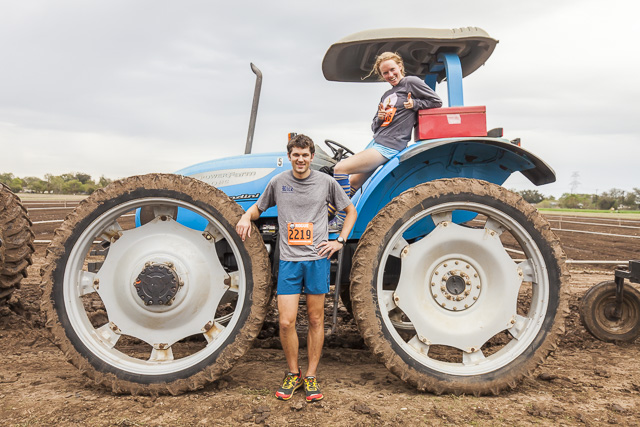 Winners of a Garden Gallop past. Photo by Scott David Gordon.
Winners of a Garden Gallop past. Photo by Scott David Gordon.
Our 5K Garden Gallop and 1-mile Kids Fun Run is perfect for runners and walkers alike and is truly the best way to see our working organic farm. Is there anything like this event anywhere else? We’re not so sure, but it sure is a unique and wonderful community event. Skip past our compost pile, jog through towers of tomatoes, and celebrate the season with your friends and family. Worried about the length of the 3.1-mile route? Take a shortcut! No one judges out at the farm. Have a baby to haul along? Bring your off-road stroller! It’s called a Garden Gallop, but we absolutely welcome the avid walker with open arms, as we have a quite a few amblin' aficionados on staff here at JBG. It usually takes about 45 minutes to an hour to complete the route while moseying along, obviously varying depending on your personal pace.
 Gettin' ready to run. Photo by Scott David Gordon.
Gettin' ready to run. Photo by Scott David Gordon.
We can't wait to share our lush fields of carrots and rows of budding Spring crops. It’s a great way to sneak a peek of what veggies are headed to market in the coming weeks. Steve and his crew at Rogue Running will be there metamorphosing our bustling farm into a dynamic race course complete with aid stations and cheerleaders at several junctures along the way. We will be starting the 5K at 11 am sharp, so arrive at least at 10:30 in order to gather your bib and stretch before we officially start the race! The first place male and female will both be awarded CSA subscriptions. So get your running shoes on and get to trainin’, there are veggies to win!
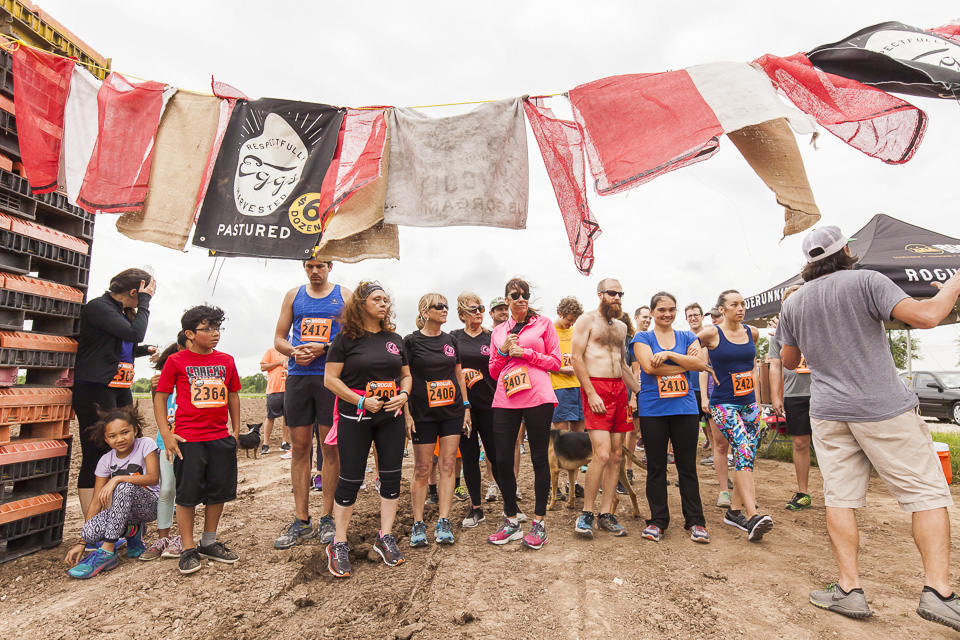 Ready to run! Photo by Scott David Gordon.
Ready to run! Photo by Scott David Gordon.
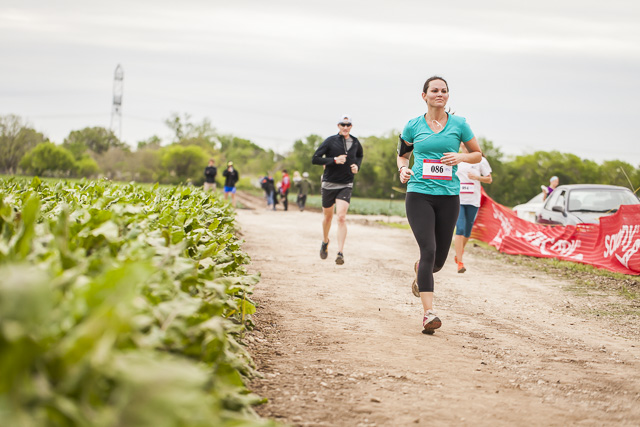 On the course. Photo by Scott David Gordon.
On the course. Photo by Scott David Gordon.
OR, skip the Gallop all together and bust out your best picnic blanket. There will be live music by Johnny Nicholas & Scrappy Jud Newcomb as well as Oscar Ornelas who will be performing blues on our butterfly stage. A huge thanks to The ABGB for providing free beer for the musicians. We don’t know how we’d quench ours or the musicians’ thirst without you, time and time again. For the kiddos, we'll have an "egg" hunt and loads of arts and crafts activities. Speaking of, we headed to the Austin Materials Marketplace last week to rescue some of the leftover SXSW materials that were headed to a landfill from the expo center. We are repurposing the found materials so that kiddos can paint and express their inner Picasso. Pretty cool, eh!? On top of that, our ever-popular sand pile is ready to be conquered. A huge thanks to Marcelo’s Sand and Loam for donating a load of sand to spruce up our dwindling sand supply. Do you or your kiddo want to know more about tractors and/or what it feels like to be at the helm of one? We will have all of our tractors lined up on display with information on what each one of them specializes in day-to-day. You and your kids will be able to climb up into the driver’s seat and experience farmer-vision behind the wheel.
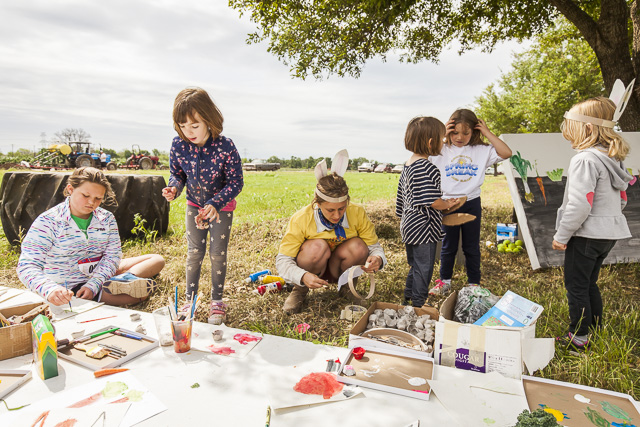 Arts and crafts. Photo by Scott David Gordon.
Arts and crafts. Photo by Scott David Gordon.
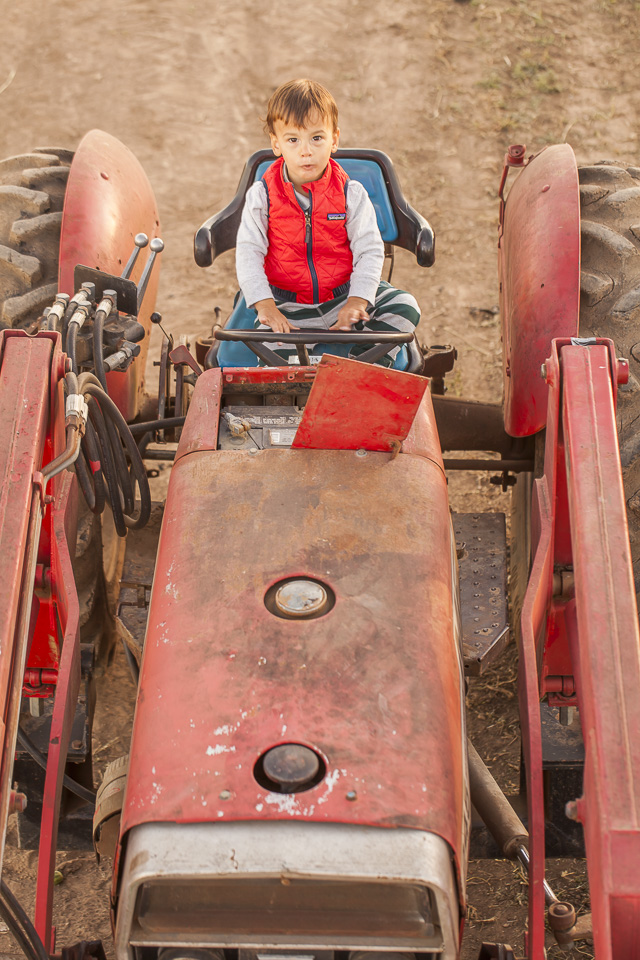 Tractor vision. Photo by Scott David Gordon.
Tractor vision. Photo by Scott David Gordon.
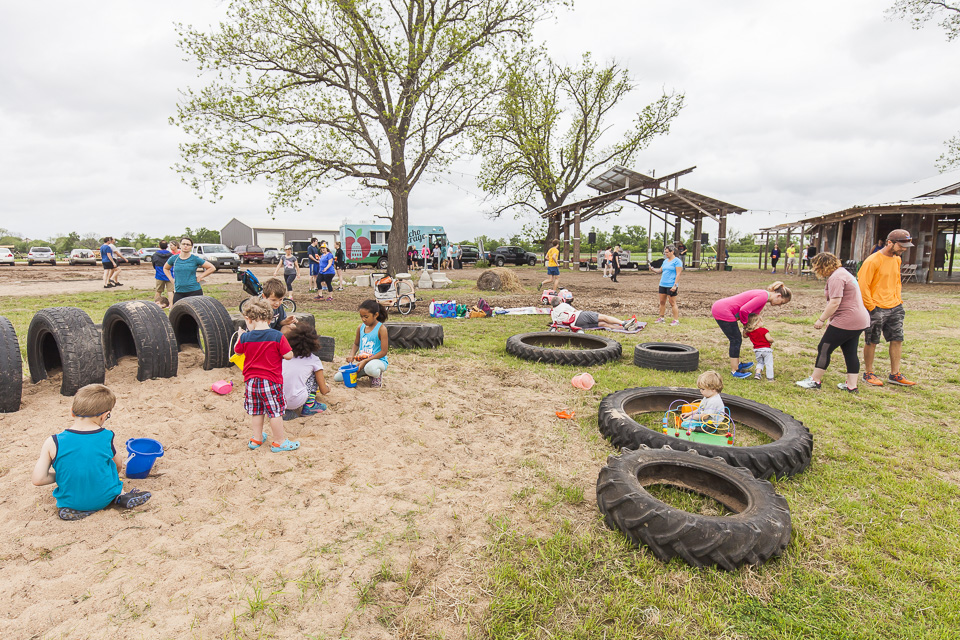 Sand pile good times. Photo by Scott David Gordon.
Sand pile good times. Photo by Scott David Gordon.
The Ginger Armadillo food trailer will be on site serving their delicious "elevated Texas cuisine". Think: BBQ Pork Tacos, Crispy Harvest Cakes, Black Bean Frito Pies, BBQ Beet Fries, Brussels Slaw, Kale Caesar Salad, and Rainbow Slaw! They are slinging only the most delicious fares and featuring our organic veggies as much as possible. Chameleon Cold Brew will be there making sure everyone is caffeinated with free coffee and samples of their notorious cold-brew. They will also be lugging out their giant Jenga tower and cornhole. Yeehaw! This event is BYOB, BYO-picnic blanket, BYO-dancin' shoes, BYO-good vibes. Please DON'T BYO-DOG though! We love your pups, but our farmers prefer you keep them at home. Grappling with heading to market to swoop your weekly veggie haul or to make it out to the event in Garfield? We will have a market stand set up at the event! CSA members, rather pick up your CSA at the Spring Picnic? Shoot us an email at farm@jbgorganic.com or call us at 512-386-5273 and we will get it scheduled. See you at the farm!
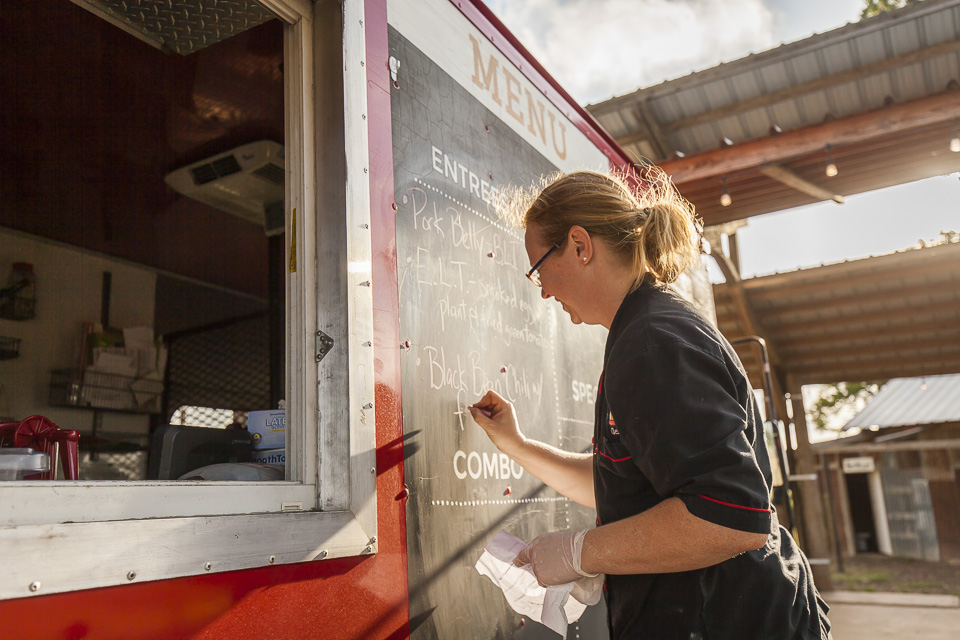 Ginger Armadillo food truck! Photo by Scott David Gordon.
Ginger Armadillo food truck! Photo by Scott David Gordon.
 Gettin' down! Photo by Scott David Gordon.
Gettin' down! Photo by Scott David Gordon.
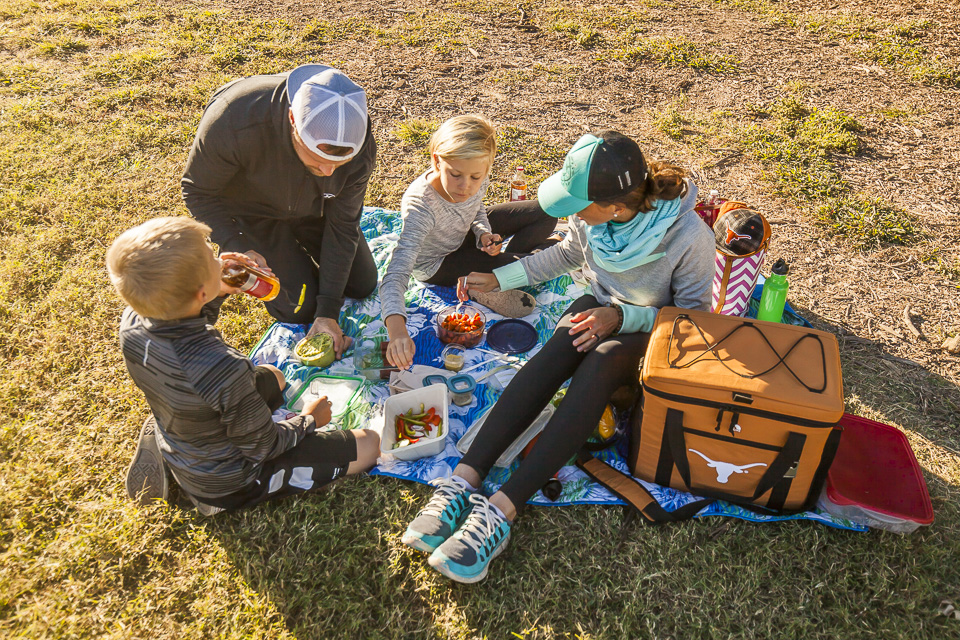 Picnic-in' Photo by Scott David Gordon.
Picnic-in' Photo by Scott David Gordon.
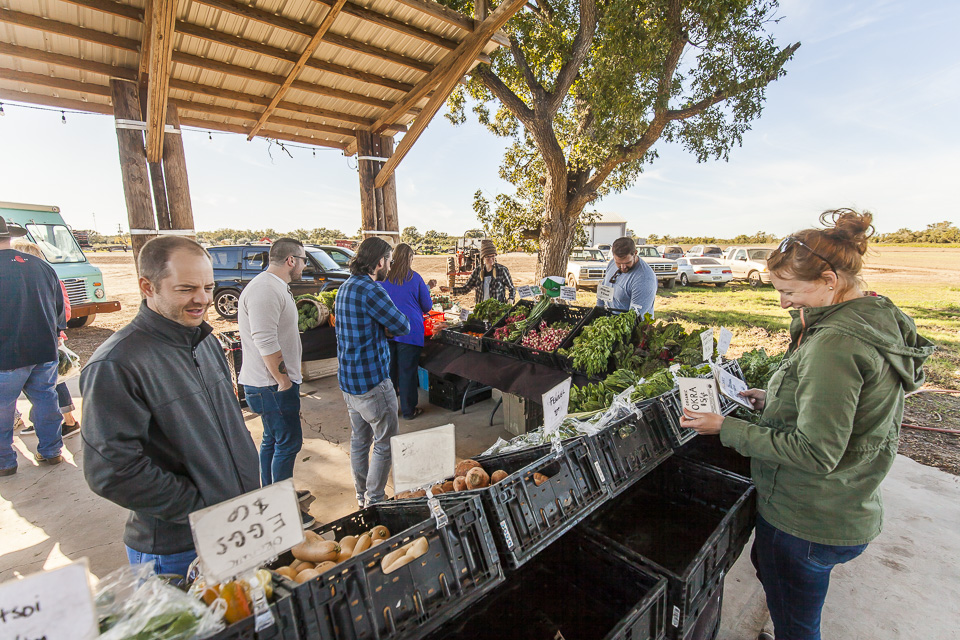 Market stand. Photo by Scott David Gordon.
Market stand. Photo by Scott David Gordon.
CSA BOX CONTENTS WEEK OF MAR 26TH
03/27/18 — Scott
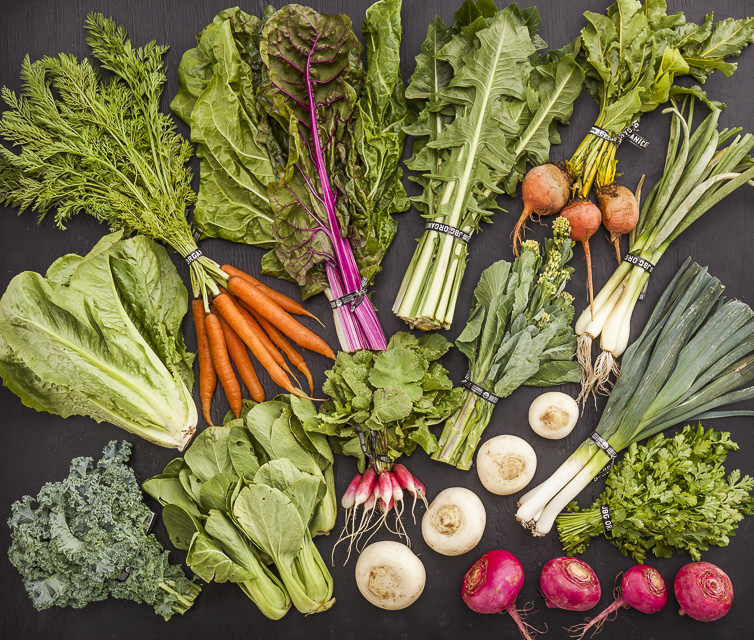 CSA Box Contents Week of Mar 26th
CSA Box Contents Week of Mar 26th
Large Box
Beet, Red
Carrot, Rainbow
Greens, Chard, Rainbow
Greens, Dandelion
Greens, Mizuna
Greens, Salad Mix
Herb, Parsley, Flat
Kohlrabi, Purple
Onion, Spring White
Radish, Purple Daikon
Radish, Red
Turnip, White Japanese
Beet, Red
Carrot, Rainbow
Greens, Chard, Rainbow
Greens, Dandelion
Greens, Mizuna
Greens, Salad Mix
Herb, Parsley, Flat
Kohlrabi, Purple
Onion, Spring White
Radish, Purple Daikon
Radish, Red
Turnip, White Japanese
Medium Box
Beet, Red
Bok Choy, Baby
Carrot, Rainbow
Greens, Chard, Rainbow
Greens, Dandelion
Greens, Spinach
Herb, Parsley, Flat
Onion, Spring White
Radish, Purple Daikon
Beet, Red
Bok Choy, Baby
Carrot, Rainbow
Greens, Chard, Rainbow
Greens, Dandelion
Greens, Spinach
Herb, Parsley, Flat
Onion, Spring White
Radish, Purple Daikon
Small Box
Beet, Golden
Bok Choy
Carrot, Orange
Greens, Spinach
Herb, Cilantro
Onion, Spring White
Turnip, White Japanese
Beet, Golden
Bok Choy
Carrot, Orange
Greens, Spinach
Herb, Cilantro
Onion, Spring White
Turnip, White Japanese
Individual Box
Beet, Golden
Carrot, Orange
Greens, Chard, Rainbow
Greens, Salad Mix
Onion, Spring White
Beet, Golden
Carrot, Orange
Greens, Chard, Rainbow
Greens, Salad Mix
Onion, Spring White
CSA BOX CONTENTS WEEK OF MAR 26TH
03/27/18 — Scott
 CSA Box Contents Week of Mar 26th
CSA Box Contents Week of Mar 26th
Large Box
Beet, Golden
Bok Choy, Baby
Carrot, Red
Greens, Chard, Rainbow
Greens, Kale, Curly
Greens, Mizuna
Herb, Cilantro
Leek
Lettuce, Romaine
Onion, Spring Yellow
Radish, French Breakfast
Turnip, White Japanese
DINO KALE & COLLARD CRISPS
03/29/18 — Heydon Hatcher
Recipe and Photos by Megan Winfrey
There are weeks, they come and go, when cooking actual meals feels like too much of a task for me. I snack too much, go out to eat, Favor in, and the contents of my CSA box sit sadly in the fridge.
When the drive to cook returns, so does the guilt of letting my beautiful produce deteriorate. Luckily I've learned a few tricks for making the most out of them.
Leafy greens turn into savory, paper-thin crisps when baked on low in the oven. They can take a range of seasonings from sweet to spicy, but I like them best with just a drizzle of olive oil and a few cracks of sea salt. Wilted greens may take less time to bake than fresh ones, so just keep an eye on them in the oven!
![]()
Preheat the oven to 300 degrees. Destem the collard greens and cut each half into thirds, making pieces about the size of your palm. I like to leave in the dinosaur kale stems, but if you only have curly kale I suggest removing the stems. Cut the kale into similar sized pieces.
Thoroughly wash and dry the greens. Damp greens won't crisp up as well in the oven. Once dry, put all of the greens in a big bowl. Drizzle with olive oil and crack sea salt over them in an even layer. Mix thoroughly with your hands, rubbing the oil into the crevices of the kale.
![]()
Lay the greens out on a baking sheet. They can be touching, but not overlapping. Bake 10-15 minutes or until dry and slightly browned. Remove from the oven and immediately transfer to a serving dish. Depending on how many bunches of greens used, you may have to bake them in several batches.
Serve immediately - or keep in a brown paper sack up to 3 days.
![]()
There are weeks, they come and go, when cooking actual meals feels like too much of a task for me. I snack too much, go out to eat, Favor in, and the contents of my CSA box sit sadly in the fridge.
When the drive to cook returns, so does the guilt of letting my beautiful produce deteriorate. Luckily I've learned a few tricks for making the most out of them.
Leafy greens turn into savory, paper-thin crisps when baked on low in the oven. They can take a range of seasonings from sweet to spicy, but I like them best with just a drizzle of olive oil and a few cracks of sea salt. Wilted greens may take less time to bake than fresh ones, so just keep an eye on them in the oven!

Preheat the oven to 300 degrees. Destem the collard greens and cut each half into thirds, making pieces about the size of your palm. I like to leave in the dinosaur kale stems, but if you only have curly kale I suggest removing the stems. Cut the kale into similar sized pieces.
Thoroughly wash and dry the greens. Damp greens won't crisp up as well in the oven. Once dry, put all of the greens in a big bowl. Drizzle with olive oil and crack sea salt over them in an even layer. Mix thoroughly with your hands, rubbing the oil into the crevices of the kale.

Lay the greens out on a baking sheet. They can be touching, but not overlapping. Bake 10-15 minutes or until dry and slightly browned. Remove from the oven and immediately transfer to a serving dish. Depending on how many bunches of greens used, you may have to bake them in several batches.
Serve immediately - or keep in a brown paper sack up to 3 days.

WEEK 13 IN PHOTOS
03/30/18 — Heydon Hatcher
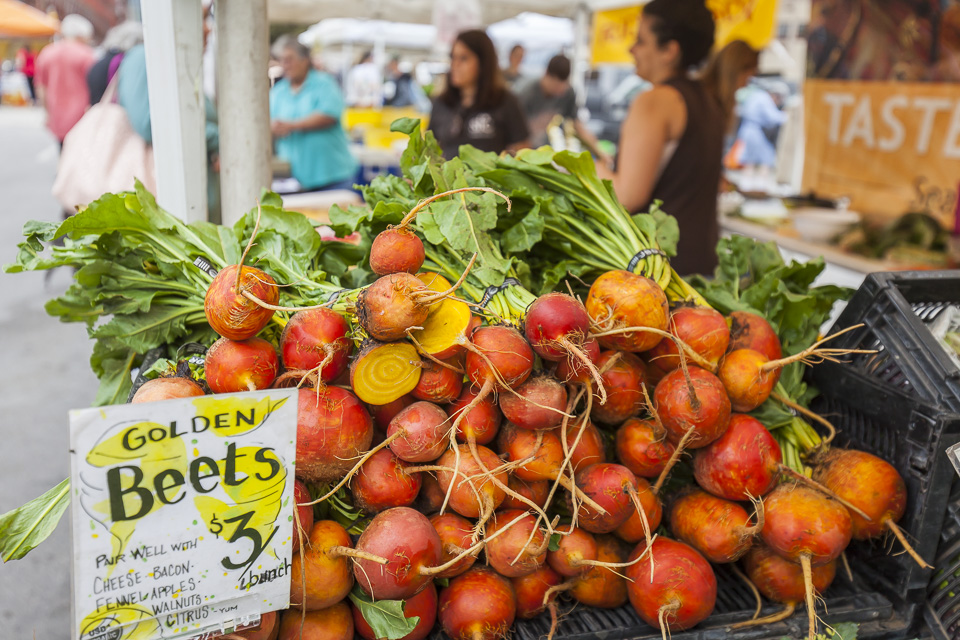 Market beets. Photo by Scott David Gordon.
Market beets. Photo by Scott David Gordon.
We headed to the SFC Downtown Farmers Market this past weekend and fraternized with the folks working and perusing alike. The mid-week rain gave our crops some hydration and gave us a little cool weather reprieve.
The Spring Picnic and Garden Gallop 5K are this Saturday! Have you bought your tickets yet? Check out more info here. Come join in on the fun!
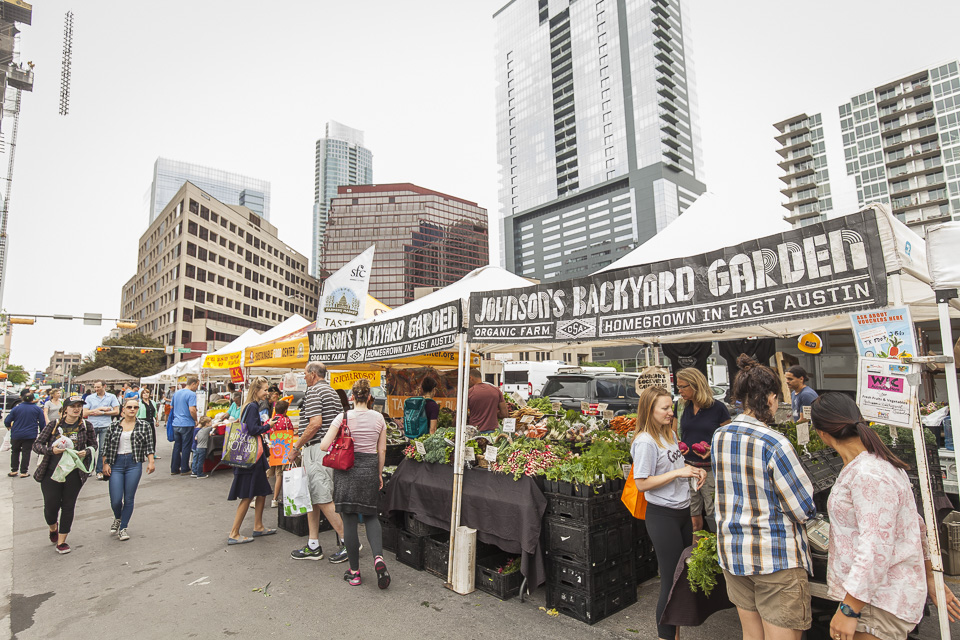 SFC Farmers Market. Photo by Scott David Gordon.
SFC Farmers Market. Photo by Scott David Gordon.
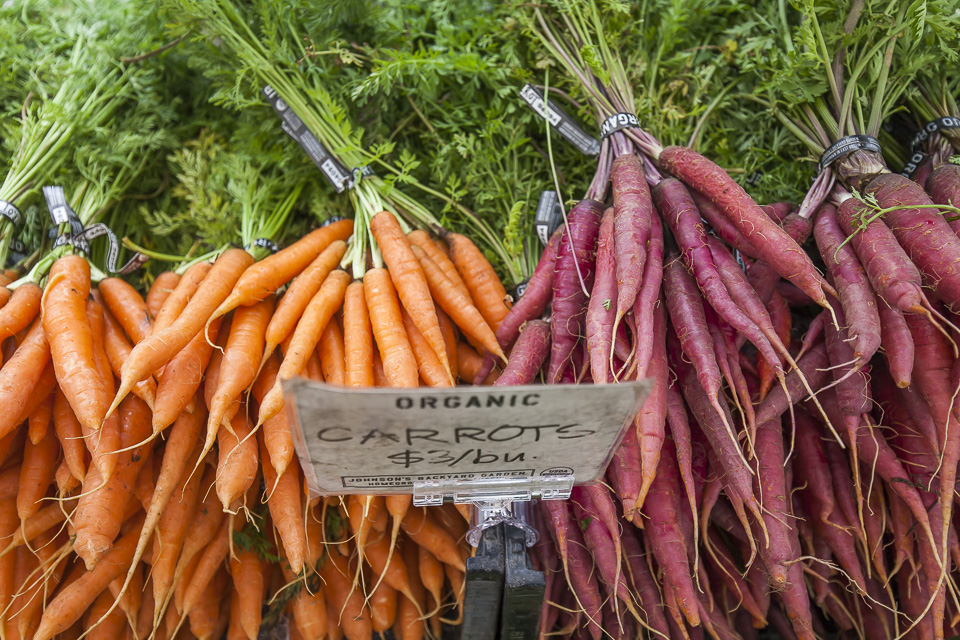 Carrot pretties. Photo by Scott David Gordon.
Carrot pretties. Photo by Scott David Gordon.
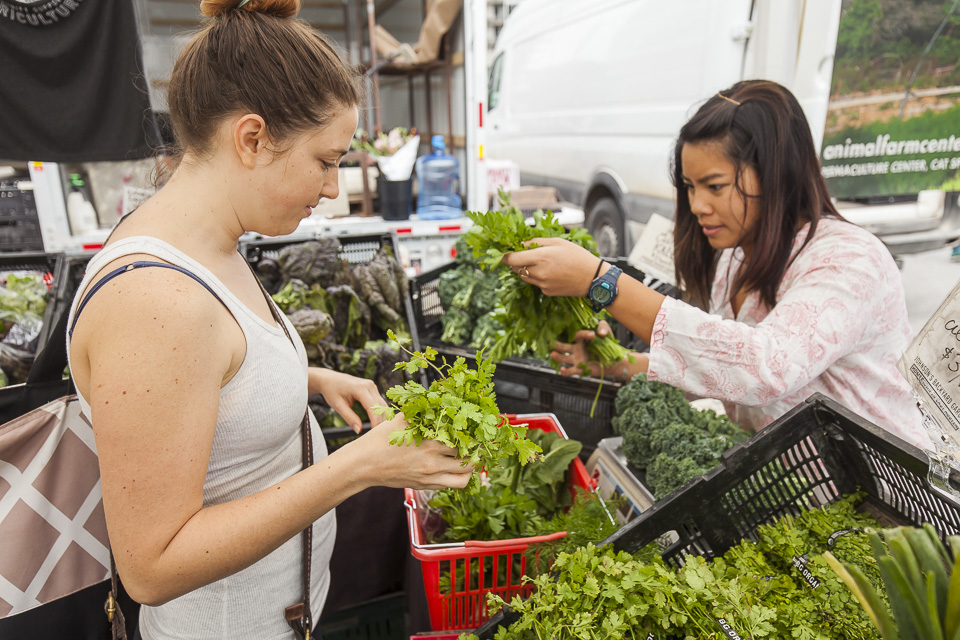 Market talk. Photo by Scott David Gordon.
Market talk. Photo by Scott David Gordon.
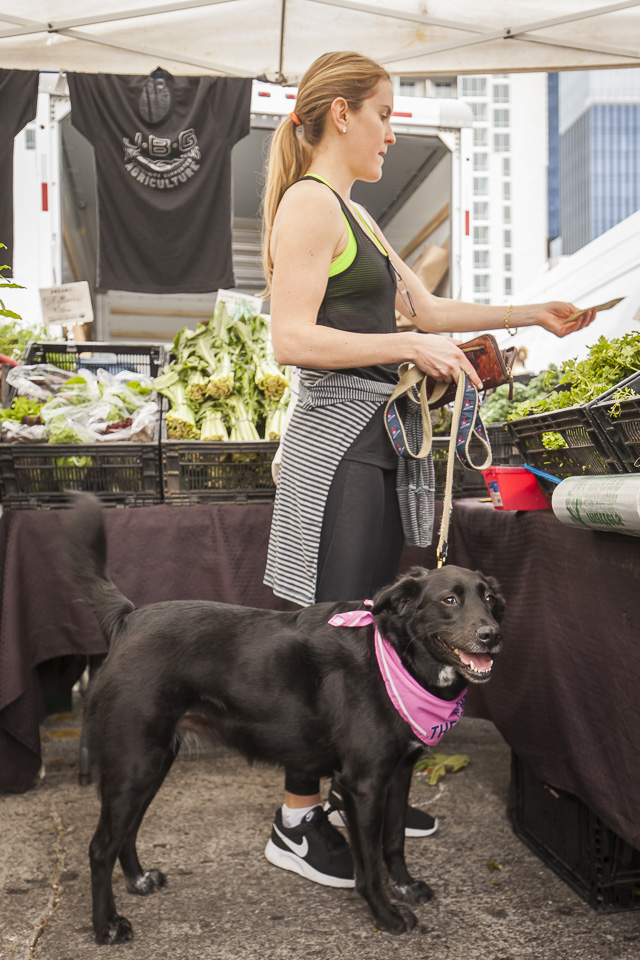 Dogs love veggies, too. Photo by Scott David Gordon.
Dogs love veggies, too. Photo by Scott David Gordon.
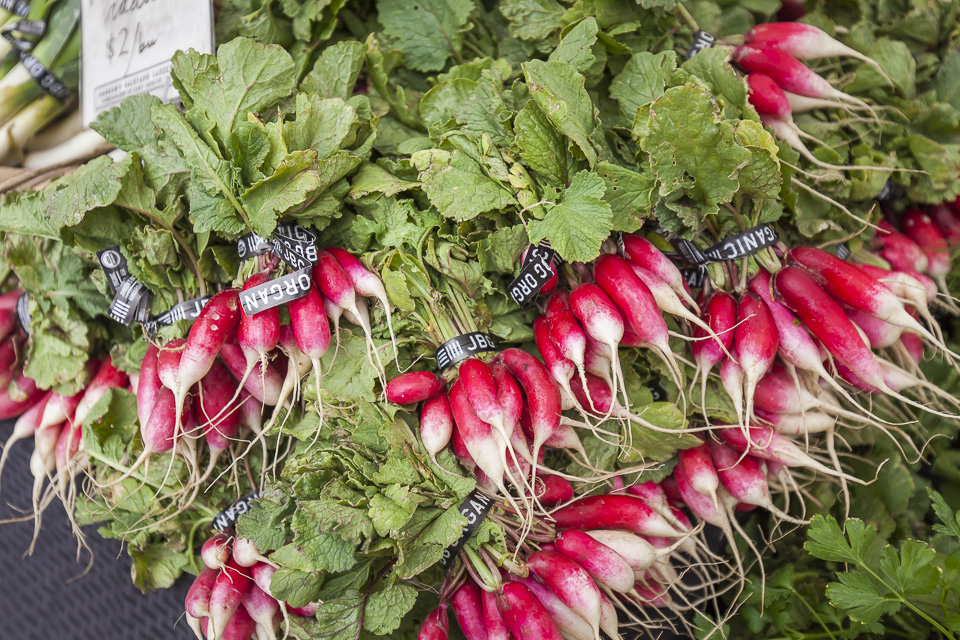 French Breakfast radishes. Photo by Scott David Gordon.
French Breakfast radishes. Photo by Scott David Gordon.
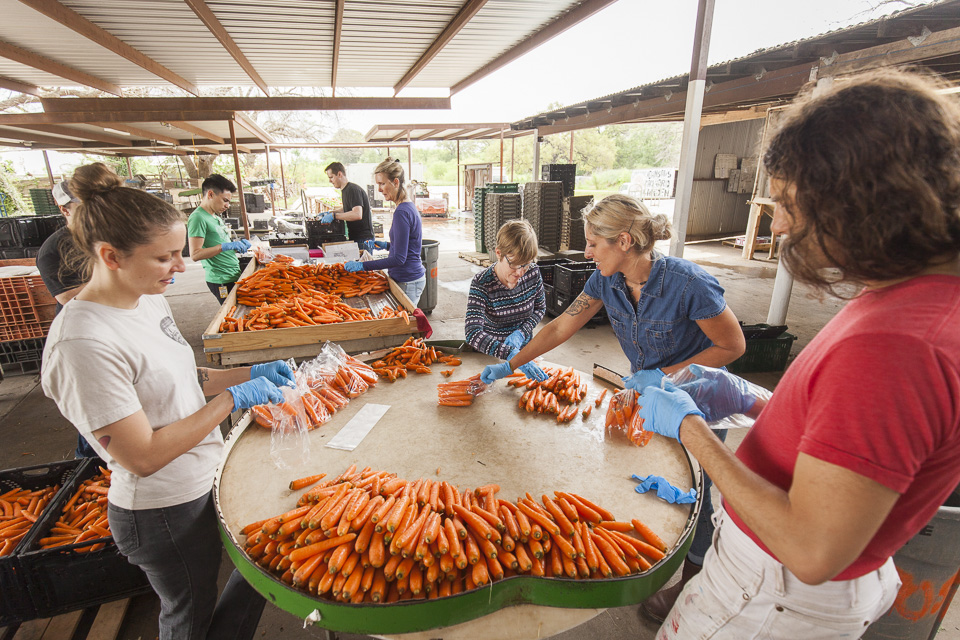 Carrot sorting. Photo by Scott David Gordon.
Carrot sorting. Photo by Scott David Gordon.
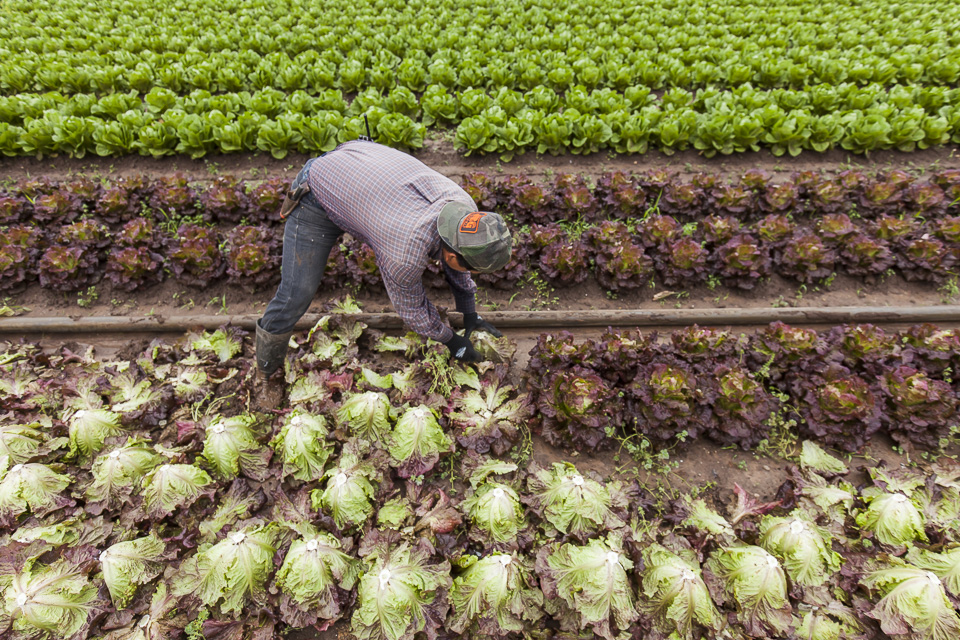 Lettuce harvesting. Photo by Scott David Gordon.
Lettuce harvesting. Photo by Scott David Gordon.
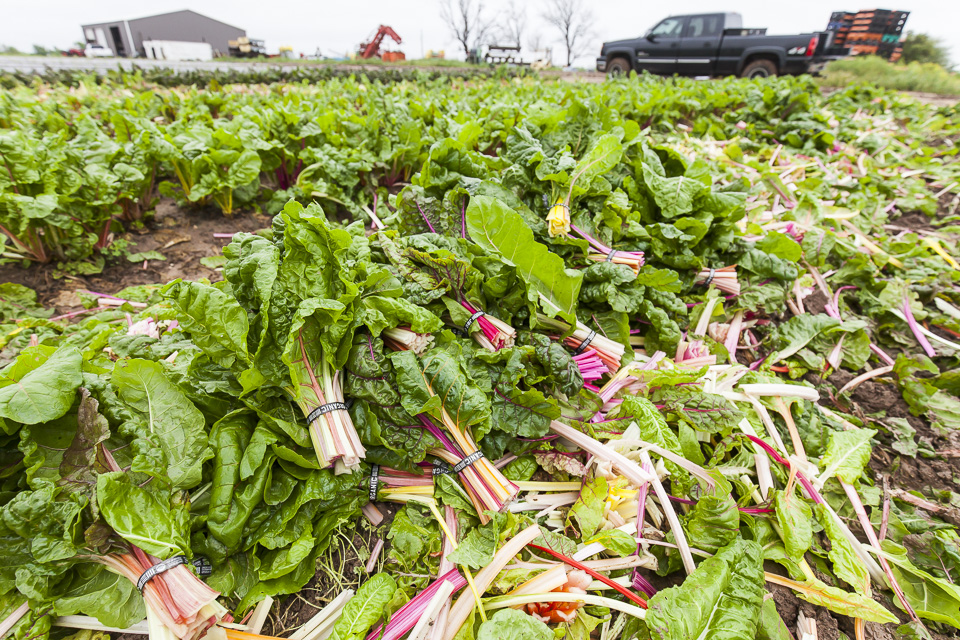 Rainbow chard harvest. Photo by Scott David Gordon.
Rainbow chard harvest. Photo by Scott David Gordon.
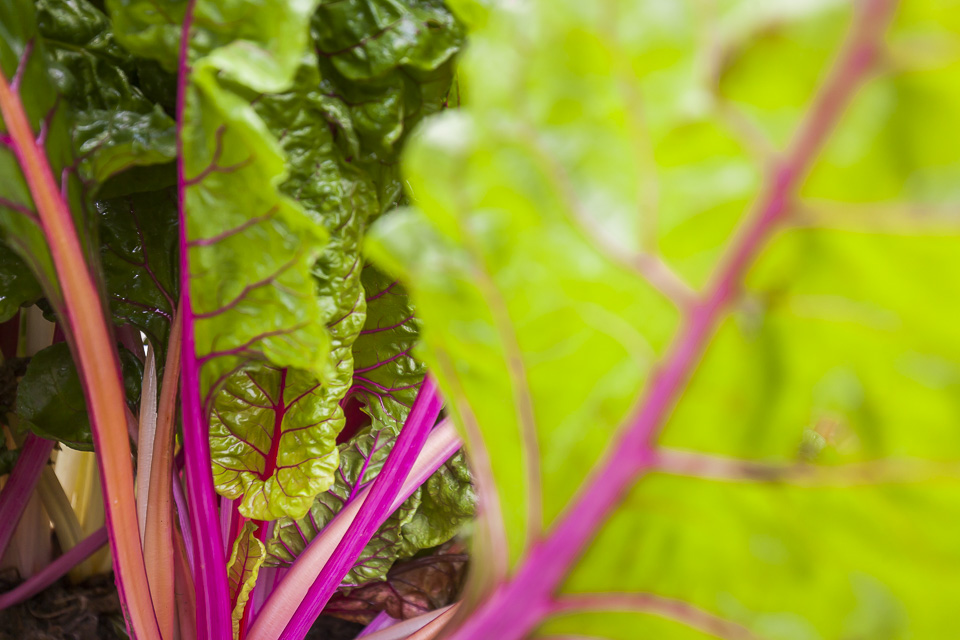 Chard rainbows. Photo by Scott David Gordon.
Chard rainbows. Photo by Scott David Gordon.
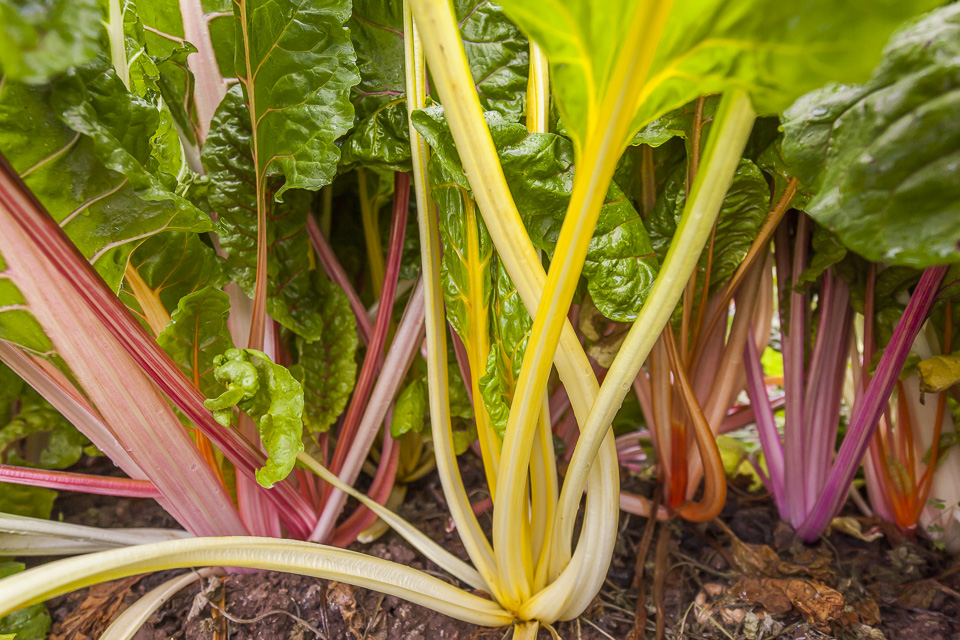 Mellow yellow. Photo by Scott David Gordon.
Mellow yellow. Photo by Scott David Gordon.
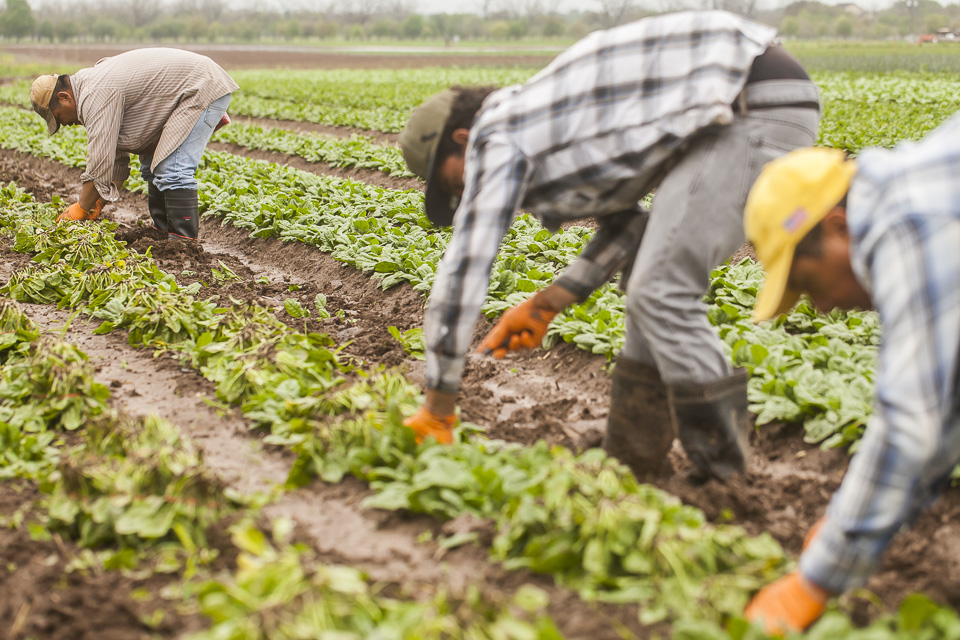 Spinach harvest. Photo by Scott David Gordon.
Spinach harvest. Photo by Scott David Gordon.
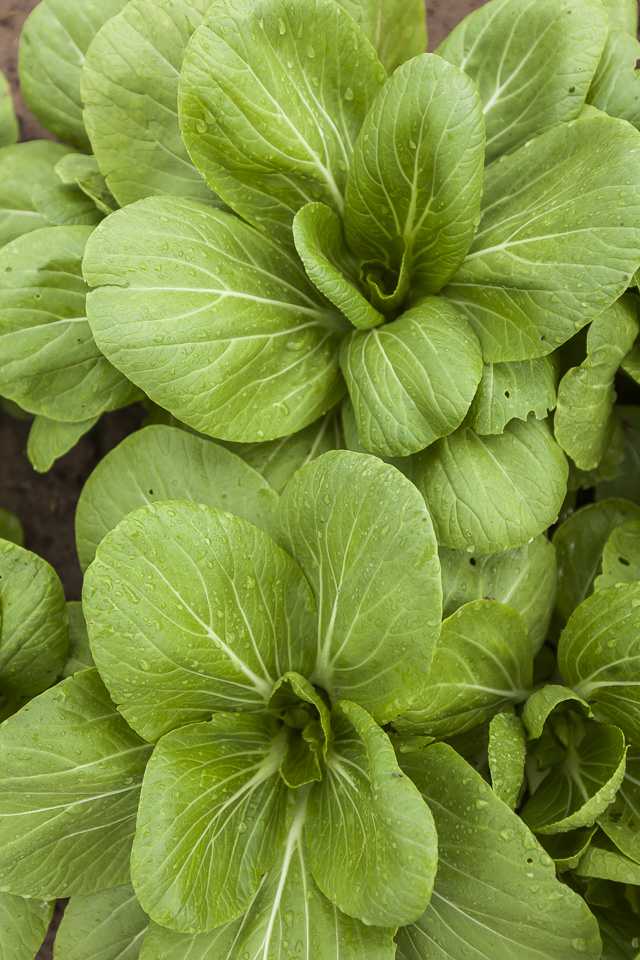 A little hydration. Photo by Scott David Gordon.
A little hydration. Photo by Scott David Gordon.
GUEST BLOGGER: HECTOR ON HIS JOURNEY WITH FOOD
03/30/18 — Heydon Hatcher
By Hector Gonzalez
Hola! Allow me to introduce myself... My name is Hector Gonzalez and I’m the guy that helps the farm with their social media efforts. I started first as a volunteer in 2010 and, after a few visits, I approached then-office manager, Carrie, about JBG’s social media efforts. After we met, she invited Brenton to the chat, and we elaborated about how the farm could share more about what it was and how things were done. At the end of the day, I had a job being their social guy!
I honestly try to keep a low profile and just be a helpful voice for people with questions about JBG. I am grateful and kind to everyone who uses all the farm’s vegetables. I even asked Scott, the farm’s uber-talented photographer, not to include me in the farm’s photos, as I felt I wasn’t interesting enough. That was a lie. I didn’t feel comfortable with my appearance. There was a time I weighed 350 lbs. I felt disgusted with myself.
Last year, I started some changes. You can read some more in this recent article about my journey. Let me be clear about something I learned. Even with having an infinite amount of vegetables available, you can be unhealthy. Part of my new education was learning how to use the farm’s CSA in a healthy manner.
I have no dietary restrictions, although I was vegetarian (2 years) and vegan (1 year) while living in California. I enjoy finding and using flavors in a tasty way. I love to eat and home cooking is the way I love myself and give love to the people I invite over. I don’t eat meat too often as I prefer to see how the vegetables work together. I am not a big fan of fake meat substitutes, either, as I opt to discover different ways to make vegetables. I must say my curiosity has led me to several venues: when I have lots of root vegetables, like beets, radishes, and turnips, I pickle these with miso and sake for a savory treat with sweet notes. When I’m tired of kale chips, I switch to collard green ones. This is one of my favorite new snacks. Recently, I’ve been using greens as a base for salsas, with delicious results in pasta or even tacos.
![]() Watermelon radishes in a dish I made on Valentines Day.
Watermelon radishes in a dish I made on Valentines Day.
These are the things that have worked for me, but might not be your cup of tea. That’s okay! We all have different tastes and loves. Find a way to cook that satisfies you and gives you joy, while also being careful with your health. I truly believe health and happiness are closely related.
Check out more of my recipes/cooking escapades on my Instagram or check out a couple recipes from blogs past here, here, and here!
![]() Photo courtesy of the Austin American-Statesman by Erika Rich.
Photo courtesy of the Austin American-Statesman by Erika Rich.
**Don't forget! The Spring Picnic and Garden Gallop 5K is this Saturday! Get out to the farm for some exercise, exploration, great music, and even better times. Find more info and buy tickets here!**
Hola! Allow me to introduce myself... My name is Hector Gonzalez and I’m the guy that helps the farm with their social media efforts. I started first as a volunteer in 2010 and, after a few visits, I approached then-office manager, Carrie, about JBG’s social media efforts. After we met, she invited Brenton to the chat, and we elaborated about how the farm could share more about what it was and how things were done. At the end of the day, I had a job being their social guy!
I honestly try to keep a low profile and just be a helpful voice for people with questions about JBG. I am grateful and kind to everyone who uses all the farm’s vegetables. I even asked Scott, the farm’s uber-talented photographer, not to include me in the farm’s photos, as I felt I wasn’t interesting enough. That was a lie. I didn’t feel comfortable with my appearance. There was a time I weighed 350 lbs. I felt disgusted with myself.
Last year, I started some changes. You can read some more in this recent article about my journey. Let me be clear about something I learned. Even with having an infinite amount of vegetables available, you can be unhealthy. Part of my new education was learning how to use the farm’s CSA in a healthy manner.
I have no dietary restrictions, although I was vegetarian (2 years) and vegan (1 year) while living in California. I enjoy finding and using flavors in a tasty way. I love to eat and home cooking is the way I love myself and give love to the people I invite over. I don’t eat meat too often as I prefer to see how the vegetables work together. I am not a big fan of fake meat substitutes, either, as I opt to discover different ways to make vegetables. I must say my curiosity has led me to several venues: when I have lots of root vegetables, like beets, radishes, and turnips, I pickle these with miso and sake for a savory treat with sweet notes. When I’m tired of kale chips, I switch to collard green ones. This is one of my favorite new snacks. Recently, I’ve been using greens as a base for salsas, with delicious results in pasta or even tacos.
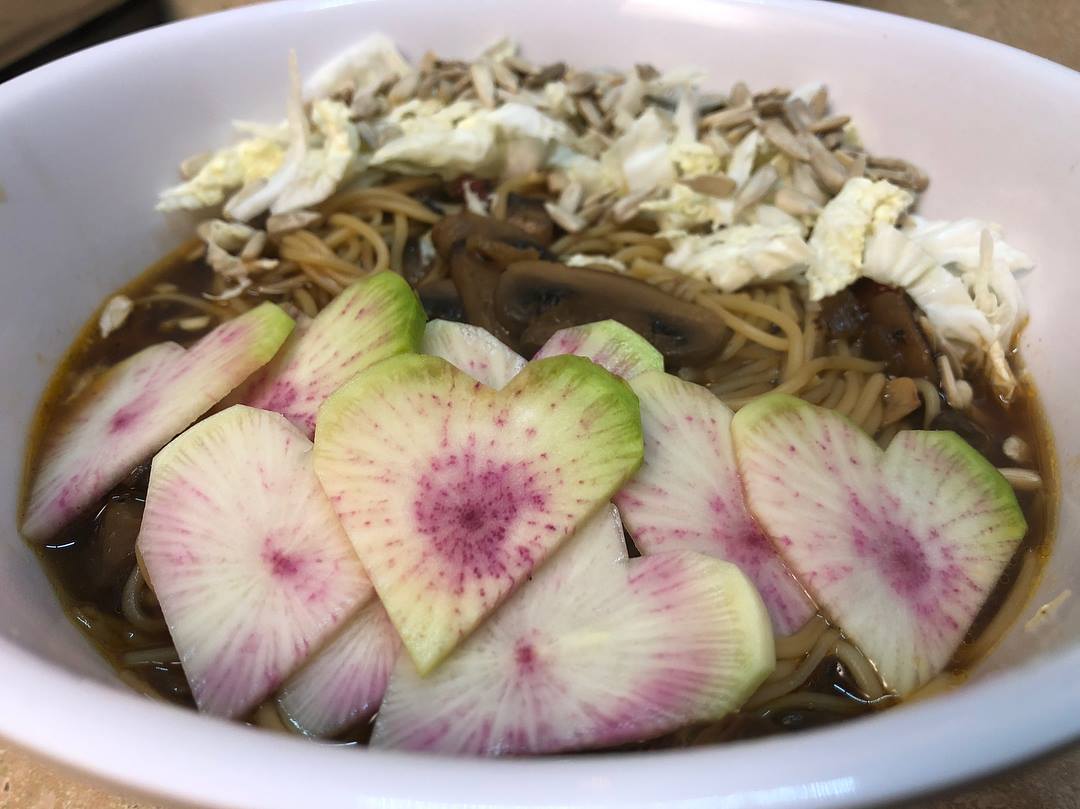 Watermelon radishes in a dish I made on Valentines Day.
Watermelon radishes in a dish I made on Valentines Day.
My vegetable rules
- Try the vegetable raw. Find what I like and dislike about it. Then experiment with the different flavor transformations it can have. How do spices affect it? Which ones make the flavor shine the most? What happens if I leave it outside the fridge overnight? Be curious about the vegetable and be playful with it.
- Broil. I am a big fan of the broil function from my oven. High heat to quickly sear vegetables. One of my favorite things to do is thinly slicing vegetables, then put these in a circular shape, drizzle with olive oil, sprinkle some spices and let the broiler finish the job. Remember to set your timer!
- Vinegar is your friend. The acid factor can REALLY make your vegetables shine in different manners. I love quick pickling fennel and onions overnight in an apple cider solution with a few spices and a dried hot pepper. Another use, while sauteing greens, add some vinegar to the pan and cover for a second, letting that steam infuse the meal.
- Measure yourself. It might seem a bit anal but knowing how much are you eating is quite valuable. It helps you better plan your day and your meals. This in combination with using apps like LoseIt or MyFitnessPal to log the food you consume can help you see what can be improved and how to better eat.
- Be smart about your food. I used to eat every bite from my plate when I didn’t need to. Growing up in Mexico, there were times food wasn’t abundant. I gained this voracity about eating everything and not letting anything go to waste. That’s a mistake. I now portion my meals in a way that I know what I’m cooking, how much and how I’m using my CSA box in a smart and measured way.
These are the things that have worked for me, but might not be your cup of tea. That’s okay! We all have different tastes and loves. Find a way to cook that satisfies you and gives you joy, while also being careful with your health. I truly believe health and happiness are closely related.
Check out more of my recipes/cooking escapades on my Instagram or check out a couple recipes from blogs past here, here, and here!
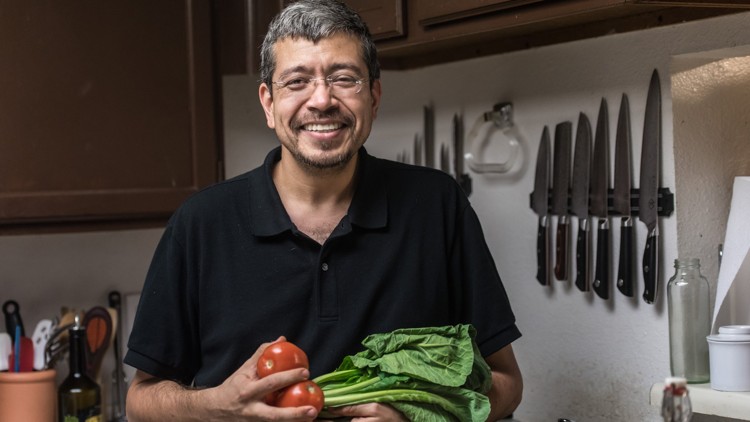 Photo courtesy of the Austin American-Statesman by Erika Rich.
Photo courtesy of the Austin American-Statesman by Erika Rich.
**Don't forget! The Spring Picnic and Garden Gallop 5K is this Saturday! Get out to the farm for some exercise, exploration, great music, and even better times. Find more info and buy tickets here!**






 0 ITEMS IN CART
0 ITEMS IN CART 



